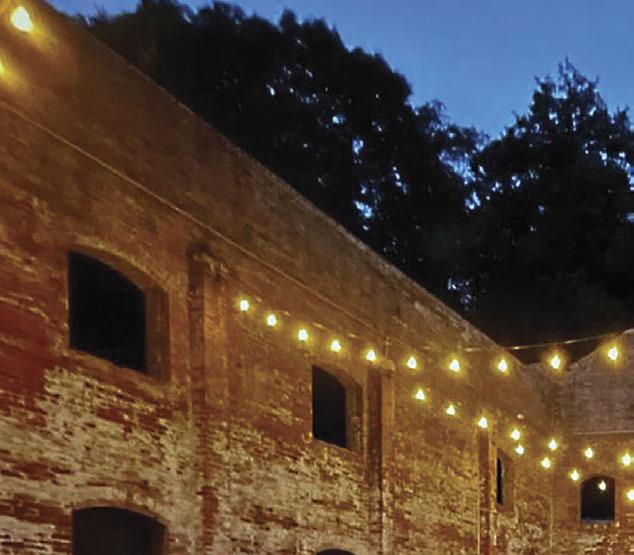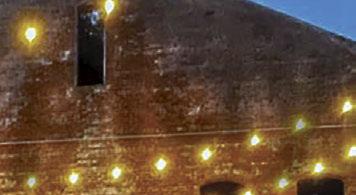











We know some neighbors you’ve never met: the statues, abstract portraits, and curious figures of the Hudson Valley.


Here, you’ll find the most unexpected but exceptional cast of characters at Magazzino Italian Art, Storm King Art Center, Dia Beacon, Art Omi, The Dorsky, and The Loeb. And with the Bloomberg Connects app, you’ll get information about them through behind-the-scenes tours, audio, artist interviews, curated videos, and more in the palm of your hand.
Access these organizations and hundreds more anytime, anywhere—for free. Download now. You never know what—or who you’ll discover next.













6
8
11 Editor’s
14 Craft Beverage: Dassai Blue Sake
18 Restaurant Profile: Oda Wine Bar
Anastassia
22 Sips & Bites
Recent openings and reopenings include Aspire Brewing in Middletown, First Bloom Corner Store in Bloomville, Kitty’s in Hudson, and Cheese Louise in Rhinebeck.
24 Community Nest
Zach Kalatsky’s yurt in Saugerstock was raised by the hands of community and purpose-built for communion.
34 Here to Care: Breast Cancer Treatment
Breast cancer treatment options and support groups abound in the region. Some highlighted resources.
38 Hardest Hikes in the Hudsdon Valley
Our region is home to some of the toughest trails on the East Coast, from Breakneck Ridge to the Devil’s Path.
42 Kingston: Work in Progress
Ulster’s county seat is “affordability-challenged,” but the city and various nonprofits are seeking equitable solutions.
53 Kingston Portraits by David McIntyre














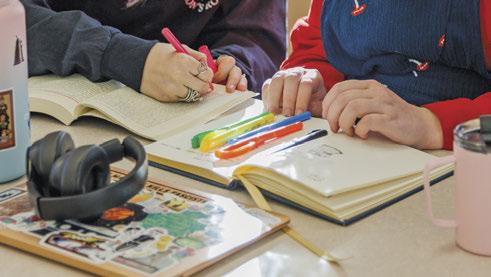





57 Book Reviews
Susan Yung reviews Our Strangers, a new collection of short stories by Lydia Davis. Short reviews of Going for Broke edited by Alissa Quart and David Wallis; More Borscht from a Catskill Mountain Plumber by Alyssa Wishingrad; Immigrant Prodigal Daughter by Lucia Cherciu; and The Mare by Seth C. Martel.
57 Music
Album reviews of Flowering Flows by David Garland; Some Gift by Enablers; and You Are Love and I am You by The Parlor. Plus listening recommendations from Rita Ryan, host of “LocalMotion” on WVKR.
58 Poetry
Poems by Gary Barkman, Augusta Block, Sue Books, Ryan Brennan, Daniel Brown, Tina Dybvik, Brian Gallio, Skye Gilkerson, Heike Jenns, Mike Jurkovic, C. P. Masciola, Lisa Merksamer, Ze’ev Willy Neumann, Nicholas Pagano, Christopher Porpora, Cole Sletten, J Sweet, Patrick Walsh, Diane Webster. Edited by Phillip X Levine.
54 Profile: Hilarie Burton Morgan
Peter Aaron profiles the Rhinebeck-based actor, author, and philanthropist, whose new book, Grimoire Girl: Creating an Inheritance of Magic and Mischief, is a spiritual scrapbook as well as life guide/memoir.
68 Events we’re excited for this autumn include Beacon Bonfire, FilmColumbia, and a staging of “Skeleton Crew.”

73 The Robert Olnick Pavilion opens at Magazzino.
74 Concerts not to miss this fall include Cowboy Junkies, Spiritualized, Patti Smith, and Gregory Alan Isakov.
79 The Local, Saugerties’s newest multi-arts venue, is built out of a restored 19th-century Dutch chapel.
83 Iranian street artist Mirza Hamid exhibits at Basilica
84 “Linda Mary Montano: Art=Healing” and “Shifting Center” are two must-see shows this autumn.
Plus listings of art exhibits from across the region
87 A review of “Text” at Joyce Goldstein Gallery in Chatham.
92 The Venusian Eclipses of October
Cory Nakasue reveals what the stars have in store for us.
96 Cover Story: 30 Years of Chronogram
To celebrate Chronogram’s 30th anniversary, we are exhibiting all 358 covers of the magazine at Time and Space Limited in Hudson, from October 15 to November 12.

Spencer Tunick has been taking mass nude photographs since the 1990s. He began shooting individual portraits on the weekends at sunrise on the streets of New York City but soon found that too many people wanted to appear in his series. “I decided to call everyone on their home phones who wanted to pose for me, invited them, and left messages on their answering machines to meet me on an early morning in the summer of 1994 in front of the United Nations. Twenty-eight people showed up. That was my first group nude,” Tunick says.
Working primarily with people who are not models, taking advantage of the early morning light, Tunick works swiftly. “They are often uncomfortable with being nude for extended periods of time. Plus, it’s chilly in the morning hours. So, I try to communicate clearly and quickly. On a city street, people are really attentive. They are making the work with me,” he explains.
In exchange for participating, Tunick tries to get everyone a print. He has worked with approximately 150,000 people over nearly 30 years.
Locations are a key aspect to Tunick’s work. He has photographed in front of the Opera House in Sydney, Australia; the Zocalo plaza in Mexico City; the high desert of Nevada; the Aletsch glacier in Switzerland, as well a number of shoots in the Hudson Valley. Tunick was born in Middletown.

His work shows the commonality of the human figure and, perhaps, that we are all naked in the face of nature, whether in a cityscape or a landscape. Shooting so many people at once, the human figure becomes abstract, and Tunick thinks of it more as collage, connecting the nude human form to the concrete world. “The groups form an organism or a substance often aligned with performance, color field painting, land art, or environmental
art. I place people to interact with the streets and architecture in a symbiotic way or to push against it in a positive way,” he says.
In contrast, Tunick’s individual portraits tend to be whimsical or fantastical—touching on the symbolist movement in painting or even Dada—but equally as powerful.
After living in Brooklyn for many years, Tunick moved to Suffern, in Rockland County, in 2006 seeking space for his growing family. “We discovered Garner Arts near Suffern. It reminded me of a smaller, more bohemian Mass MoCA. It was exciting, because they were growing and expanding their art program until a flood collapsed their huge main gallery building during Hurricane Irene,” says Tunick. It took some time but they eventually raised the funds to make a new, better, magical, industrial gem of a gallery called Building 35. It’s the art center that could,” he says.
Through November 5 at Garner Arts Center, a retrospective of Tunick’s work, “Naked Pavement,” will be on display, featuring banners, photographs, and video of his installations from around the world. “I’m very honored to be in their new gallery,” he says. “The works I am showing are varied from many journeys around the globe and the American states. They include my first early nude (one-on-one) works shot in black-andwhite to newer mass nude works, made with groups of people on glaciers, in deserts, and posing in the main squares of cities.”
When asked how he wants to be known, he replies, “as an artist collaborating with many generous, brave participants, leading people physically and mentally through a creative journey, making positive artworks in a surreal manner on the edge of reality and fantasy.”
—Mike CobbEDITORIAL DIRECTOR Brian K. Mahoney brian.mahoney@chronogram.com
CREATIVE DIRECTOR David C. Perry david.perry@chronogram.com
DIGITAL EDITOR Marie Doyon marie.doyon@chronogram.com
ARTS EDITOR Peter Aaron music@chronogram.com
HOME EDITOR Mary Angeles Armstrong home@chronogram.com
POETRY EDITOR Phillip X Levine poetry@chronogram.com
CONTRIBUTING EDITOR Anne Pyburn Craig apcraig@chronogram.com
“ONE TREE HILL” EXPERT Samantha Liotta contributors
Winona Barton-Ballentine, Mike Cobb, Ashley Dmitrieff, Melissa Esposito, James Keepnews, David McIntyre, Cory Nakasue, Sean O’Dwyer, Seth Rogovoy, Will Solomon, Sparrow, Jamie Stathis, Taliesin Thomas, Susan Yung
FOUNDERS Jason Stern, Amara Projansky
PUBLISHER & CEO Amara Projansky amara.projansky@chronogram.com
EXECUTIVE VICE PRESIDENT Jan Dewey jan.dewey@chronogram.com
BOARD CHAIR David Dell
sales manager
Andrea Fliakos andrea.fliakos@chronogram.com
media specialists
Kaitlyn LeLay kaitlyn.lelay@chronogram.com
Kelin Long-Gaye kelin.long-gaye@chronogram.com
Kris Schneider kris.schneider@chronogram.com
Sam Brody sam.brody@chronogram.com
Jared Winslow jared.winslow@chronogram.com
marketing
MARKETING & EVENTS MANAGER
Margot Isaacs margot.isaacs@chronogram.com
SPONSORED CONTENT EDITOR
Ashleigh Lovelace ashleigh.lovelace@chronogram.com
administration
FINANCE MANAGER
Nicole Clanahan accounting@chronogram.com; (845) 334-8600
production
PRODUCTION DIRECTOR
Kerry Tinger kerry.tinger@chronogram.com; (845) 334-8600x108
PRODUCTION DESIGNER
Kate Brodowska kate.brodowska@chronogram.com
intern
Ryan Keegan
mission
Founded in 1993, Chronogram magazine offers a colorful and nuanced chronicle of life in the Hudson Valley, inviting readers into the arts, culture, and spirit of this place.
All contents © Chronogram Media 2023. ChronogramMedia.com
WHAT MAKES MADE IN DIFFERENT? It starts with the world’s finest artisans around the world to produce professionalquality kitchen tools. They’ve been perfecting their techniques over generations, and only use the best raw materials, resulting in highperforming, long-lasting pieces across our collections. This curated line of kitchenware is tested by chefs and their expertise helps to ensure that products can withstand the rigors of restaurant kitchens. Finally, Made In controls the entire supply chain to keep prices reasonable. With Made In, the whole experience of shopping for the Kitchen is simple and stress-free. Made In changed the game for both home and restaurant cooks. It’s the reason we stock more items for the kitchen than other stores offer— and why our customers come back year after year.
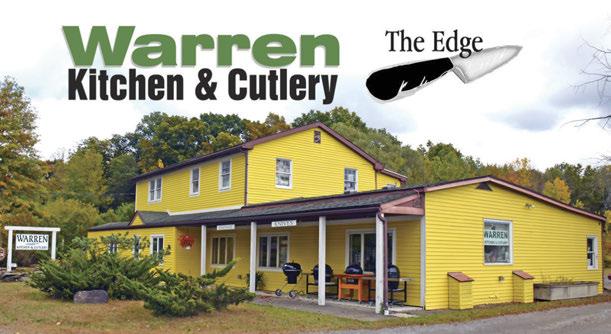
• Unique and rare knives from around the world
• Cookware, bakeware and barware

• Great gifts, and gift wrapping available

Why MADE IN in your kitchen can make your Holidays.
BIODYNAMIC ® FARM | CSA



ON-SITE ORGANIC CREAMERY + BAKERY
ORGANIC NATURAL FOODS + GROCERY STORE
K-12 WALDORF SCHOOL — celebrating 50 years!
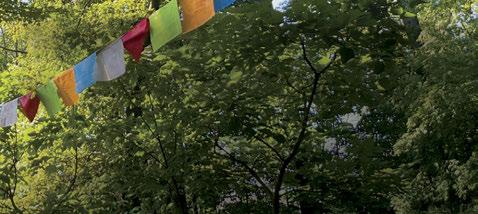
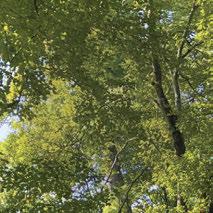
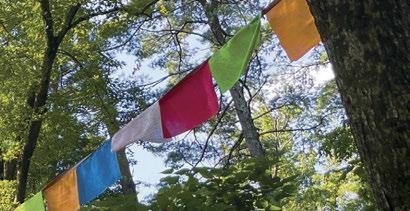
WALDORF TEACHER CERTIFICATION
ECOLOGY WALKS + FARM TOURS



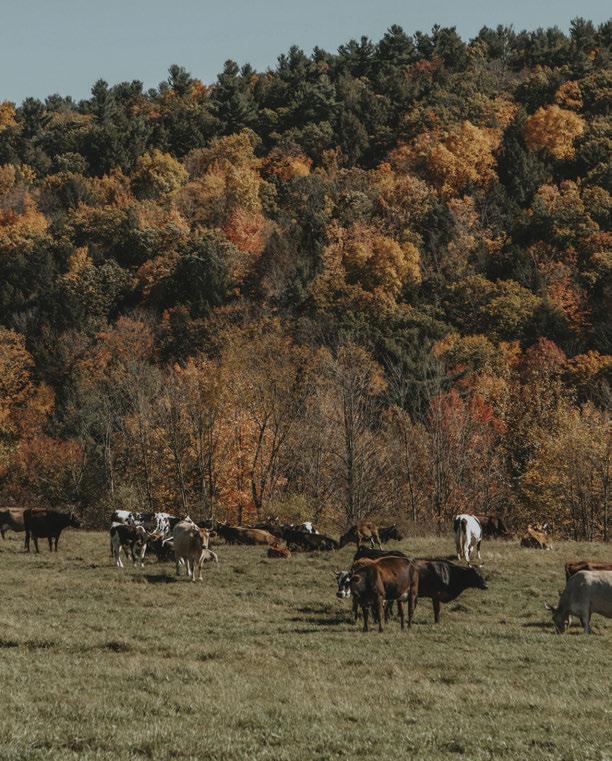
SUMMER FARM CAMP

ARTS EDUCATION + WORKSHOPS
check out our ROOTS TO RENEWAL PODCAST
HARVEST FESTIVAL
SATURDAY, OCTOBER 7 | 10-2
MAKERS MARKET | GAMES | HAY RIDES | MUSIC PUPPET SHOWS | FOOD AND MORE!
HAWTHORNEVALLEY.ORG
esteemed reader by Jason Stern“A person’s worth is measured by the worth of what he values.”
—Marcus Aurelius, 121-180 CEIn Reign of Quantity and the Signs of the Times, the 20th-century French philosopher Rene Guenon wrote that humanity is in the end-throws of an epoch of profound materialism. He described ours as the bleakest period in a long cycle—the final stage of the Kali-Yuga in the Vedic tradition—a dark age in which ignorance is king.
In this age, spirit is absorbed into matter, creating the illusion that matter is all that is real. Though we live in a sea of forces that cannot be measured by physical instruments—pervasive forces of life, sensitivity, consciousness, creativity—our societal worldview steadfastly denies the reality of the invisible. These phenomena, which are the very stuff of direct experience, are considered subjective and unreal byproducts of material processes.
In the present epoch, Guenon suggests, we value only quantitative measurements as indications of reality. This worldview cuts us off from the higher powers and neuters intrinsic harmonics of meaning. The reality of correspondence expressed in metaphor and symbol are shunted to the unserious spheres of the liberal arts and poetry. Our education teaches that what we sense and experience is unreliable and unreal. Only the calculations of indoctrinated experts are to be trusted, even when contradictory to direct experience.
Money is the lingua franca for measuring and assessing value in life. We miss the irony that money is a pure abstraction with no practical value. How interesting that the dollar bill reads “In God we trust” thus advertising that “God” has become “mammon” (materialism). In this sense, as St. Augustine wrote, the Devil is the great counterfeiter, “the ape of God,” substituting the genuinely valuable with worthless abstraction.
Alienated from a direct connection with our own nature, we measure the health of a person on the basis of algorithms counting invisible particles. Gender is untethered from biology. And cut off from the natural world, of which humanity itself is a part, we assess the health of Great Nature by counting parts per million of carbon dioxide in the air.
In the epoch of quantity, democracy is the mode of governance in which the powerful majority always overpowers the weaker minorities and could equally be called “mob rule.” Guenon writes: “It is only in the reign of quantity that the opinion of the majority can claim to be taken into consideration at all.”
In contrast are philosophies transmitted through traditions of the mostly forgotten past when the pendulum tilted in the direction of quality. The current paradigm views the religions, gods, and mythology of ancient cultures as superstitious and ignorant. And yet a careful study reveals that many myths reflect cosmic processes like the movement of celestial bodies conveying a harmonic meaning beyond the simply mechanical. In the ancient pantheons, Gods are cosmic forces available to direct experience—but only through a cultivated attitude of devotion.
We must admit that the materialistic Enlightenment has not led to happiness and harmony in humanity. It is more a mind-virus of collective alienation from self and world. The advent of materialism denuded of spirituality could more accurately be called “the endarkenment” and its influence is nearly exhausted.
Living in the age of bean-counting under the despotic reign of quantity is a desolate existence. It is nihilistic and devoid of meaning and leads human beings to ignorance, addiction, destruction, and personal and collective suicide, for why go on living when one is so cut off from an inherent meaning, purpose, and natural matrix for existence?
Within this context some of us have a shadowy memory or premonition of humanity living in a way that is organized by subtler and higher powers. For those who hear the call, our task is to live inwardly as outsiders in the current age; to have solitude in the crowd; to be guided as far as possible by one’s own pole star of values.
The task, as I see it, is not to reject anything about the current state of the world. Rather it is to guard one’s mind and attention from the flawed premises of the current worldview. We are invited to give attention to the real mystery, the energetic and relational within ourselves and in our human community and in nature. Feed the mind and being with influences arising from a more holistic and less partial view of the world. Find means of connecting to the higher powers and oneself, and work to germinate the seeds of a future humanity here and now.









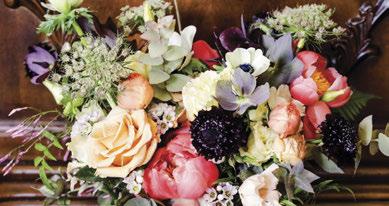










It’s harvest time in the Hudson Valley. In autumns of yore, that would have entailed rustling up a frolicsome crew to go apple picking, heading to a favored pumpkin patch in Linus-like pursuit of an ideal squash, mulling some wine, or cooking vast cauldrons of sauce from the annual overabundance of tomatoes and freezing meal-sized Ziploc bags of the stuff.
(Now I’ve been told that canning is a much more efficient way to preserve fruit and vegetables than jamming a freezer so full of tomatoes that a man can’t even fit a bottle of vodka in there like a civilized person. But I’m afraid of canning, deathly afraid in fact, because I’m sure I’ll screw it up somehow and murder an entire dinner party with a botulism-laced puttanesca. According to the Centers for Disease Control, reported botulism cases in the US are exceedingly rare—only 110 per year—so perhaps my anxiety is ungrounded. However, the Department of Health and Human Services has this to say on the matter: “Improperly canned, preserved, or fermented foods can provide the right conditions for the bacteria to make the toxin. You cannot see, smell, or taste the toxin [my emphasis], but taking even a small taste of food containing it can be deadly.” While everyone might die during dinner, at least the flavor of the puttanesca will not be compromised.)
Ahem.
While the autumnal traditions of bygone days are not forgotten—the apple pie does not bake itself, as Great Aunt Wilhelmina used to say—in our household, the first whiff of cool weather now brings with it fevered anticipation of the big weed whack: the cannabis harvest. We’re growing marijuana, you see. Lots of it. In pots on our back deck. Big plants, taller than a tall plant should be and thick with buds. It’s our second season, and we’re very excited. (We used to get this giddy over tomatoes: gazpacho, pan con tomate, etc. Once we

move on to cultivating hallucinogenic mushroom spores, I’m sure we’ll feel similarly blasé about pot plants.)
And just so you know: It is illegal to grow weed in New York State. According to the letter of the law—the law being the Marijuana Regulation and Taxation Act (MRTA) of 2021, signed by dearly departed Gov. Andrew Cuomo—homegrown marijuana is not allowed until the first adult cannabis dispensary has been open for 18 months. The first legal dispensary, Housing Works Cannabis Co., opened in the East Village on December 29 of last year, which means legal growing won’t start until somewhere around June 29, 2024. As everyone knows, this has stopped absolutely no one, just as a lack of dispensary licensing has not halted the illegal pot shops in New York City from popping up like so many, well, weeds. (In April, Gov. Kathy Hochul estimated that there were 2,500 black market storefronts operating in the five boroughs.)
If for some bizarre reason you do want to stay on the right side of the law, despite the fact all your friends and neighbors are green thumbing it, know this: You’re allowed to cultivate a total of six plants, consisting of three mature and three immature plants; up to 12 plants per residence. And you’re allowed to process and store—“securely” according to the MRTA—up to five pounds of weed at home. Oh, and wait until after next June to get started. (A hypothetical: What happens if I “accidentally” grow more than five pounds of weed? Let’s say I grow six pounds, what then? Will there be collection facilities set up in our communities—I’m thinking something akin to a used clothing drop box—where we can deposit excess tonnage? Will there be spot home inspections by the Weed Police?)
We’re growing three plants this year. Their names are Lady Rossmore, Hildegard, and
by Brian K. MahoneyEdwina, collectively known as the Girls. (And yes, we’re sure they’re females; it says so in their email signatures.) We’re currently a tad anxious about the Girls, as marijuana plants want to be kept pretty dry once they start budding, and it’s been raining all the time. In high-moisture conditions, bud rot can set in, and that’s no bueno. So we find ourselves clustering the Girls as best we can underneath a shade umbrella and then running out to shake them of excess water once the rain stops. We’ve become quite invested in the wellbeing of these plants. I wish I could say the same for the bougainvillea or the Japanese maple.
And here’s the mystery at the heart of it all: We don’t even get high. (I had originally written “we don’t even smoke pot,” as smoking was the way, nearly the only way, to get high since time immemorial, since aliens came down and built the Pyramids and gave weed to the Egyptians 4,000 years ago.) I used to get high all the time, multiple times a day, when I was in my 20s. I don’t think there was a thing I did where I wasn’t high. School, work, church, dentist: I did it all high. Family reunions and final exams. Making bongs out of household items? I was a regular MacGyver. Stealing screens out of all the faucets? Guilty as charged. Bongwater coffee? I drank it. (Not recommended: zero out of five stars.) A man whose goal in life was to get high in all 50 states: Not me, but I roomed with that guy. Where are you now, Dan Goodfriend? I hope you’re still out there chasing your elusive dream.
And then one day I just wasn’t into anymore, like Hacky sack. I can’t explain it. Now, with the frisson of illegality gone, it doesn’t seem nearly as cool to get high either. Outlaws don’t buy vape pens. It seems way cooler to obsess over a few plants. And the weed doesn’t even need to be canned. It just sits in jars without killing anybody. And there’s room in the freezer for the vodka.
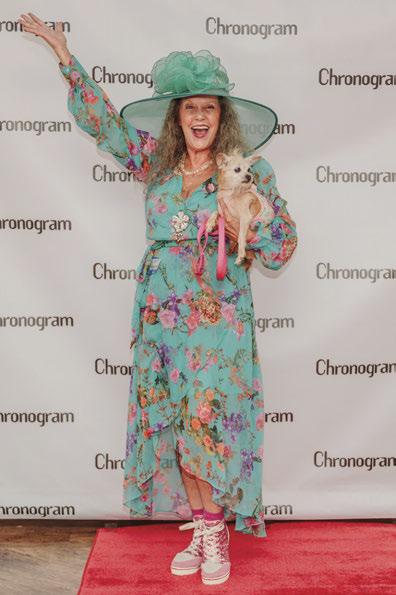



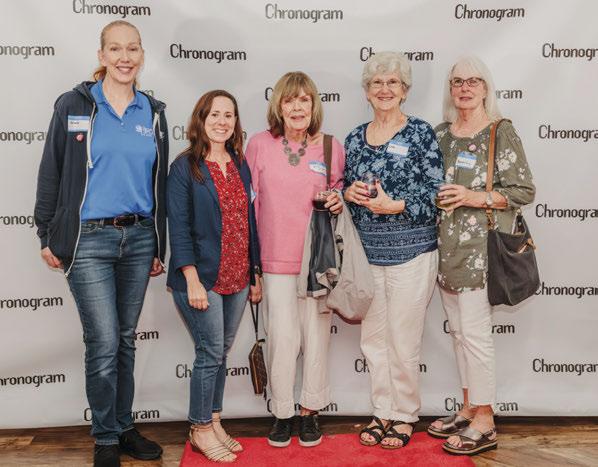
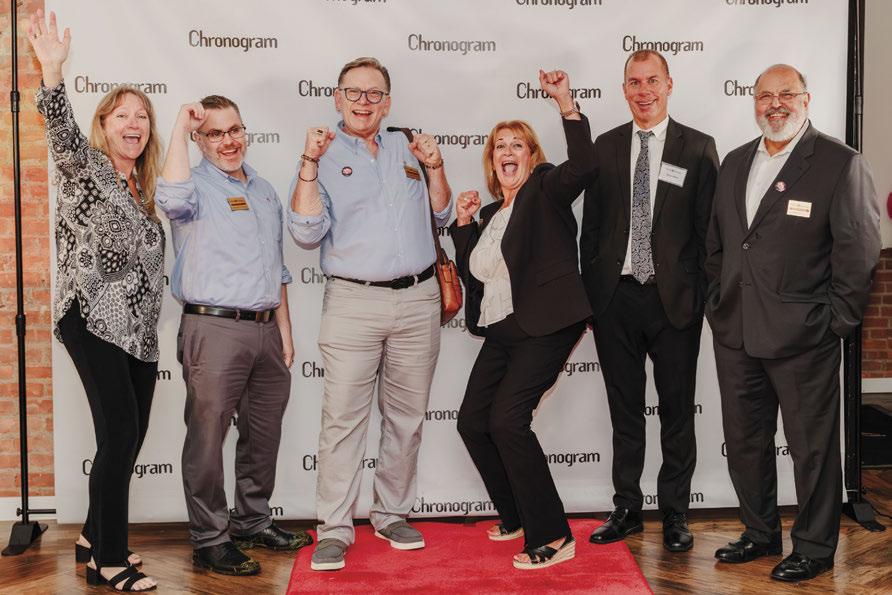
On August 24, Chronogram hosted its first-ever Chronogrammies party at Hudson House and Distillery in West Park. Over 350 people— including many proud 2023 Chronogrammies winners—showed up despite the rain for an unforgettable night celebrating the creative people who make the Hudson Valley absolutely amazing.

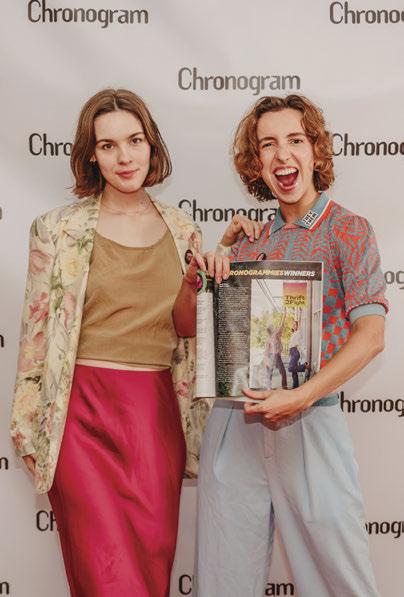



The Stephen Clair Band rocked, DJ RedLion pumped up the jams, and the staff of Hudson House kept the food and drink flowing. Congratulations to all the Chronogrammies winners and thanks to all who made it a magical night.
Special thanks to our exclusive sponsor for the evening, Ulster Savings Bank, and a tip of the cap to our nonprofit partner, the Ulster County SPCA, which received part of the evening’s proceeds.
Here are some images of the event by indefatigable photographer Ashley Dmitrieff of Stellar Films &
Many more photos from the event are posted online at Chronogram.com/chronogrammiesparty.
The Hudson Valley is no stranger to the craft beverage industry, with wineries, distilleries, and breweries in seemingly every pocket of our verdant Valley. But sake has largely remained an untapped market, often relegated to beverage menus at sushi joints or hibachi restaurants— intimidating to the unacquainted tongue. Craft sake, however, pairs well with food, and can often be seen as a substitute for white wine. For example, a premium sake might feature crisp, fruity notes that melt into a lingering buttery mouthfeel, complementing French favorite Coquilles Saint-Jacques just as well as a Chardonnay.
As Japanese breweries eye international markets, craft sake has been having a moment in the US, seeing slow-yet-steady growth in demand and sales. According to Japanese Sake and Shochu Makers Association, exports of sake to the US more than doubled in little over a decade, going from four million liters in 2011 to over 10 million liters in 2022. And with the opening of Hyde Park’s brand new $85 million sake brewery, Dassai Blue—located just up the hill from the Culinary Institute of America and right down Route 9 from foodie-haven Rhinebeck—it’s the perfect time to shine a light on the nuances and versatility of this ancient beverage.
The Sakurai family of Japan chose Hyde Park as the location to host the first US-based operation of their hugely successful sake brewery, Asahi Shuzo, best known for its high-end brand, Dassai. After five years of planning
and building, including a year-and-a-half setback due to the pandemic, the Dassai Blue Brewery is expected to open to the public late October for tastings and tours.
“We chose the Hudson Valley because it’s a beautiful area with a growing interest in craft sake,” says company Chairman Hiroshi Sakurai, through a Japanese translator. “By establishing ourselves here, we can understand American culture, and Hudson Valley culture, and incorporate them both into our process of making high-quality beverages.”
Although the Hyde Park location is a much smaller operation than the Japanese brewery, it’s a state-of-the-art facility that can produce up to 140,000 cases each year. Even though Dassai is the 10th largest sake brand in Japan by volume, they still utilize traditional methods passed down for generations— the brewery’s origin dates back to the 1700s in the Yamaguchi Prefecture of southern Japan, where it’s still located. In 1948 the Sakurai family took over the brewery and dubbed it Asahi Shuzo; nearly 40 years later, in 1984, Hiroshi Sakurai became the third-generation CEO and focused the company on producing high-quality, small batch sake; this catapulted the business from rural brewery into international acclaim. In 2015, Hiroshi stepped into the role as chairman, allowing his eldest son, Kazuhiro, to become the fourthgeneration CEO. As of last year, sales grew to $118 million USD, making Asahi Shuzo the fourth-highest grossing sake brewer in Japan.
“There are a few reasons for this steady growth,” Sakurai explains. “One is because we have a heavy focus on the customer, producing more of what

customers prefer to drink. Another reason is because Japanese culture has shifted, both because women have started drinking more sake, but also because the culture is becoming less about drinking and more about tasting. In the US, there has already been a tasting culture, such as with wine and spirits, and now more people are trying sake. It’s been slow changes over the past few decades, but these shifts are noticeable.”



Dassai Blue’s Hyde Park campus is spread among three buildings: a ricepolishing facility, a wastewater center, and the brewery and tasting room. The company employed Japanese architect Jun Mitsui, who is known for designing high-rises and corporate buildings in Japan like Haneda Airport’s international terminal and the headquarters of Coca-Cola Japan. Mitsui collaborated with American architectural firm CPCA, who helped with understanding US laws and regulations. “We started building in 2018, and finished May 2023,” Sakurai says. “We made a lot of changes over that time to ensure we created the best version of the design. The building features elements of Japan, as opposed to having a more industrial look, because we wanted it to become a landmark in Hyde Park” he says.
For a little insight into sake-making, the beverage is made from rice, water, a fungus called koji, and yeast. It takes about 120 days to go from grain to glass. Different types of rice produce their own flavors, and Asahi Shuzo only uses Yamada Nishiki sourced from farmers in the Hyogo Prefecture—a region famous for producing durable, flavorful rice. “We also have an annual contest for Yamada Nishiki farmers around other parts of Japan, and we use the winning rice to make a very exclusive type of sake,” Sakurai says. “And we offer a cash prize. For the first contest, the winner took home $200,000. This year was our fifth contest and the prize was up to $300,000.” In 2022, some of the sake created from the winning rice was put into auction through Sotheby’s; one 720 mL bottle sold for nearly $8,000.
The brewing process begins with polishing rice grains down to a fraction of their size; the more a rice grain is polished, the richer and more delicate of a taste it can provide. When rice has been milled by 50 percent or more, it’s considered to be the highest grade for sake-making, known as Junmai Daiginjo.
All Dassai products are considered Junmai Daiginjo and typically named after the amount of grain that’s left behind after milling. For example, one of the brewery’s most popular beverages is Dassai 23. For this, 77 percent of each rice grain is polished away, leaving 23 percent of its original size. The Dassai 23 sake was first introduced in 1990 and grew so popular in Japan that it became the first-ever sake offered at a White House Banquet in 2015—former President Obama wanted to surprise the prime minister of Japan with a high-quality sake, and Dassai 23 was chosen for the honor.
Once rice is polished, it’s then washed before being steamed. During washing, gray water is sent through a state-of-the-art wastewater facility located behind the brewery. A cool $7 million was spent on this treatment center. “The water that goes through here flows into the Hudson River, so we wanted to make sure that the water is filtered clean, as part of our commitment to sustainability,” he says. “It’s actually filtered so cleanly that the water we’re putting into the river is making the river cleaner. The official who came to approve the facility said it was the most beautifully made wastewater building he’s seen.”
Next, the rice goes into the koji room for a traditional application of the fungus—which is technically a type of mold, and the key element to providing sake’s notes of pear and fruit. Visitors who opt for a tour of the brewery can view this room through a window, and might be lucky enough to witness the process, during which the rice is spread evenly on flat tables and a koji crew enact coordinated shaking of spores while slowly marching around each table; it’s a captivating ceremony to watch. Once koji is applied, the rice is kept at a temperature just low enough to not kill the fungus, but also to not allow it to feed; this process is what encourages the fruity, elegant aroma.
Last, the rice is put in fermentation tanks for 30 days, before bottling and pasteurization. “Even though it’s a large production, craftsmanship by hand is still very important,” Sakurai says.
At opening, Dassai Blue is starting out by offering three beverage options: Dassai Blue Type 23, Type 35, and Type 50. In the beginning, they’ll be made with Yamada Nishiki rice brought over from Japan, but they will eventually use Yamada Nishiki grown from a farm in Arkansas that Sakurai says uses the same traditional methods and will uphold the same expected quality.
It’s worth noting that the original Dassai 23 will taste slightly different from the Dassai Blue Type 23. The former is described in tasting notes as “smooth, refined, light, long finish, with elegant sweetness” whereas the latter features an “elegant and glamorous fragrance with complex and powerful flavor.”
Dassai Blue sake will be available first solely at the brewery and taproom, and eventually at restaurants both locally and in New York City. The taproom will also have a few food options—mainly small plates, like a traditional cheese plate or Japanese charcuterie with vegetables sourced from local farms. The brewery is also hoping to work with local farms to provide leftover mash as animal feed or potential beauty products, as is traditionally done in the
Japanese operation.
And Sakurai will oversee it all. “I’ll be living both here and in Japan in the beginning because I want to help ensure that Dassai Blue maintains the same quality expected from Dassai in Japan—not just in terms of making sake, but also our commitment to sustainability and community,” Sakurai says. He notes that this is why the local brewery features the addition of Blue in the name—it stems from a Japanese proverb that translates to: “Although blue dye comes from the indigo plant, it is bluer than indigo,” conveying the idea of the student becoming the master. The proverb aligns with the company’s goals of having Dassai Blue eventually match the success of its Japanese counterpart.
“It’s not just about following tradition, but about always producing better sake,” Sakurai says. “Our production teams are hungry to make better sake, and want to revolutionize sake making. They’re not afraid to try something different. We’re still based in tradition, but we build from there.”
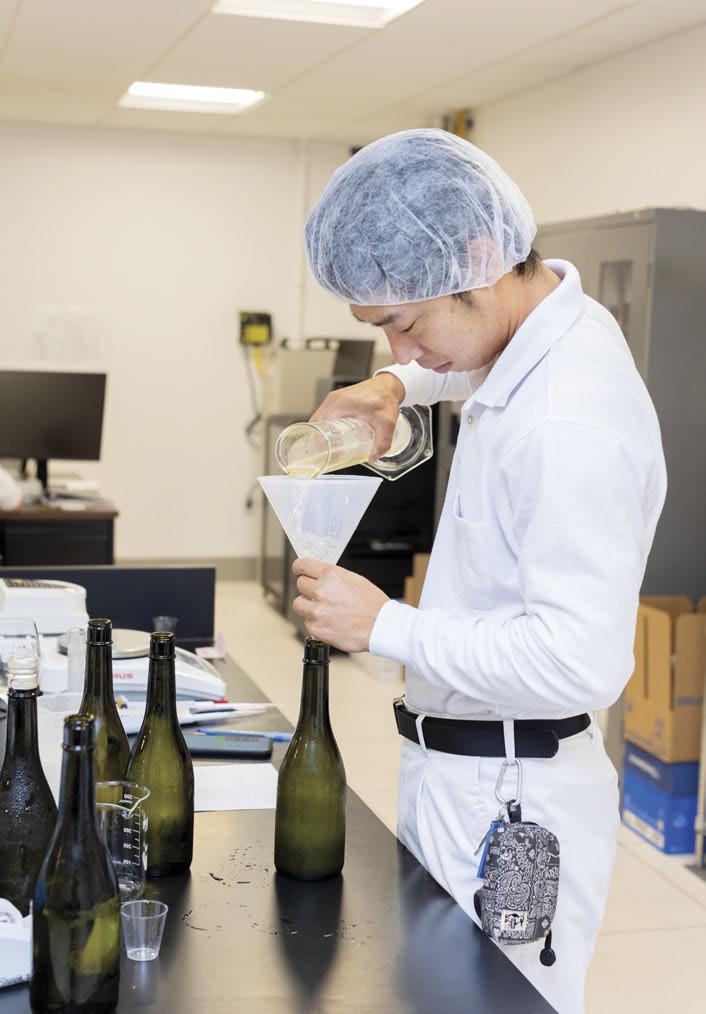
Dassai Blue, 5 St. Andrews Road in Hyde Park, plans to be open to the public by the end of October. View their website for updates: Asahishuzo.ne.jp/dassaiblue.
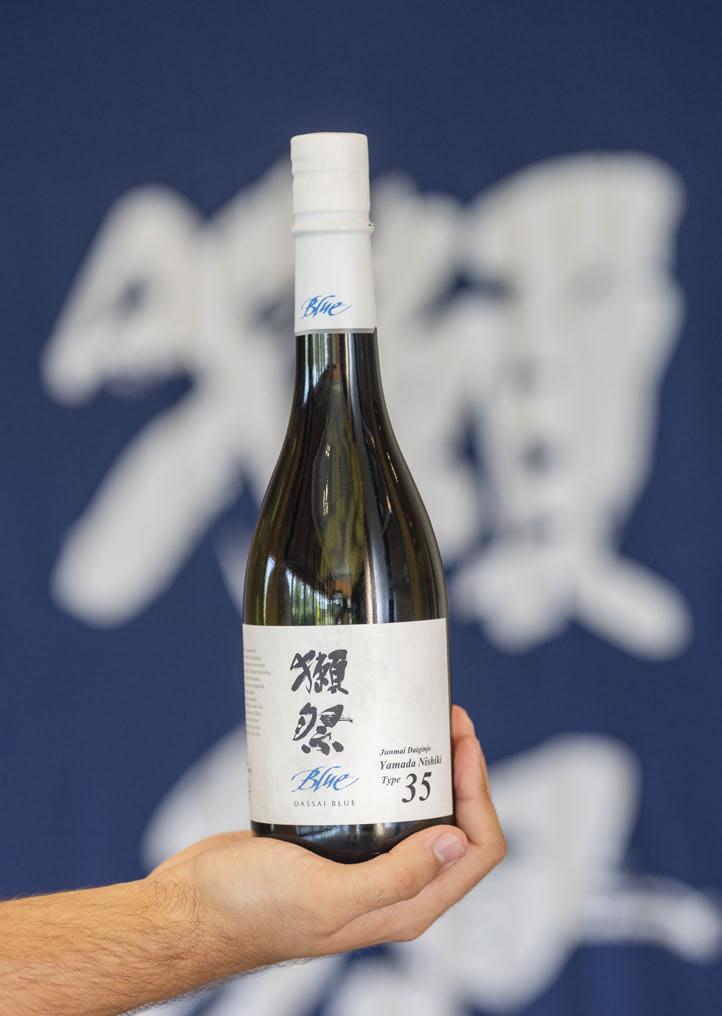









































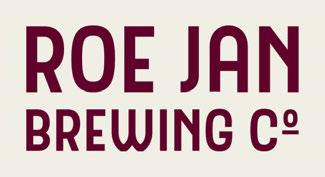






Iremember the first time I learned about amber wines from the nation of Georgia. Whereas most “orange” wines I had encountered felt a bit like the producers were just hopping on the skin-contact-natural-wine bandwagon, learning about how the family-owned vineyards in Georgia fermented their amber wines in buried clay amphoras called qvevri felt positively ancient, in the best kind of way.
That’s because the art of making traditional Georgian amber wines goes back over 5,000 years, with archaeological evidence that points to the country as one of the oldest—if not the oldest—winemaking regions in the world.
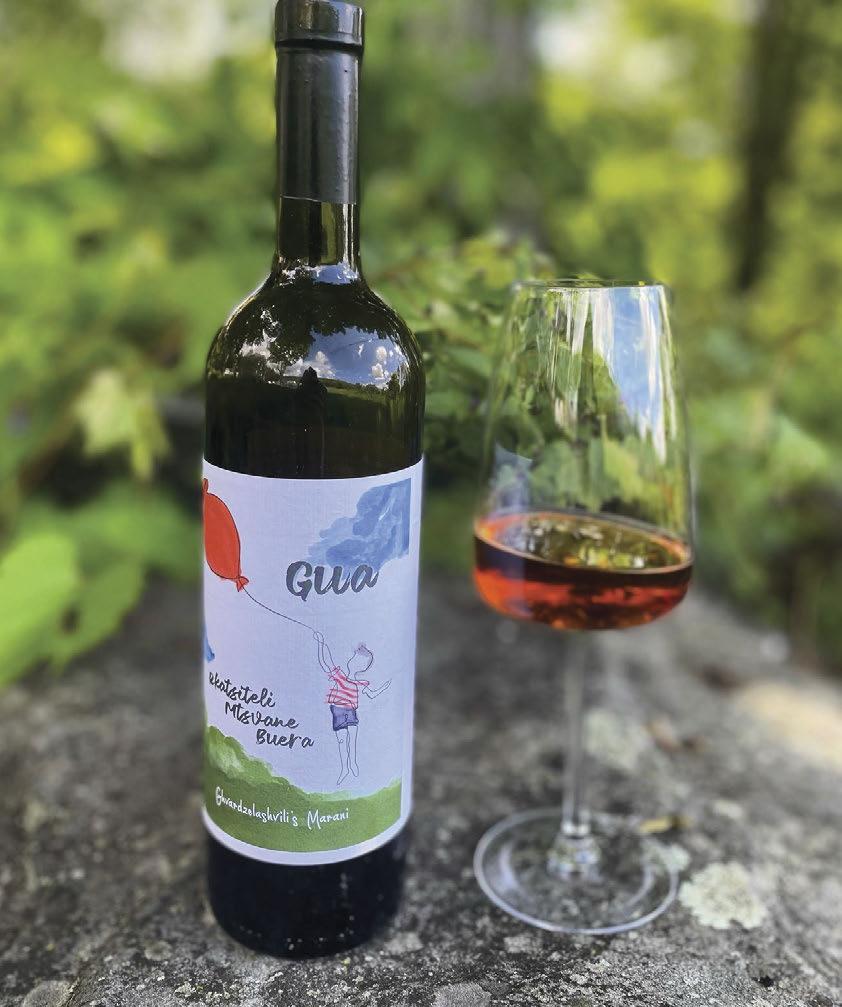
For much of the 20th century, Soviet-era policies forced Georgia’s vineyards away from indigenous grape varieties toward blight-resilient cultivars fit for massscale production and export. But now, after three decades spent catching up to the rest of the industry, Georgia’s wines have finally reemerged as the epitome of ancient winemaking in contemporary form.
“Georgia is a very resilient culture. It’s been dominated by many others throughout history, and they’ve been able to maintain their language, their cuisine, and their winemaking through all of it,” says Anastassia Tsivy, who opened the wine bar Oda Wine Garden in the Delaware County town of Margaretville with her husband Noli Alaj this July. “The history of Georgian winemaking is what made us want to focus on ancient-world regions like Croatia, Greece, and Georgia, because they’re not very well known, but the wines are very high quality. We wanted to share the wines from our regions and help people discover them.”
Tsivy and Alaj, who are first-generation immigrants from Georgia and Albania, respectively, began dreaming of opening Oda after trips back home before Covid. “It made us appreciate our own culture,” says Tsivy. “It is very different the way that we eat and drink together, and what those things mean to us.”
Though they’ve spent the past decade in the corporate world, the two called on their combined 20 years of experience in the New York City hospitality industry in opening Oda. Tsivy honed her wine knowledge working at several wine bars, including the beloved Spanish tapas spot Ñ in Soho, while Alaj worked in the critically acclaimed restaurants of fellow Albanian, and early farmto-table champion, chef Zod Arifai.
After many weekend trips to the Catskills, they bought a home in Andes six years ago. When the opportunity arose earlier this year to open a little spot of their own on Main Street in Margaretville, they jumped. “We looked at the space and the patio, and we thought maybe we could do something here,” says Tsivy. “It was pretty spontaneous.”

They completed most of the renovations themselves, transforming the tiny interior of the former barbershop into an intimate 18-seat dining room with crisp white walls, birch-hued wood chairs and barstools, and a thick, wood-slab bar. Vintage ads for Georgian wine adorn one wall. Out front, the pea gravel patio seats 20.


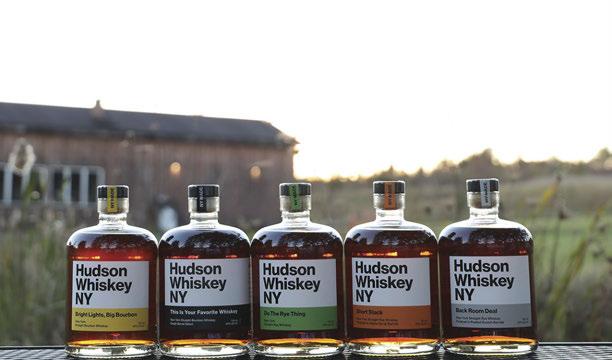





The menu at Oda focuses on the rich culinary and winemaking heritage of countries in the Balkans and Caucasus regions. The 14 wines offered by the glass and carafe during our visit ranged from stony whites from Spain and Greece to a peppy rose from Catalonia; a tannic, bone-dry Georgian amber; and complex, lesser-known reds from Croatia, Slovenia, and Georgia, with a few more familiar French options thrown in for good measure.
The pricing on the orange wine section alone is a microcosm of Oda’s approach: With three options at $11 to $17 a glass, there are affordable options alongside splurge prices for adventurous wine lovers out for an exploratory sipping sesh. The bottle list of close to 100 wines is where Tsivy gets to play with sourcing more obscure varieties like Greece’s beloved Retsina, a wine fermented with the resin or branches from the Aleppo pine tree that the country’s producers are bringing back from a harsh edge of unpalatability.
On the food side of the menu, Alaj is turning out a tight list of wellcomposed small plates mostly inspired by Balkan cuisines. Individually, most dishes pair well with a glass of wine as a pre-dinner aperitivo or— like we did, they can be combined into a pretty substantial meal.
For anyone intimidated by unfamiliar flavors or ingredients, there are several plates that pull from well-known European traditions to fall back on, including a chicken liver or mushroom pate ($7), a burrata salad with heirloom tomatoes ($13), and the impressive-looking whole-roasted eggplant with whipped ricotta-mascarpone cream and green olive relish ($13).
The Balkan platter ($40) is the standout dish on the menu. It leans heavily into the bold, bright flavors of Albanian cuisine, and combines many of the menu’s other small plates into one.
Alaj rotates its components regularly, but on the evening we visited, it featured sujuk, an Albanian fermented spicy beef sausage; smoked beef prosciutto; a creamy Albanian red pepper sauce called ajavar; several types of cheeses, including a barrel-aged feta served with Georgian preserved walnuts (unripe walnuts poached in syrup until their shells are softened and made deliciously edible); smoked beets with mascarpone, a hefty wedge of flaky spinach burek (stuffed pastry); pide bread; and an array of house-fermented vegetables, offering a bracing bite to cut through all that richness.


for the mountains. Stay for the food.
visit

Hard cider’s public image has made great strides in the past decade, buoyed by the nationwide craft beverage movement. New York State, with its historic apple growing legacy, is at the epicenter of the craft cider revolution. In the Hudson Valley alone there are over two dozen producers making everything from wild-fermented to Basque-style and champagne ciders. New York Cider week returns October 6-15 to celebrate the state’s makers with 10 days of education events, tours, and tastings. Angry Orchard in Walden will host a Certified Cider Professional Level 1 certification workshop while Pennings Farm offers facility tours and Fishkill’s Boutique Wine and Spirits leads a guided tasting. Ciderweeknewyork.com
Beers &
Cruise
visit



Events & Catering
600 N Galleria Drive, Middletown



Opened in June, Aspire Brewing is a sprawling 30,000-square-foot brewery complex in the Middletown area. Located in the Plaza at Crystal Run off Route 211, the brewery shares a parking lot with a PETCO and a gym. In a fabulous glow-up, the spacious taproom looks nothing like its former incarnation as an Off-Track Betting parlor. Outside ample sidewalk seating offers a place to enjoy a cold beer on a hot day. Inside, there is a wall of 40+ self-serve beer taps that use a card system plus a full bar, an event space, and games like cornhole, laser ax throwing, and simulated golf. A menu of pub food ranging from pretzels to wings and pizza is also available.
Aspirebrewing.com

940 Route 28, Kingston
41 E Market Street, Rhinebeck
Since opening in 2010, provisions market and specialty cheese shop
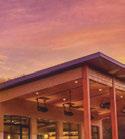
& dog-friendly outdoor dining

Cheese Louise has been a staple of “Gourmet Row,” a food-centric stretch on Route 28 between Kingston and Woodstock. Under new owner Ari Alonso-Lubell, who took over in March, Cheese Louise’s selection at the Route 28 location has expanded with the addition of a freezer case with Woodstock-made Nancy’s ice cream, as well as sausages and fresh pastas. Alonso-Lubell also added a second shop in Rhinebeck, in the former location of the Woodstock Meats pop-up. Across the river, you’ll find a special focus on local cheesemakers as well as a resident cheesemonger to guide you through a custom tasting.
Cheeselouiseny.com
52030 Route 10, Bloomville




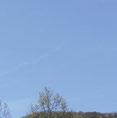






Back in January 2022, we declared that food writer, recipe developer, chef, and all-around Millennial culinary icon Alison Roman’s rumored Bloomville restaurant would be one of the hottest upstate openings of the year. Well, we were off about the year, but about 20 months later, First Bloom Corner Store is open in the former location of Table on Ten in the Delaware County hamlet of Bloomville. True to Roman’s signature of-the-people, high-brow/ low-brow style, the shop sells everything from fresh, local produce and imported Portuguese conservas to Cheez-Its, Nutella, and Domino sugar. It’s all the pantry and dry good essentials to cook well at home, plus other country store essentials like laundry detergent. Firstbloomcornerstore.com
Kitty’s
60 S Front Street, Hudson
After a month-long hiatus to recruit and train more staff, build out the kitchen, and finish construction on the next-door event space, the Caboose, Kitty’s restaurant reopens on October 17 with a fresh chef at the helm.
Nicole LoBue is a big culinary name in Hudson, where she moved a decade ago to help launch the nonprofit Kite’s Nest. For six years, she ran the Alimentary Kitchen, Kite’s Nest’s educational kitchen out of Basilica Hudson, also catering for the venue’s many music shows, private events, and pop-ups. After culinary school, LoBue cut her teeth in the Bay Area restaurant industry. She brings a background in foraging and herbalism to her recipes, and an understanding of Hudson Valley bioregion’s microseasonality. The menu at Kitty’s will use local produce and meat to offer elevated comfort food that nourishes as it delights. As the weather cools, prepare for hearty fall fare like braised meats and brioche made inhouse. The Caboose also opens for booking this month and will eventually house Kitty’s sister natural wine store, Grapefruit. Kittyshudson.com











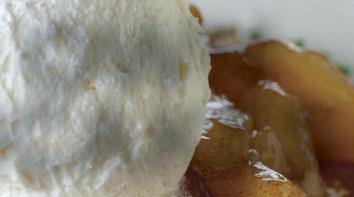




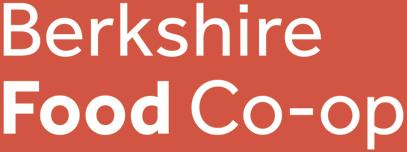



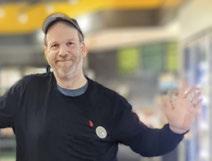

 By Mary Angeles Armstrong
Photos by Winona Barton-Ballentine
By Mary Angeles Armstrong
Photos by Winona Barton-Ballentine
Board by board; each nail, tile, stair tread, and riser; from the hand-poured foundation to the pine rafters; Zach Kalatsky ’s cedar framed, round house outside Saugerties was raised by the hands of community. A manifestation of the proverb, “to go fast, go alone; but to go far, go together,” the 27-foothigh circular house (technically an icosidodecagon with 32 sides set at five degree angles) is much more than the sum of its carefully crafted parts. Part yurt, part castle; the 1,800-square foot interior looks through walls of windows onto the property ’s surrounding 52.8 wooded acres and Overlook Mountain in the distance.
When Kalatsky bought the raw plot of land in 2018 he had a vision of creating a nest. “I wanted the house to support everyone around me and be a community space, while also be a home that was uniquely me,” he explains. But there was one catch: “I’d never actually built anything before.” Kalatsky admits he likes to go big. “I tend be ambitious when I take on something new. Then know I can do everything below that level. It was a fun game of learning for me.”
Zach Kalatsky enjoying the open-concept living area of his round, stick-framed home outside Saugerties. After much deliberation and dreaming, Kalatsky designed the home on Illustrator and then worked with an engineer and architect to finalize the plans. He then commission a kit with the walls and ceiling from a West Coast company. Then he dove in, building the home from scratch over five years. In his quest to build his nest, he also found his tribe and the home is also a thriving center of community.

To make his vision a reality he relied on the help of old friends and new, as well as family. “Between 60 to 80 people helped me throughout the process,” says Kalatsky of the five-year project. With each new construction step to be mastered, someone more experienced came along with expertise to share, enthusiasm to teach, and a free day to help out. “I didn’t know how to wire for electricity and then a friend told me they loved electrical work. Another friend taught me how to use a router. Someone else asked ‘Can I help you paint?’ and I was like, ‘yes please’. I had friends’ children here helping to screw things in. Often times the help actually slowed me down, but I was never alone. It was always about building community.”
A Queens native, Kalatsky grew up in an Orthodox Jewish community where he always struggled to fit in. “Our family was the black sheep in the community, and I’m the youngest,” he says. “No matter what I did, I didn’t really belong.” He describes himself as a shy child who often hid in the closet and had a hard time speaking in public. “I was a nerdy kid who was into computers and didn’t know how to talk to women,” he says. “I didn’t even like to take photos.” He attributes his meekness to learned family behavior. “ There was a huge emphasis on safety and security in the community,” he explains. “ Travel was dangerous, not being
seen and hiding—these are all safety tactics.”
At 18 he went to a yeshiva in Israel for six months. “I wanted to give Orthodox Judaism one last shot,” he says. While he found beauty in both the country and the religion, he ultimately realized the traditional Orthodox life wasn’t his path. He returned to New York and began studying graphic design at Queens College, where he discovered the New York City Burning Man community. “The community really helped me open up and express myself,” he says. “I realized I could dress however I wanted, do whatever I wanted, and really be accepted for my own weird self.” He attended the Burning Man festival with a group of Orthodox Jewish friends, and then, back in New York, began helping to organize large-scale events for the extended community. “I can’t say Burning Man was my long-term home,” he says. “However the community taught me how to be seen.” This revelation inspired him to create spaces where others could be seen for their true selves.
Zach’s Side of the Mountain Kalatsky was first drawn to the Hudson Valley ’s natural abundance a decade ago. He had transitioned from graphic design into sales and ran a successful online business that gave him work-from-wherever flexibility. “I was living in Brooklyn,” he says. “Every weekend my friends went drinking and I came up to go hiking and camping.” After
The home’s 600-square-foot second story is an open loft. The home’s cathedral ceiling is capped by a skylight at the room’s 27-foot peak. Along the edges of the ceiling Kalatsky added Bluetooth-controlled colored lighting that can flood the ceiling with a variety of hues for events. The aerial silks, secured from the ceiling, were part of Kalatsky’s must-haves when he designed the house.
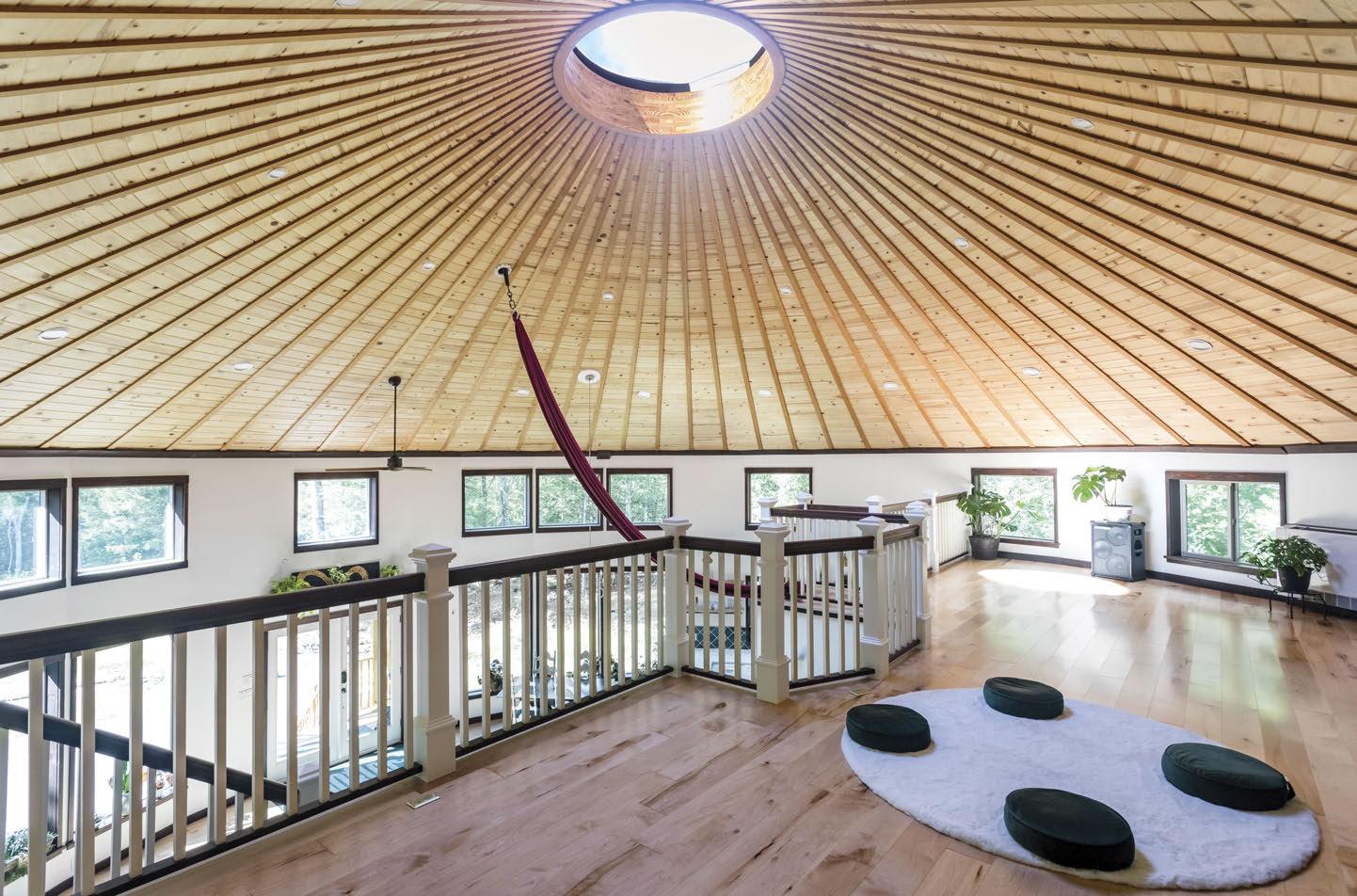







































Whether it’s a ductless unit, floor unit, ceiling cassette, or air handler, we provide comfort and filtration to every room, with maximum energy e ciency. Get peace of mind with our 3-year labor, and 12-year parts warranty, plus we o er full service on everything we install.







Contact us today to learn more about which heating and cooling options would work best for you and your home.








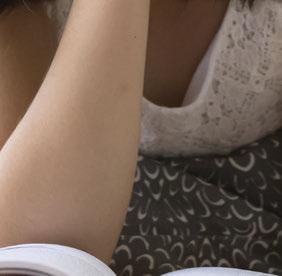

















Kalatsky painted the primary bedroom walls emerald green and added gold-plated wall sconces. The room also features a walk-in closet and an opulent ensuite bathroom. Through the door, the back deck is built over a bluestone cliff looking into the woods.

a stint traveling cross-country with his former partner, he made the permanent move to the region, and together the two began looking for a home.
After placing several unsuccessful bids on homes, Kalatsky regrouped a little. While relaxing at the Emerson Resort and Spa in Mt. Tremper during a day off, his partner asked him what he was hoping to manifest. “I described a place with a long driveway, open floor plan, big bathroom, and aerial silks on the ceiling—secluded but close to everything,” he recalls. “ Then it was like voila! I knew exactly what I wanted to build.”
When he found his 50-plus raw acres between Woodstock and Saugerties, he moved very quickly. “I knew I could make it whatever I wanted with the help of the internet and time,” he says. He moved into a tent at the property’s edge at the end of 2018, while he waited to close with the bank and get a construction loan approved. Then he spent the next three months camping, using a sled to trek in supplies, getting a feel for the land and dreaming of what he could build. In the spring of 2019, the land was his and he upgraded to a trailer.
Kalatsky cut his construction teeth by building a small house retrofitted from a shed sourced from Bob’s Barns in Shandaken. Finishing that project, he turned his attention to creating a larger, more unconventional home that reflected his initial vision. “I talked to multiple architects but wasn’t excited by anything they proposed,” he says. Then he came
across a small, round teaching studio in Lake Hill. “I immediately got on my computer and began designing,” he says. “I knew I wanted something unusual like that and also much bigger.”
He designed the home himself on Illustrator and then sent his initial renderings to an architect to turn into a 3D plan. After working with an engineer to make sure the plans were practical, he sent the home’s final design to a pre-fab company in Washington which turned the design into a kit and then shipped him the walls and the roof. With the help of friends, he laid the 1,200-square-foot round foundation at the very center of the property. He added a high-efficiency heat pump and radiant coils throughout the first floor and then covered them with an expanse of hardwood flooring and tiles.
Facing north, the home’s open-concept living room has an angled, open kitchen at one end. Kalatsky added an expanse of composite quartz counters for meal preparation and his neighbor showed him how to plane live edge elm and oak shelving for the walls above. A green tiled backsplash adds color. Kalatsky realized he could add a pot filler behind the stove himself after reading the instructions online. “It ’ s one of those things that would cost thousands if someone else installed it, but was cheap to do myself,” he says. “It ’s kind of silly, but it was fun.”
The home is in the center of the 53-acre property. “It’s predominantly forested land, mostly made up of hemlock, pine, and oak,” Kalatsky says. “There are wild blueberries everywhere and there is an abundance of bluestone since the property is on a ledge.”

Kalatsky relied on the help of his friends and community to build the home and hopes it can now support others in return. He plans to create a large community garden on a cleared patch in front of the home. “There’s also an old quarry that I plan on turning into a biodynamic swimming pond,” he says. “Collaboration over competition is a big part of my life.”







































Above: Specially designed to accommodate the interior walls fivedegree angles, Kalatsky created a flowing kitchen perfect for cooking for others. A backsplash of green diamond tiles contrasts with the kitchen’s gold fixtures. Kalatsky planed the live-edge elm and oak upper shelving with the help of a neighbor. Throughout the ground floor, a high-efficiency radiant heating system installed by Paul Cassio of Around the House LLC keeps the room warm throughout the year.

Right: Kalatsky chose a mix of variegated green rectangles and white hexagon tiles for the primary bathroom’s triangular bathtub. “My style is where functional and aesthetics go hand-in-hand,” says Kalatsky. “There’s a feeling of luxury while also feeling like an accessible cabin in the woods that one can explore, be playful, and authentically original.”

At the opposite end of the living room a wood burning stove was one of the only features he professionally outsourced. However, he and a friend laid the dark herringbone tile hearth, which reaches to the home’s cathedral ceiling. At the back of the house Kalatsky added two bedrooms with sliders onto a deck. In the guest bathroom, a mix of slate and dark tiles line a cave-inspired shower. He painted the primary bedroom emerald green to match the view, and then, in the primary bathroom, tiled the Jacuzzistyle triangular bathtub with a mix of emerald and white tiles. A large Italianate vanity completes the space, which he’s named “ The Italian Mermaid Grotto Bathroom.” Above the bedrooms, a loft adds a den/ meditation space and 600 square feet to the home.
Now with the project completed and his former partner having amicably flown the nest for a career in Berlin, he hopes to open the space to the community that helped build it. “ We’ve already hosted many gatherings,” he explains. The gatherings have ranged from informal potlucks and ecstatic dances to more organized sound baths and workshops. “I created something from a place of wounding to really be seen myself,” Kalatsky explains. “I hope this becomes a space where others feel they belong because I didn’t feel like I belonged. I love holding that space for people.”
In August 2020, Sarah Carlson, a filmmaker and health coach based in Kingston, found a lump she suspected was a fibrocystic mass, common in people with dense breast tissue. Because it was the beginning of the pandemic—when people were told to see a doctor only for emergencies— Carlson didn’t rush to get a mammogram because she had an appointment with her OB-GYN in December.
“Looking back, it seems stupid that I waited,” Carlson says. She noticed the lump in her breast became painful and red during her wait, and she didn’t realize, as many don’t, that she didn’t need to wait to see her OB-GYN and could have requested a mammogram through her primary care physician.
After a mammogram and ultrasound revealed that Carlson had invasive ductal carcinoma, the most common form of breast cancer that accounts for 80 percent of diagnoses, it was time to figure out her treatment plan. Carlson’s cancer was stage 2a, meaning it had invaded nearby lymph nodes, and one doctor told her she’d probably need a double mastectomy, but a second opinion said she didn’t.
Eighteen months after her diagnosis and undergoing a lumpectomy and radiation, Carlson is cancer-free. “Don’t hesitate to get a second opinion,” Carlson says. “You’re dealing with a life-threatening illness; not every doctor will have the same recommendation or even diagnosis.”
After a breast cancer diagnosis, people feel a range of emotions—and most aren’t good—but action is one of the best antidotes to despair. We have terrific medical options for breast cancer treatment in the Hudson Valley, plus non-profits providing supportive services. If you, a friend, or a loved one find yourself with a breast cancer diagnosis, here are some things to note as you navigate your care.
One of the most important things to do after a breast cancer diagnosis is to lean into science and use the diagnostic tools available. “Go for the 3-D
mammogram—2-D mammograms are a waste of time and radiation,” says Hope Nemiroff, executive director and founder of Breast Cancer Options (BCO), a nonprofit that’s the largest provider of free, non-medical breast cancer services in the Hudson Valley.

Options for 3-D mammograms are abundant in the region, but Nemiroff recommends Nuvance Health, which offers 3-D mammograms without a referral (there are some requirements, such as being over 40) plus additional breast imaging services such as breast ultrasound, breast MRI, and imageguided breast biopsy. Nuvance offers imaging in Kingston, Carmel, Poughkeepsie, Rhinebeck, and Fishkill. In addition, Nuvance has New York State Cancer Service Programs at Putnam Hospital in Carmel and the Dyson Breast Center at Vassar Brothers Medical Center in Poughkeepsie.
“At Dyson, patients have mammograms and ultrasounds on one side of the center, and then, if necessary, they can go right next door to schedule with a team of doctors,” explains Amanda Miller, LMSW, a certified oncology social worker. “In addition to surgeons, Dyson has physician assistants who help with high-risk patients and a team of nurse practitioners who help with patients from treatment through remission.”
Susan Boolbol, MD, FACS, is the system chief of breast surgical oncology and breast program at Nuvance Health. Dr. Boolbol is fellowship-trained in breast surgery, has clinical expertise in breast cancer surgical oncology, and is the president of the American Society of Breast Surgeons. Dr. Boolbol is also known for caring deeply for the whole patient and encouraging patients to vocalize their fears and emotional needs.
“Dr. Boolbol values a model that makes breast cancer as easy as possible,” Miller says, part of which includes a program of nurse navigators. Miller explains that Dyson patients meet with their doctor, who explains what type of breast cancer they have and then presents a treatment plan and
the steps they can take. Sometimes, patients go straight to surgery, and sometimes medications come first. “If they need surgery, sometimes there’s clearance needed from a primary care doctor,” Miller explains, “and our nurse navigators make the connections, get clearances, schedule oncology appointments—basically everything needed from a coordination standpoint—which gives the patient one less thing to worry about.”
As a Dyson social worker, Miller meets with everyone diagnosed with breast cancer. “It allows them to create a narrative around their experience and talk to someone outside of their friends and family about what they’re going through,” Miller says. “It’s helpful for patients to have a trusted person to discuss their breast cancer with whom they don’t have to worry about burdening with the emotions of it.” Miller and other social workers can also help sort financial assistance and/or transportation because when you have breast cancer, the last thing you should be worrying about is how you’re going to pay for your care and get to appointments.
The information about breast cancer can be downright overwhelming. Knowing where to begin can feel daunting, but BCO is a great place to get your bearings. Although their website hasn’t been modernized for the most user-friendly experience, there’s a wealth of information in the dropdowns, everything from their Healthy Lifestyles Calendar (you can print it or email them for a hard copy), which is as much of a resource guide as it is a calendar.
A life-threatening illness can be a lonely, isolating experience, and it’s sometimes challenging for family members and friends to provide the support breast cancer patients want and need. “It’s hard to remember everything, especially because your practitioners are speaking a new language, and the brain can almost blackout with all of the information,” Carlson says.
Before the pandemic, BCO had a companion/advocate program, which matched you with a breast cancer survivor who could accompany you to medical appointments to ensure you ask all the necessary questions and help be your eyes and ears during appointments. They hope to start that up again soon.

Nuvance’s nurse navigator program helps, and so does BCO’s peer-to-peer mentoring, which matches you up with a breast cancer survivor to chat with about what you’re going through.
“My breast cancer won’t be your breast cancer,” says Nemiroff, who had breast cancer in 1995 and recognizes support groups as a critical component of this journey. Both Nuvance and BCO have a variety of support groups. Most groups currently meet online, though a few meet in person. There are general and more specialized groups for young survivors, metastatic patients, and others.
Since 2012, BCO has organized a retreat at Omega Institute for women with metastatic breast cancer. Programs are specific to women with metastatic breast cancer and include writing workshops, low-impact yoga classes, and talks from health professionals. Because it’s challenging for family members to discuss their fears with breast cancer patients, the retreat also sponsors a family night with a talk about how to navigate the hard conversations. This retreat is free, thanks to underwriting from the Omega Institute, Miles of Hope Breast Cancer Foundation, United Breast Cancer Foundation, the American Endowment Fund, and others.
While your breast cancer treatment and recovery is top of mind, you may be wondering about some basics, like how to feed your family. While meal trains are a classic option, your friends and family might be helping with
things like shuttling your kids to sports or walking your dog. Sparrow’s Nest is a nonprofit in Wappingers Falls that cooks and delivers homemade meals to families facing a cancer diagnosis within 35 miles of its kitchen.
BCO also organizes Camp Lightheart, a free sleepaway camp at Omega Institute for children who have lost their mothers to breast cancer or whose mothers are survivors. The camp’s purpose is for kids to have lighthearted fun, but there are also sharing circles for kids to verbalize their fears, often for the first time.
Thanks to the generosity of Miles of Hope Breast Cancer Foundation, massage and acupuncture services are provided through Breast Cancer Options. Both therapies help reduce stress and anxiety while also boosting the immune system. Patients can receive one treatment per month up to five treatments with an approved practitioner.
“You don’t have to be a good girl,” Nemiroff says, reminding anyone in this position that it’s okay to push for additional information if you don’t understand something about your diagnosis or treatment plan. “All questions are good questions,” she says.
Carlson, who has worked with Nemiroff at BCO since February 2023, was reluctant to take Tamoxifen, a common treatment for early breast cancer. Her sister died of an allergic reaction to a drug when she was in high school, and as a result, she doesn’t take medication blindly. After her surgery and radiation, Carlson took Tamoxifen, but had side effects that outweighed the benefit of taking it, and genetic research showed it wasn’t a great fit for her.
If conventional treatments leave you feeling less than enthused, there are other options local-ish options, such as the Stram Center for Integrative Medicine in Delmar and the UltraWellness Center in Lenox, Massachusetts.
The Stram Center combines scientific medicine with complementary practices such as acupuncture, IV infusions, and hyperbaric oxygen therapy, among other therapies. In Lenox, the UltraWellness Center is run by Elizabeth W. Boham, MD, MS, RD, who has a free e-book for women with breast cancer and links to podcast interviews on the clinic’s website. “We focus on the individual woman and where she needs to focus to create balance in her body,” Dr. Boham says, “and we work to remove things that may be causing disease/imbalance in the body (such as toxins, stress, inflammation, poor diet, high blood sugar, high insulin) and replace things that may be missing (low nutrient levels, low omega-3 levels, low levels in the microbiome, adequate sleep and time for rest, etc.).”
When faced with a life-threatening illness, we can feel paralyzed and unsure of what to do first. It’s natural to feel helpless and hopeless, but one of the easiest, most accessible ways to make change is to control what we can. Making small changes such as diet and lifestyle upgrades benefits our health and peace of mind and puts us in an empowered place to face (and beat!) a breast cancer diagnosis.
You can sign up for the BCO newsletter to keep up-to-date on local educational programs. Nemiroff will speak about patient advocacy on Saturday, October 7, at the O+ festival in Kingston.
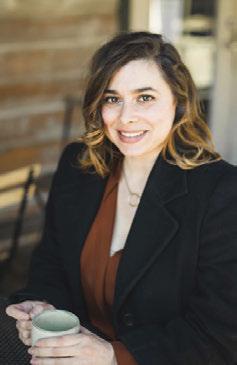
Contact information for some of the services mentioned in this piece:
Breast Cancer Options (845) 339-HOPE

Dyson Breast Center (845) 790-8855

Sparrow’s Nest (845) 204-9421
The Stram Center for Integrative Medicine (518) 689-2244







The UltraWellness Center (413) 637-9991




 Text
Text
From the tip of Manhattan to the Adirondacks, the Hudson Valley is an adventurer’s dream, offering some of the toughest hikes on the East Coast that invite exploration, determination, and a test of grit. Trails like Breakneck Ridge, Mount Beacon, the daunting Catskill 9, and the notorious Devil’s Path demand not just physical strength but mental resilience, inviting hikers to step beyond their comfort zones and challenge their limits. Nestled closely to the headwaters of the mighty Hudson River, the climbs of the Santanoni Range add to this rugged tapestry of trails, pushing even seasoned hikers to conquer new heights.
The thrill of these trails—presented in order of increasing difficulty—lies not just in their challenge but in the rich rewards they offer: awe-inspiring vistas, a deep sense of accomplishment, and a distinct way to connect with the landscape of the Hudson Valley. So strap on your boots, grab your pack, and set your sights high; it’s time to tackle the toughest trails the Hudson Valley has to offer.
and photos
by Sean O’DwyerBeacon Mountain Fire Tower
Trailhead Location: Wolcott Avenue, Beacon
Hike Length: 3.9 miles
Total Ascent: 1,400 feet
Time: 2-3 hours
Intensity: Strenuous
Well-known in the area as a workout hike, the first mile of the Mount Beacon Casino Trail is relentlessly steep. It begins with a zigzagging metal staircase consisting of about 200 steps. At the top of the stairs, the steep trail continues along rugged switchbacks that eventually take you to the ruins of a defunct incline railway’s powerhouse. (The funicular railway ran from 1903 to 1978 and was a major tourist attraction for the area.) Nearby, the foundation of an old dance hall (the “casino”) provides an enormous flat viewing area above the town of Beacon and the Hudson River below. From here, another mile of trail brings you to Mount Beacon’s fire tower which has one of the grandest views in the Hudson Highlands. From there, you can return the way you came or continue in a loop around Beacon Reservoir via Schofield Ridge, which offers many more views of the surrounding highlands. After your hike, there are also so many options in Beacon for a solid chew-and-chat.
Breakneck Ridge
Trailhead Location: Roadside Parking on 9D, Beacon
Hike Length: 3 miles
Total Ascent: 1,300 feet
Time: 3 hours
Intensity: Difficult
Close-by Breakneck Ridge has long been regarded as the toughest hike in the Hudson Highlands. Its vertiginous rock scrambles will test your coordination and your nerves. The trail begins at sea level and scrambles up 1,100 feet in less than three-quarters of a mile, which is steeper than any hiking trail in the Catskills. But it’s so fun. And those views!
Due to its difficult, technical scrambles, this trail is not recommended for pets. Hikers should be in good physical condition, as prolonged effort is required. Fitness freaks will gobble up this route, but regular people will find it extremely taxing.

By the way, you’ll find Metro-North train stations close to both Mount Beacon and Breakneck Ridge, making both these hikes ideal day trips for city dwellers.
Halloween doesn’t have to come just once a year! Every weekend through October 29, Yogi Bear’s Jellystone Park Camp-Resort: Lazy River in Gardiner offers campers a fang-tastic stay filled with scares, s’mores, and family fun galore.

Set on 100 rolling acres with majestic views of the Shawangunk Ridge, the camp-resort is a destination for anyone looking to enjoy the best of camping in the Hudson Valley—with a little extra sparkle. With luxury cabins and accommodations named for characters like Cindy Bear and Ranger Smith that sleep up to 18 people to spacious RV sites and tent locations tucked among the trees and along the Wallkill River, there’s an option to suit every glamping or camping style.
During the month of October, Jellystone Park transforms into a Halloweenland with over 15 themed events and activities every weekend. There’s trick-or-treating, costume and campsite decorating contests, a super-spooky haunted trail, magic pumpkin patch, arts and crafts, appearances from Yogi Bear and his friends, and even a golf cart decorating contest and parade. And if all the fun on-site isn’t enough, hiking at Minnewaska State Park and historic downtown New Paltz are just a short drive away.

Since 2004, Wild Earth has served the Mid-Hudson Valley with nature-immersion experiences for kids and adults that get participants “into the woods and off the trails” to engage with the environment and build lasting connections. This winter, several programs will help adults deepen their relationship with the outdoors and improve wilderness acumen.

Master craftsman and seasoned hunter Neill Bovaird will lead two workshops that dive into the culture of reverence for working with the products of a humanely hunted deer. “Using the Whole Deer” on December 2 and 3 will teach butchery and skinning, as well as how to craft often-unused parts into useful implements and art. On January 6 and 7, “Buckskin Sewing” will teach participants how to create a handstitched pouch from deer hide with traditional tools and techniques. For anyone who wants to take their relationship with hunting to the next level, a new apprenticeship program, “Way of the Hunt,” will run from March 2024 through January 2025.
Looking to gain the skills and knowledge needed to respond to a crisis in the great outdoors? On January 23 and 24, Wild Earth will be offering a two-day Wilderness First Aid and CPR Course in partnership with the Institute for Wild Med.


The Devil’s Path
Trailhead Location: Prediger Road, Elka Park
Hike Length: 24 miles (approximately)
Total Ascent: Over 9,000 feet
Time: 1-2 days
Intensity: Most Difficult
The notorious Devil’s Path trail in the Catskills is regularly listed as one of the toughest hikes in the United States. That’s because the trail is long and brutal, passing over 24 miles of deep Catskills wilderness. In doing so, it crosses seven mountains and some of the gnarliest terrain in the Northeast. But it’s also exceptionally beautiful and astonishingly scenic.
The Devil’s Path is a serious hiking challenge. You’ll scramble through ancient rock channels, slog through mud pits, and enjoy breathtaking boreal summits. In summer, there’s often no water along the trail. In the coldest months, some sections require full winter mountaineering gear. Most hikers section-hike the range, tackling one or two mountains at a time. However, an increasing number of hardy types have throughhiked it in a single day, starting and finishing in the dark. The Devil’s Path remains one of the most challenging, respected, and adored trails in the Hudson Valley.
The Catskill 9
Trailhead Location: Denning Road, Claryville
Hike Length: 23 miles
Total Ascent: 5,500 feet
Time: Over 12 hours / overnight
Intensity: Super Intense
The Devil’s Path is the toughest blazed trail in the Catskills, but the Catskill 9 route ups the ante considerably. In addition to some of the most rugged mountain trails in the Catskill Park, this long loop includes a formidable off-trail section over six of the loneliest and toughest Catskill mountains—Lone, Rocky, Balsam Cap, Friday, Dink—before returning to rough, remote, beautiful trails. The Catskill 9 requires solid backcountry navigation skills, i.e., high competency with paper map and compass. It is, without doubt, the Catskills challenge.
The Santanoni Range
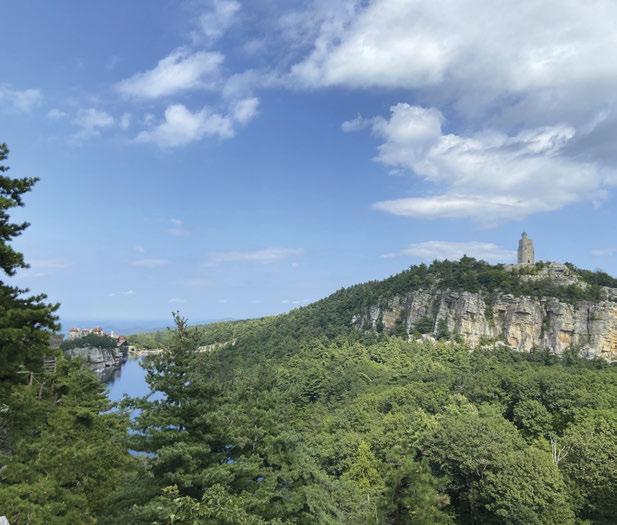


Trailhead Location: Santanoni Road, Newcomb
Hike Length: 16.8 miles
Total Ascent: 4,600 feet


Time: 10-12 hours


Intensity: Extremely Challenging
If you’re working on your Adirondack 46er list, you already know about (and possibly dread) the Santanoni Range loop—widely considered to be one of the most grueling day hikes in the Adirondack Park. It’s a long route and includes some of the steepest, most rugged trails in the High Peaks. There’s even an infamous bog to contend with. On the plus side, stunning wilderness views are on tap just below the summits of all three peaks: Couchsachraga, Panther Peak, and Santanoni Peak. This is a tough, steep hike with prolonged rock scrambles. Cell coverage is non-existent for much of the route so plan accordingly. Knee-high gaiters, trekking poles, and plenty of food and hydration are advised.
Exploring these challenging trails in the Hudson Valley isn’t solely about physical endurance—it’s about uncovering a deeper connection with the natural world around you. As you navigate these hikes, you’ll uncover not only the stunning beauty of our region, but also the joy and fulfillment of embracing a challenge. So, prepare your gear, set your sights on the trail, and experience the most demanding hikes the Hudson Valley has to offer.

This month kicks off with back-to-back festive weekends in Kingston. The O+ Festival, happening October 6-8, will be a tsunami of art, performance and wellness. The return of the Burning of Kingston, October 13-15, takes a deep dive into a Revolutionary War-era trauma with reenactments, walking tours, and discussions. For the first time, alongside the Colonial Ball and the cemetery walks, there will be elements that highlight the experiences of the enslaved, indigenous, and female.
Celebrations of resilience are absolutely on point here in New York’s first capital, which has been steadily regaining cultural and economic momentum after the systemic shock of IBM’s 1994 departure. In 2019, former resident Alexandra Marvar penned a piece in Guardian headlined “The US city preparing for the collapse of capitalism,” citing O+—which pays artists in medical care—as Exhibit A, and concluding that she missed the place.

Not everyone favors the direction of Kingston’s momentum, as evidenced by assorted legal proceedings from landlords opposed to tenants’ rights legislation. Two-term
mayor Steve Noble is facing off against Scott Denny a fellow Democrat who’s gained the Republican and Conservative endorsements on a platform he calls “Kingston United.”
“I don’t know if I’d call the change drastic, but when I came here we had a fairly vibrant two-party system. That’s not the case anymore,” observes journalist Hugh Reynolds. “Even then, it was a Democratic town, but I remember witnessing a Republican majority on the Common Council—I think it was 7-6—and in a few short years it was 12-1.”
Reynolds joined the Kingston Daily Freeman as a general assignment reporter in 1966, having taken refuge in the ink-stained life after a brief IBM sojourn in his native Poughkeepsie, and developed a network of contacts second to none; his pithy musings can now be found on the Kingston Wire and on his own eponymous website. “I’m not in favor of one-party systems; I like balance and debate,” he says. “But there’s a lot getting done, streets are getting fixed, and I’d like to think my adopted hometown is on a revival wave thanks to enormous federal investment, which we haven’t really seen since urban renewal.”


In June, a federal grant of nearly $22 million fully funded the city’s “Weaving the Waterfront Transportation Project,” which incorporates rail trail and Complete Streets work along with flood mitigation. At the end of July came word that $17.3 million in American Rescue Plan dollars would fund the city’s Economic Recovery Plan through 2026, including $4,757,500 earmarked for housing action projects, $4,545,000 for vital infrastructure, and $1,200,000 for business development and redevelopment.

The feds aren’t the only ones investing. Peter and Jennifer Buffett’s NoVo Foundation has just launched a NoVo in Kingston branch to manage the grantmaking and capital projects it’s been engaged in with increasing intensity since 2013, supporting over 60 community organizations and nonprofits around the region with $46 million in 2021 alone. Current capital projects include two on Greenkill Avenue: the Metro, a 70,000-square-foot warehouse that will be transformed into space for hands-on education and career training, and the Greenkill House, adjacent to the Boys and Girls Club, which will offer resources and support to young adults. Representatives of NoVo in Kingston declined to be interviewed for this article.
Housing affordability was severely challenged even before the pandemic-era boom that briefly crowned Kingston the hottest market in the US in 2021. A 2022 count from CARES-NY found 409 homeless people, 105 of them children, 74 of them “chronically” homeless; nearly 1 in 5 of Kingston’s almost 25,000 residents lives in poverty. Median rent at the end of August, according to Zillow, was $1,850; and median per capita income by the latest census data (2021) was $32,587. The US Department of Housing and Urban Development has announced that market rate rent in the Kingston Metropolitan Statistical Area, a designation that includes all of Ulster County, is expected to increase by almost 14 percent in 2024.
More affordable housing is in the pipeline. The Kingston City Land Bank is preparing to take ownership of seven foreclosed properties for $1 each under an acquisition policy approved last April and the Kingston Land Trust will be doing the rehabs. Plans have just been announced to transform a former boarding house on Washington Avenue into 60 affordable units with support services provided by Family of Woodstock; another 164-unit affordable complex is slated for Golden Hill, on the site of the former
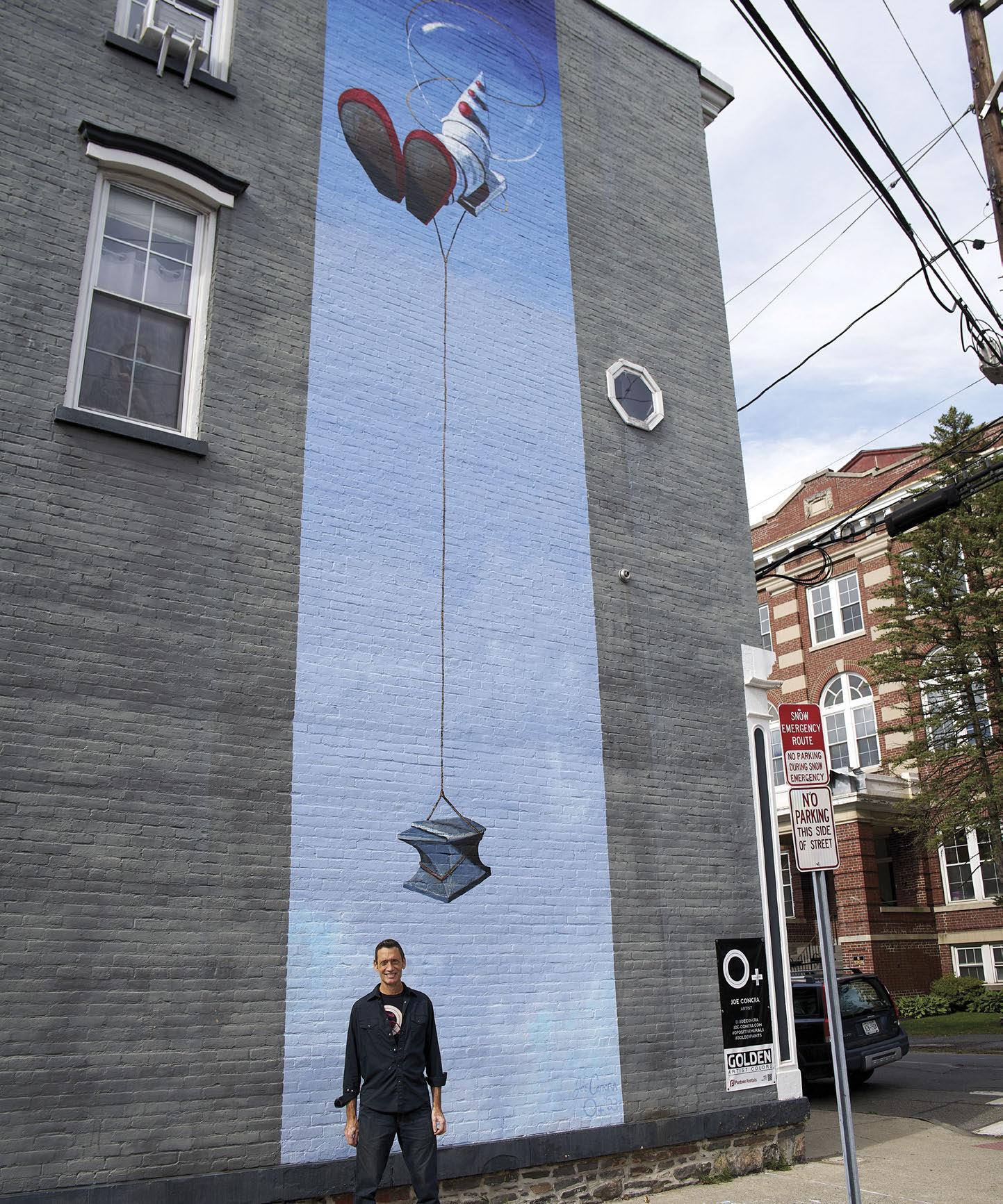
Ulster County Jail. The Kingston Housing Authority has announced plans to add a new four-story building at its Rondout Gardens complex, adding 56 affordable units.
Another helpful development is the city’s adoption of a form-based zoning code in August, which will hopefully help to alleviate Kingston’s housing unaffordability through stimulating mixed-use development, and diverse housing types, including accessory dwelling units. The city also passed an Emergency Tenant Protection Act that established a Rent Guidelines Board under the auspices of its new Department of Housing Initiatives, freezing some rents and sparking the above-mentioned litigation.

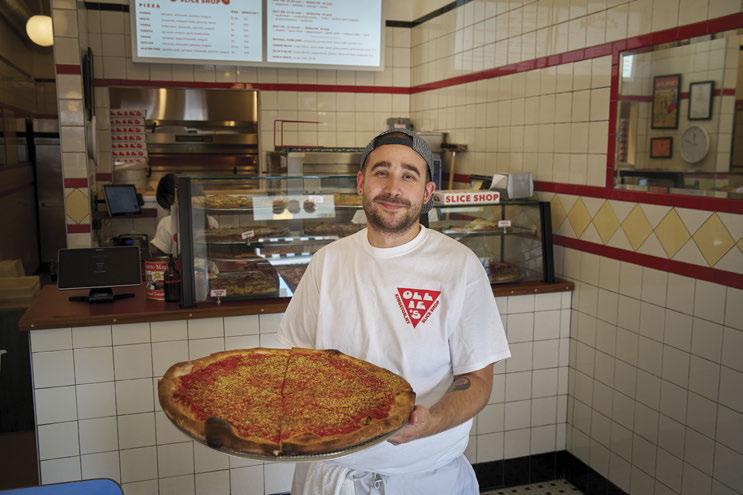
“I feel very excited about where we are and where we’re going,” says Anne Bailey, who founded Bailey Pottery Equipment with her husband Jim 45 years ago in a rented garage and pickle factory on Prince Street. Bailey now employs 37 people in a 60,000-square-foot space, supplying ceramicists around the globe. “Our original model for our business wasn’t to get rich, it was to be fair to everyone— we’re both potters, and we wanted to keep our prices as low as we possibly could while paying our employees a living wage. I think we accomplished that goal, and we love being here, always have. And especially for the last 12 years, I’ve been even more involved with the arts scene here. I started by helping with economic development as a volunteer during the Sottile administration in the early 2000s, and I met fascinating people and saw how things work. Coming from an arts background, I really didn’t understand how policy can affect a community’s growth, but I became very interested in getting to know decision makers. I saw the potential for a great future for Kingston through the arts— there were already so many artists here doing incredible work, but back then they were kind of an underserved, unknown quantity.”

Bailey wasn’t alone in sensing stirrings of potential. In 2007, after Kingston made Business Week’s list of the 10 best cities for artists to live in, the energy coalesced. “A group of us—started having conversations and realized that we needed an Arts Commission, to solidify the idea that the arts were important, not just for our well-being as humans but as an important economic driver in the city,” Bailey says. The commission, formally organized in 2016, went on to found the Midtown Arts District. “It’s another platform for creating conversations around art in all neighborhoods, and all of a sudden people who didn’t typically interact were talking to each other. It’s taken hold and taken off,” says Bailey.
Arts Commission members and representatives from community organizations traveled to Pittsburgh in 2017 to meet with Bill Strickland, whose Pittsburgh Foundation focuses on expanding opportunities through the arts. “We came away knowing this was a model that could work in Kingston,” says Bailey. “That’s always been the goal,
From top:
This stunning 4 bedroom, 3.5 bath contemporary home sits on 15.6 private acres with jaw-dropping views of the Hudson River and Catskill Mountains. The property has been completely and meticulously transformed by its current owners to fit seamlessly into the landscape – twin ponds, in-ground salt pool, hot tub, rolling grounds, terraced sitting areas, cantilevered sunset viewing deck. The modernist home has high ceilings, an open floor plan allowing easy transition from inside to out, 4 fireplaces, gorgeous floors and moldings, and custom plate glass windows. $4.2 Mil. Call Greg Kendall, 954-804-9085.

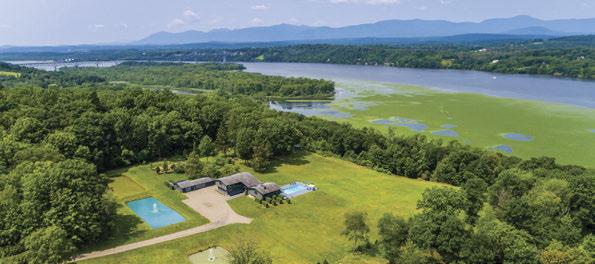

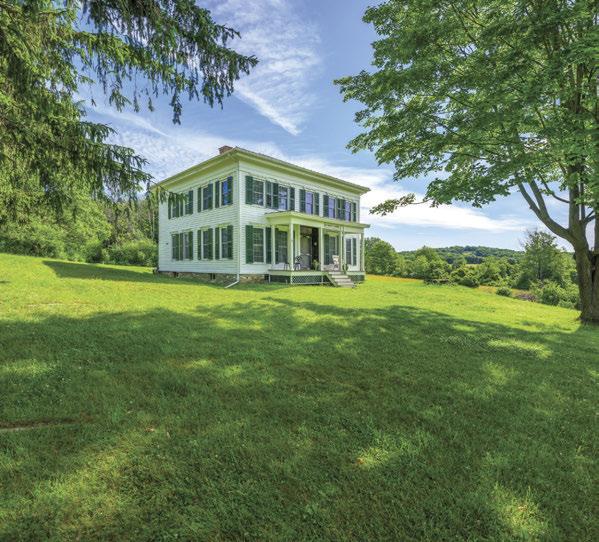
Catskill. Rarely does a Hudson River home of this quality and location come along. With 75 feet of direct water frontage, this meticulously renovated home offers breathtaking views up and down the River. Open concept first floor - kitchen/living room, 3 beds and 2 baths. $1.1 Mil. Call Martin Salerno, 917-734-8161.



bringing all the diverse voices of this community together, advocating for sustainable housing and opportunity for everyone. Artists are one of the first groups to get kicked out of communities, like all low-income people. We don’t want to be that kind of community; we wanted city government to stay ahead of the curve, and I think they’ve been incredibly responsive and responsible.” One of the arts leaders who went along on that trip, Center for Creative Education Executive Director Drew Andrews, has just been appointed by Noble to fill a vacant Common Council seat.
Taking Chances
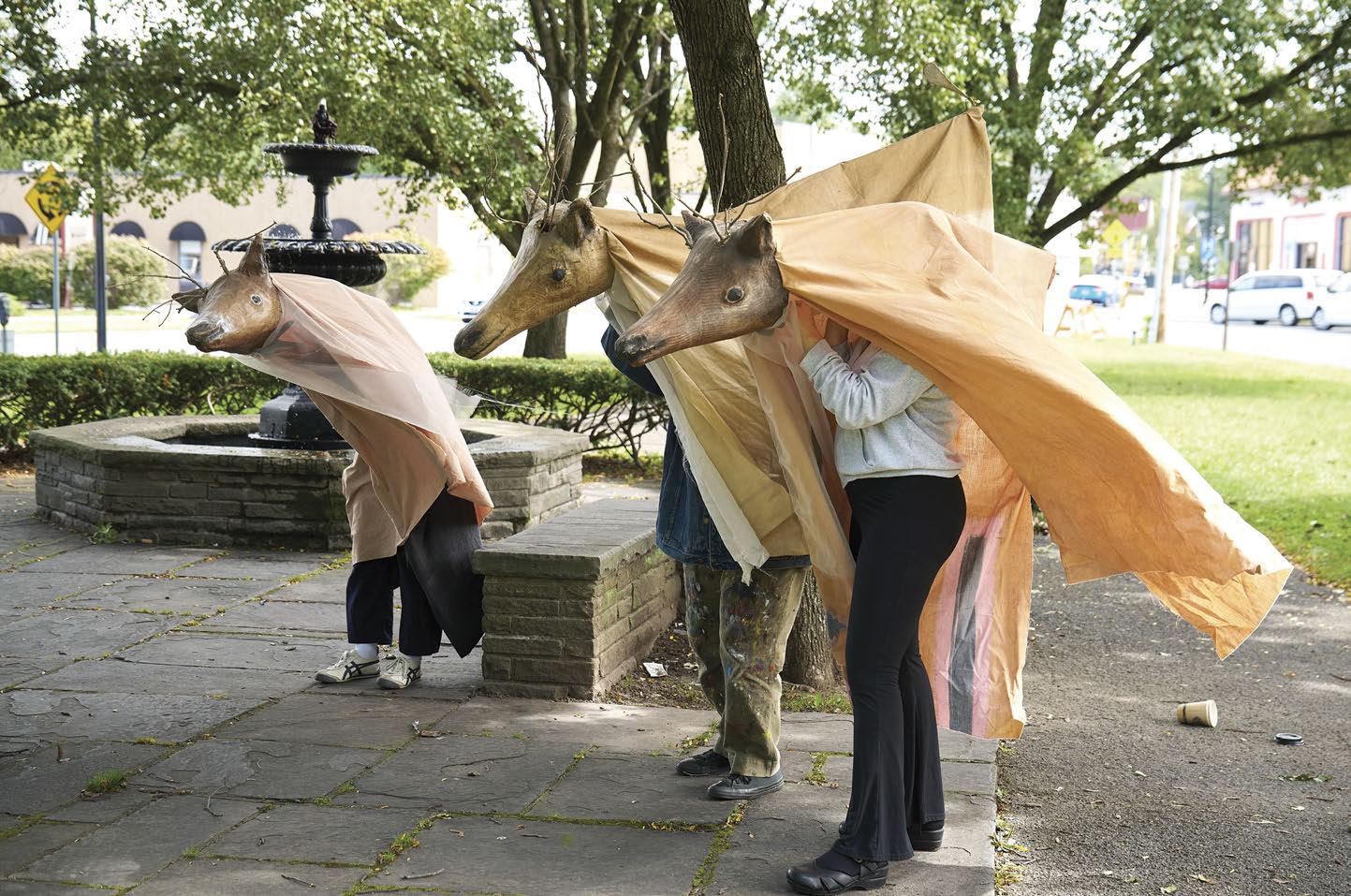
Frank Waters, founder and CEO of My Kingston Kids, lost to Noble earlier this year in the Democratic mayoral primary. “I hope the mayor will incorporate some of the issues I raised into his next term,” he says. “There are challenges here, particularly with communication platforms. Trust doesn’t happen overnight; it needs to be worked on, but transparency and communication can help people begin to believe in government again. About 30 percent of the citizens aren’t online, which means that communicating through Facebook and email and your website, people just don’t get the word— meaning they don’t get the opportunities, the resources and the information about what you’re doing. You have residents here that have never seen an alderman.”
Moving to Kingston from Harlem a decade ago, Waters brought with him a track record of community organizing. My Kingston Kids is a nonprofit family resource center. Besides organizing festivities—a Halloween parade and festival is happening October 28—MKK publishes a resource guide and offers a kids’ DJ and a well-equipped gaming trailer that goes wherever it’s needed—such as an upcoming financial literacy workshop at the Broadway Bubble, a NoVo-supported laundromat and community hub offering story hours, English classes, and free Wi-Fi.
“A lot of things need to be happening simultaneously,” says Waters. “We desperately need more childcare. We need to create opportunities for young people, more green jobs, digital jobs, tax breaks for young entrepreneurs. NoVo is doing great work—they fund us along with every nonprofit board I’m on. There are always going to be hiccups, but they’re willing to take chances, knowing some things work out and others don’t.” (A NoVo-funded food co-op in Midtown recently closed its doors after trying for four years to make the math work out in a problematic building.)
“I grew up here as an IBM kid. Mom was a computer engineer,” says Common Council President Andrea Shaut, a classically trained musician finishing up her law degree





















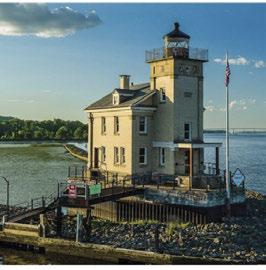
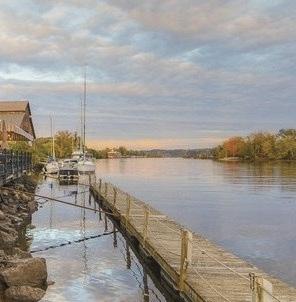














with a focus on government. “I came home after college in the early 2000s, and there is much more business here now than there was then, so much great stuff—but I also see too much displacement. There’s more work ahead, but I’m proud of the things the mayor and our council have done so far. The biggest thing is the zoning—it’s not an instant fix, but it starts the ball rolling toward more housing at all levels, affordable included. When that vote passed, it was the first time in six years that my poker face broke—I started laughing with joy. We erased a 1960s code that was specifically designed to segregate people of color. That’s historic. And as long as we keep collaborating and solving problems as they arise, Kingston will stay the fantastic place it is and has always been.”
Kingston’s YWCA is celebrating its 100th birthday this year. A million-dollar grant from the Mackenzie Phillips Foundation in 2020 covered badly needed structural repairs. “I think we were a test case as she assessed how to make giving impactful and joyful, and it turns out that unrestricted gifts to high-functioning nonprofits make a significant impact,” says CEO Athena Fliakos. “We did a full exterior and mechanical overhaul and turned one of
our buildings into a healing arts center with gallery space.” Multiple early childhood/childcare programs, including one at [Ulster County] Family Court that suffered in the pandemic have sprung back to vibrant life, with significant wage increases for care workers. NoVo has kicked in $50,000 toward a revamped playground and native pollinator garden.
“Kingston is pregnant with all kinds of economic development potential,” says Fliakos, pointing to the iPark 87 project that’s slated to bring jobs and housing to the IBM complex that’s lain fallow for years. “I also think some things are unresolved—eight generations ago people here were slaves and slave owners, and their descendants are still here, experiencing life in vastly different ways. That conversation needs to come to fruition without guilting anyone, with kindness and acknowledgement and even levity. There are still divisions that make life harder for some than for others—it needs to be a courageous conversation, and I think the YWCA can be part of facilitating that. I’m so excited to be here and have a role to play in optimizing the potential, in resolving these things in light of the new opportunities arising. Kingston gives me enormous hope.”

Bailey manufactures their famous pottery equipment in Kingston’s Midtown Arts District. World-renowned kilns, wheels, studio hardware, and ceramic supplies are available to ship or for curbside pick-up.
Bailey manufactures their famous pottery equipment in Kingston’s Midtown Arts District. World-renowned kilns, wheels, studio hardware, and ceramic supplies are available to ship or for curbside pick-up.









(800)
(800)
(800)




community pages

On September 9, Chronogram held a community portrait shoot at the Kingston Farmers’ Market. It was a gorgeous day and the rain held off until we broke down. Kismet! Thanks to the staff of the Kingston Farmers’ Market for their help and support setting up the shoot. Thanks as well to Kingston Bread+Bar for the cold brew, Hare’s Hollow for the pizza, and Laughing Gut Kombucha for the refreshing beverages. And a shout-out to Corryn Carey for being such a trooper and getting her picture taken just after she was stung by a bee while waiting in line.
Join us for the October issue launch party at West Kill Supply, 602 Broadway in Kingston on Thursday, October 5 from 5 to 7:30pm.
Top row: Wes Appell, financier; Abigail Libers, journalist with Malcolm Appell; Andy Montes, Bard student; Adam Benziger, Laughing Gut Kombucha owner; Ariel Dearie, floral designer with Sylvie and Ruby Dearie.


Middle row: Kyle Needham, Oyster Party and Alexis Arvidson Needham, AiAiA Acupunncture with Layla and Bowie Needham; Angel Gates Fonseca, cofounder Hudsy with Nola Fonseca; Samara Daly, Helena Palazzi, and Anne Sanger, Pinkwater Gallery and Kingston Social.


Bottom row: Brooke Lane, interior designer with Redd; Faust Siftar, student and Gordana Garapic, professor of mineralogy at SUNY New Paltz; Rev. Dr. Gregory Simpson and Suzanne Campise, food access coordinator Kingston Farmers’ Market with Amara Simpson; Athena Fliakos, executive director of the YWCA of Ulster County with Jupiter.
OPPOSITE Top row: Corcoran Country Living: Mario Geissler, Jeanne Rakowski, Brad Shur, Felicity Taylor with Zoe Brayman; Fay Gervais, retired; Eloise Paul, real estate professional with Sylvia and Josephine Paul; Lakshmi Yerawadekar (with pizza).
Middle row: Corryn Carey, Owner of the Strand House and Sustainable Structures LLC; Kingston Farmers’ Market crew: Lorraine Salisbury, Alexis Nigro, Suzanne Campise, and Xandra Powers; David Budd, artist and musician.




Bottom row: Quinn Kelly; Lizzy Baird, student; Bo and Jean Conklin; Jaden Wilde and Uma Wilde; Jack Kelly.









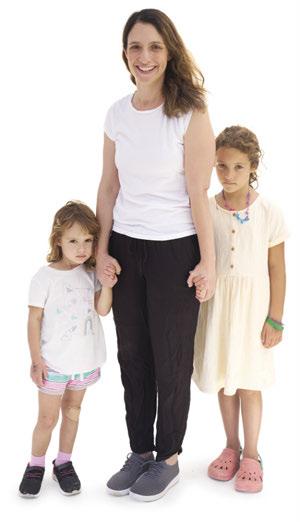





Top row: Stephanie Hertel, therapist and Elizabeth Greenblatt, sex educator with Sex Savvy Hudson Valley with Howie Mauks; Tracy Lerman, Program Director at GrowNYC and Leon Vehaba Farm Director at Titusville Farm with Ilya Vehaba and Daisy; Jason Lee, Roundel product management director and Viola Gurvits, Apollo Partners executive director, client partner with Willow Lee.
Middle row: James Smith with Amelia Legare, owner of the O Zone; Kelly Geary, Sweet Deliverance and Ulla Hauser, ballerina; Jim Fish, architect and Mathew Camara, music teacher.





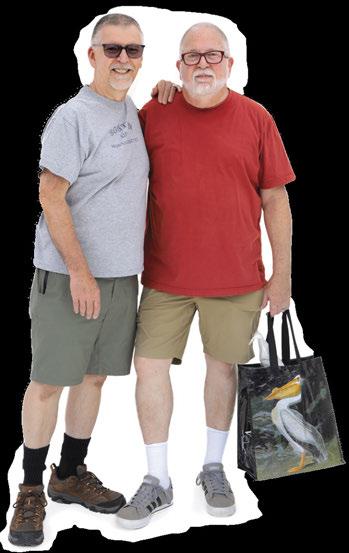

Bottom row: Kerstin vom Hagen, interior designer; Rick Foster, therapist and Larry Decker, artist; Annie Bergelin, Open Space Institute design and capital projects manager; Samrat Pathania, Wallkill High School teacher and clean energy educator.
OPPOSITE Top row: Jennifer Crettien, Hudson Valley Farm Hub outreach and events manager and Miles Crettien, entrepreneur with Elijah Crettien; Jesse Moss, nonprofit marketer and Hila Yasur, experience camp professional with Ruby; Jessika Farah, health coach and Anna Burstein, medical assistant; Emelia, Luca, and Penelope Schneider; Lisa Kelley, Kingston Midtown Arts District executive director with Jackson Kelley; Lisa Cline, Hudson River Maritime Museum executive director; Marigo Farr, journalist, Magnolia Kondrat-Wilson, and Katy Kondrat, musician; Miriam Frischer, retired.
Middle row: Jimmy Buff, Radio Kingston executive director with Violet; Joshua Stratton-Rayner, deputy director of Economic Development, Ulster County and Ashley Stratton-Raynor with Luca and Rosalie Stratton-Rayner; Izzy Zwerin; Mandee LoFurno, senior operations manager, Etsy and Ryan Samuelson, designer; Maryline Damour, interior designer, founder of Kingston Design Connection; Marion Blique, therapist; Harris Diamant, artist and Neville Bean, art director; Nico Jenkins and Jessica Jenkins.

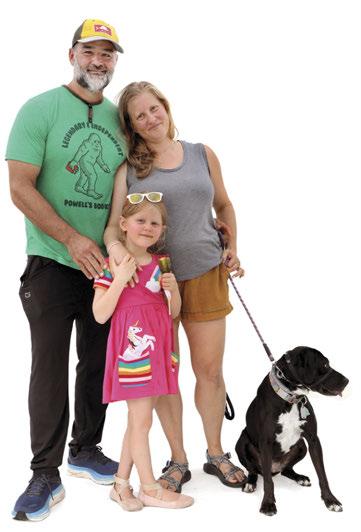
Bottom row: Kenneth Sachar, retired; Phil DeMartino, teacher; Amy Moses, architect and zero balancing therapist; Angelina Sotz, housekeeper; Barbara Hill, former Kingston Common Council member; Carmel Gold, social worker; Suzanne Connole, Mayanaiya Botanicals; Clara Orr, student; Emily Puthoff and Elena Sniezek of Hudson Valley Bee Habitat.

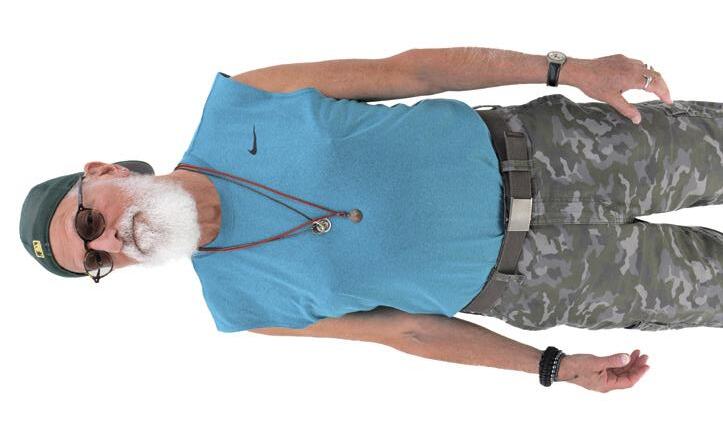







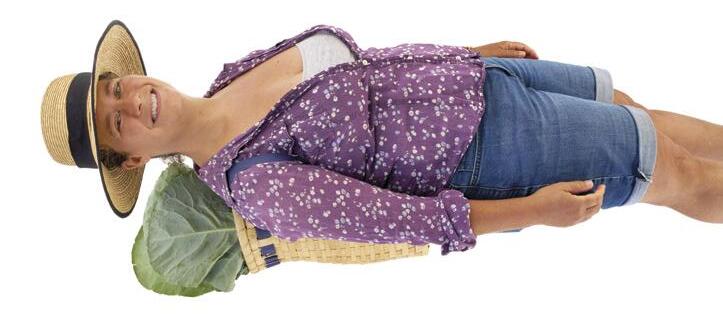







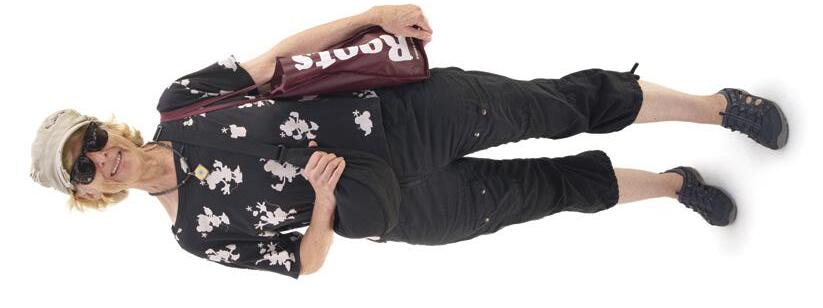




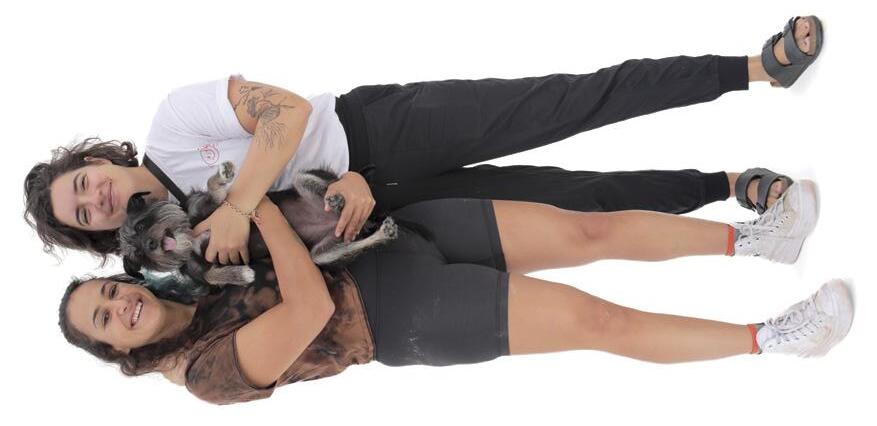

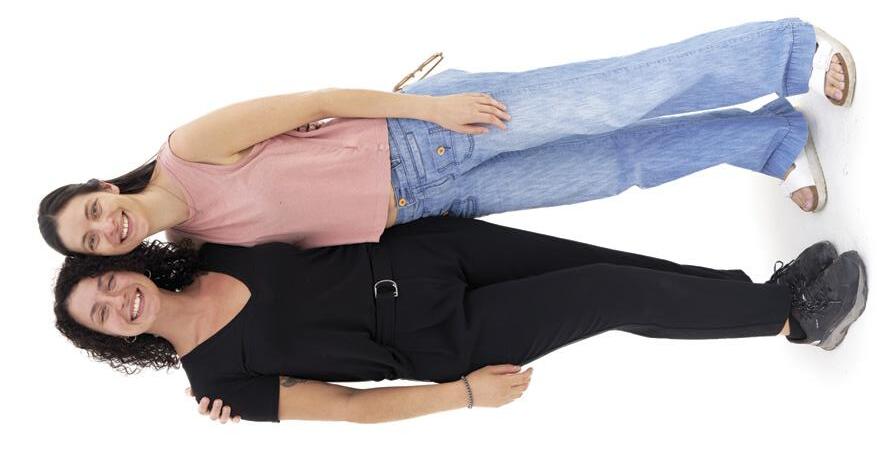

Top row: Rose Ann Vita, psychotherapist; Joe Famiglietti and Nicole Francis of the Ulster County Italian-American Foundation; John Earle, animator and Shana Luther, interior designer with Charlie Earle and Portia Earle.


Middle row: Rachel Mills, blogger; Cristobal Guerra Naranto, interpreter and filmmaker; Olga Joan, Olga Joan Textiles for the Home; David Basch, consultant; Dr. Silvia Birklein, SYNC Psychological Services.

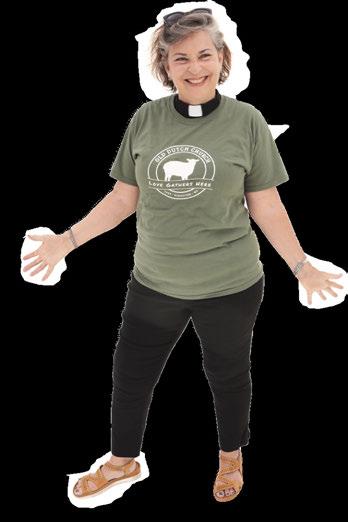
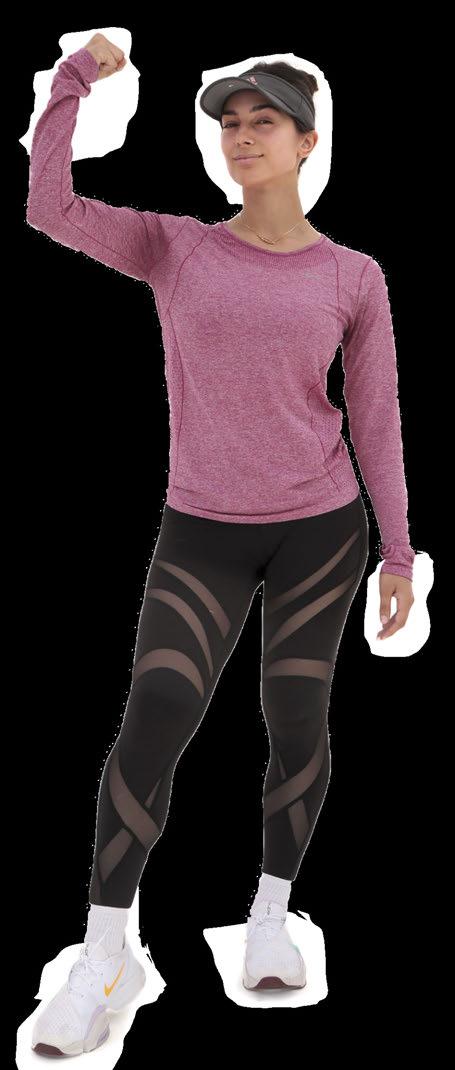



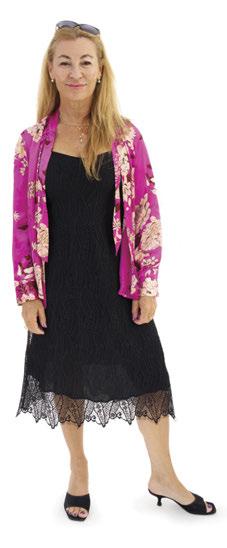
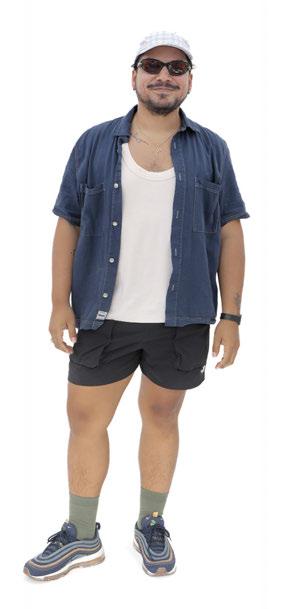
Bottom row: Rev. Liz Estes, Old Dutch Church; Charlotte Murray, teacher and Zach Murray, medical laboratory scientist with Izzy and Julian Murray; Sherri Cohen, artist.
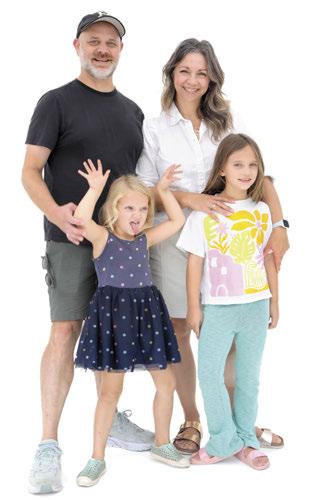
Prior to the construction of the New York State Thruway, Route 9W was the primary route for car travel between New York City and Albany west of the Hudson River. Today, it remains an important connector for the Hudson Valley, whisking travelers between the river towns of Rockland, Orange, Ulster, and Greene counties.

1441 Route 9W, Marlboro (845) 236-4177
Encorerest.com
Offering modern take on ItalianAmerican culinary delights with warm hospitality and a memorable dining experience. Situated in the heart of the Hudson Valley, we source the freshest ingredients from local farmers and suppliers.
Chef/Owner Vincenzo Incorvaia creates specialty dishes that truly capture the flavors of the season.


158 Partition Street, Saugerties (845) 633-2295
Wardellstudios.com
Handmade pottery, jewelry, woodwork and paintings are featured in our little blue shop & studio conveniently located next to Stella’s Station in the heart of Saugerties Village. Owners Lorrie and Michael Wardell create mugs, pet bowls, fountains, rice bowls, spirit houses, enamel and sterling earrings and more. Open Friday-Sunday 11 to 6.

159 Broadway, Newburgh, NY (845) 245-4291
hvhouseparts.com @hudsonvalleyhouseparts
HVHP’s goal is to provide affordable house parts for our local restoration community, as well as unusual and high-end architectural salvage items for the Hudson Valley area. Most of our architectural salvage items are oneof-a-kind, and we love hearing about preservation projects going on in your own historic homes. Come visit us in Newburgh to explore our multi-floored warehouse full of architectural salvage.
11 Simmons Plaza, Route 9W, Saugerties (845) 246-3001 brickyardpizzany.com
A family owned restaurant and pizzeria located in Simmons Plaza on Route 9W in Saugerties. They offer a diverse menu of specialty pizzas, traditional Italian dishes, and American favorites. They are proud to offer a variety of delicious vegan options as well. They deliver throughout Saugerties and Lake Katrine. Stop in to try some of their best-selling dishes like the Crispy Eggplant Stack and Garlic Knot Meatball Sliders! Their full menu can be found on their website. Open Monday-Saturday 11-9 and Sunday 12-8.


(Tall Owl Music)
Any list of under-heralded local treasures must include at the very top Hudson’s remarkably talented David Garland, who has called the region home for many years now. Emerging in the fertile early ’80s Downtown New York scene as a multi-instrumentalist and resourceful composer of wry, postmodern art songs, his work has been complimented by a wide range of parallel activities: magazine editor, art director, writer, and, very notably for fans like myself, a three-decade run as a sublimely eclectic host for New York public and noncommercial radio stations, shifting his exceptional “Spinning on Air” program to podcasting after his retirement from WNYC in 2015. Garland remains an enormously prolific recording artist, and the two-CD Flowering Flows is a compelling addition to his burgeoning discography.
(Wrong Speed Records)
Although ostensibly still based in San Francisco, where they were founded in 2002, innovative experimental underground band Enablers features a recent Hudson Valley transplant in its ranks: guitarist Kevin Thomson, who relocated to Kingston a couple of years back (the former member of Timco, Nice Strong Arm, and other projects also performs under the name Hazel Atlas). Some Gift is the group’s seventh album and, much like their earlier work, is a heady, hypnotic, and frequently heavy trip that finds the effects-drenched instruments of Thomson (who doubles on lap steel) and fellow guitar man Joe Goldring (Swans, Toiling Midgets) weaving watery atmospherics around the spoken wordage of poet and frontman Pete Simonelli. Tracks like “Phone Blows Up,” “Suburban Death March,” and “Willard to Kurtz” channel Jim Thompson and Jim Morrison meeting up on a dark postpunk trip—one very much worth taking. Acolytes of Slint or Protomartyr, dig in.
—Peter AaronThe entire album (less Julian Lampert’s resonant double bass cameo on “The Tonic”) is drawn from tones created by a 12-string acoustic guitar modified by Garland’s son and frequent collaborator Kenji into an engine for sympathetic vibrations—at once consonant and clangorous. Pieces build from silence into multitracked layers of pure—and not-so-pure—overtonerich drones that suggest several early Eliane Radigue electronic works overlaid, although Garland is realizing his sonic architectures acoustically. Sideband melodies abound, harmonies both wide and a semitone or less apart convey a sense of form that’s both monumental and intimate. Pieces like “Undiminished Gift” roar with a thick, enigmatic, and almost metallic intensity. Austere on the surface, Garland’s ecstatic textural explorations on Flowering Flows are as dense, exquisitely beautiful, and occasionally treacherous as a teeming rainforest.
—James Keepnews
The Parlor’s latest album, their 11th, finds them moving away from their earlier neofolk tendencies and fully embracing a unique blend they call “psychedelic dream-pop.” It’s as good a term as any to describe their combination of pop melody, electrotextures, and trip-hop rhythms. Based near Albany, the husbandand-wife duo of Eric Krans and Jen O’Connor could be the bastard offspring of Fleetwood Mac and the Eurythmics, reconceived for the 2020s. “The Cloud of Unknowing” sounds like Julee Cruise covering a John Cale love song backed by Mercury Rev, with a lovely chamber-pop arrangement featuring synths and strings. “Oceans” offers a more mainstream, hook-filled pop rock tune with washes of electronic fuzz and a major nod to the Mac’s “Dreams.” Hints of the Arcade Fire’s groove-powered art rock vie with ethereal vocals and dreamy soundscapes. Clocking in at 43 minutes, the gorgeous album was clearly conceived as an old-fashioned vinyl LP.
 Seth Rogovoy
Seth Rogovoy
Each month here we visit with a member of the community to find out what music they’ve been digging.
Given that I host a radio show that focuses on music in the Hudson Valley, I listen to a lot of music from musicians in our area and those coming to perform here. I’ve been enjoying lots of new music releases this year from artists such as Larry Campbell and Teresa Williams (Live at Levon’s), Club d’Elf (You Never Know), James Maddock (Night Work), Scott Petito (Many Worlds), Carolyn Marosy (Loners, Misfits & Rebels), Annalyse and Ryan (Trilogy), Sarah Fimm, David Baron, and too many others to list here. Part of my listening to music is through going out to experience it at our world-class area venues. Recently, I saw
Tuba Skinny at Colony; Nduduzo Makhathini at the Falcon; Happy Traum and Friends at Maverick Concerts; opera, theater, and orchestras at Bard College’s Fisher Center; and Kurt Rosenwinkel, Samara Joy, Tower of Power, and Bonnie Raitt at the Saratoga Jazz Festival. I’m looking forward to seeing the Squirrel Nut Zippers at Levon Helm Studios on November 11. The Woodstock Film Festival is an annual event that I thoroughly enjoy attending. It’s hosting extraordinary live music performances this year, in addition to countless films. There is a new venue open in Saugerties called the Local, which has quite the eclectic lineup on its calendar. We are beyond lucky to live in an area that’s so culturally rich and filled with outstanding music venues, museums, and theater.
Rita Ryan is the host of “LocalMotion” on WVKR (Wednesdays, 4-6pm) and a New York Blues Hall of Fame inductee. Wvkr.org

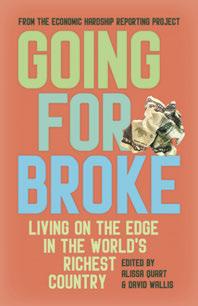 Edited by Alissa Quart and David Wallis
Edited by Alissa Quart and David Wallis
HAYMARKET BOOKS, 2023, $19.95
Hudson Valley-based editors Alissa Quart and David Wallis, of the Economic Hardship Reporting Project, have compiled an anthology of essays, documentary poems, and photographs offering political and social commentary from those on the bottom of the social ladder. In this collection, previously homeless veterans shed light on drug addiction and PTSD, while retail and assembly-line workers lay bare the struggles of unemployment and health care inequality. Whether it’s false border detainment, COVID unemployment, or disability rights, this book doesn’t hold back. By representing these stories, Going for Broke: Living on the Edge in the World’s Richest Country employs individual voices to expose the punitive social systems sabotaging millions of Americans.
More Borscht from a Catskill Mountain Plumber
Allen J. Frishman
INDEPENDENTLY PUBLISHED, 2023, $19.95
In this sequel to Tales of a Catskill Mountain Plumber, Allen J. Frishman again assembles a collection of anecdotes featuring the quirky–yet very real–characters of the Catskills. Written in a personal style, this book blends Borscht Belt humor, historical record, and nostalgia into a single charming mix. Learn about Shimmy the Pickle Man, the Bagelman sisters, the Lebed’s drugstore heist, the art of plumbing, and catching fish in the Neversink River. Along with outlandish tales, More Borscht includes a glossary of translations for the Yiddish-impaired, as well as images of Catskills memorabilia drawn from Frishman’s personal collection.
Between Monsters and Marvels

Alysa Wishingrad
HARPERCOLLINS PUBLISHERS, 2023, $19.99
This New Paltz-based author’s fantastical stories invite young readers to tackle themes of equity, truth, and power. Wishingrad’s debut novel, The Verdigris Pawn, was a 2021 Junior Library Guild Gold Standard Selection, and her latest work lives up to the legacy. In this novel, middle-grade readers can follow the story of Dare Coates, a young girl seeking to uncover the mystery behind her father’s death and the reality of the monsters he taught her about. On the island of Barrow’s Bay, colorful characters lighten up the twists and turns of this invigorating fantasy-mystery hybrid, which asks us to interrogate everything around us.
Immigrant Prodigal Daughter
Lucia CherciuKELSAY BOOKS, 2023, $23
Romanian-born poet Lucia Cherciu captures homesickness and loss in this collection of poems about the immigrant experience. Cherciu—a Dutchess Community College professor of English who served as the 2021-2022 Dutchess County Poet Laureate—is not shy about depicting the somber realities of feeling like a stranger in America, including all of her internal pressures. But along with melancholy, Cherciu also sprinkles in hope and optimism, enshrining tender moments and memories in bittersweet poems like “Ode to Romanian Old Women.” Ultimately, Immigrant Prodigal Daughter offers a raw and intimate look at one woman’s lived experience, including all its losses and victories.

The Mare Seth C. Martel
GRAPHIC MUNDI/PENN STATE PRESS, 2023, $19.95
From writer and illustrator Seth Martel, a Poughkeepsie-raised SUNY New Paltz grad, this graphic novel tells the tale of troubled young Indigo, as she grapples with family and friendship during the day and the supernatural at night. Indy believes that the stress over the loss of her job and her father’s divorce is causing her to suffer from sleep paralysis. It’s not until she confides in her best friend that she learns about the Mare, a spirit that saps its victims’ energy at night. Martel’s art, mostly black and white with sparing use of color, acts as a powerful vehicle for the macabre.
 —Ryan Keegan
—Ryan Keegan

Lydia Davis
BOOKSHOP EDITIONS, 2023, $26
Lydia Davis’s new story collection displays her virtuosity with parlaying the quotidian into the fascinating. Each story ranges from a few lines to a few pages, with subsets revisiting topics of particular resonance—brushes with fame and marital dissonance. Many stem from observations of daily life, whether at her home in Rensselaer County or while traveling. Davis writes with clarity and precision, transforming seemingly banal topics and compressing character sketches in a few choice words, like in “Master Builder”: With most excellent workmanship / he is up there on his ladder, / carefully ruining the oldest house in town.”
If you happen to live in the Hudson Valley, many of these stories will ring bells. In “The Sounds of a Summer Afternoon,” Davis describes a hierarchy of noises heard on a given day—how the drone of a riding mower drowns out the roar of a nearby dragstrip. But when both are silent, one hears target practice, or crows crowing, or neighbors bickering, or bugs buzzing, or a housemate reading, revealing a neurosis, and heightened state of attention, that can afflict us all. I just noticed the faint but distinctive sounds of a pickle ball tourney taking place about a half mile away, carrying over fallow fields and neighbors’ yards.

So much of literature takes its form in narrative paragraphs. Davis also writes in full paragraphs, of course, but she shatters this norm, not only in her haiku-length stories, but in pieces that are essentially lists. “Pardon the Intrusion,” on the longer side at 21 pages, reads like a neighborhood page on social media, noting items or services needed or unwanted. They range from bizarre, to ominous, to hilarious.
“We are looking for nurses interested in working this summer at a local Extreme Ballet camp. Email us for details.” “For sale: rollerblades, women’s size 6, black, including knee and elbow guards, and instructions. Used once.” “More Corrections” comprises a list of edits one might receive from an editor, displaying the secret power of this specific jargon: “stet caps on Navy,” “take out little girl in blueberry bush.” She captures the sartorial details that contribute to the meaning and tradition of a wedding, such as “a full-skirted dress of polished cotton in deep forest green” worn by the bride’s matron attendant, while the bride’s mother wore “a dress of Dior blue silk faille.” More than providing a snapshot of the event, cumulatively these lines craft an inquisition into the significance and artifice of marriage itself, and of economic and social status embedded in the attached rites. A similar process takes place in “Learning to Sing,” albeit more fully explicated. It traces the actions of a person (“You”) who joins a neighborhood avocational singing group. You takes singing lessons to improve, thinking it can only help, but the process leads down a path strewn with obstacles: breathing problems, how You holds their body and neck, carrying tension, what are the root causes for carrying tension, why You is so self-critical, has dry throat, and the medical reasons and fixes for that. This all leads to a recital and the accompanying dread and nervousness, but You sings satisfactorily. Eventually, You sees another musical group perform, including a woman who has no skill but sings with vigor and joy. On the whole, Davis focuses on her immediate surrounds and the objects and actions that populate it. She wanders into political satire once, in “How He Changed over Time.” The parable concerns a man who has devolved from being cultured, philanthropic, sporting, lean. He replaces the replica portraits of his idols (Francis Bacon, Isaac Newton) with poor portraits of himself, rejects new knowledge, emptying his bookshelves and painting them gold. He loses interest in fine cuisine, instead subsisting on the same cuts of meat, plain bread, and sweet drinks. This certainly unhappy man would undoubtedly declare himself happy. It reads like an absurd fairy tale, but one which is nauseatingly real.
Davis makes another kind of statement with the release of Our Strangers. She is making it available for sale only at indie bookstores and on Bookshop.org, and not on Amazon.com, which she believes has too much dominance in the field. It is the first volume to be published by Bookshop.org under the imprint Bookshop Editions. Davis’s prominence as an author should draw deserved notice to the site, which allows readers to designate a local independent bookstore to receive the profits from purchases.
Lydia Davis and will read and sign Our Strangers at St. Gregory’s Church in Woodstock on October 14 at 2pm. Sponsored by the Golden Notebook.
—Susan YungAfter Moving to New York
I didn’t think they would allow it. I didn’t quite believe that the grey interstates above were made of the same scattered light that used to watch over me (but not too closelymore of an aunt’s gaze than a mother’s) changing hue with the sun’s location, hosting rainbows and thunderheads, the occasional tornado. Or peering through the lacy canopy of leaves.
Looking up those vertical hallways—raindrops searching for soil and seeds, tributaries or tongues—I ducked behind the huge glass door and considered the possibility that I had not, after all, left the planet.
—Skye GilkersonGown
She rises from the sheets of our bed wearing nothing but a gown of morning light
—Ryan Brennantinderbox
You can’t fault me for thinking that every little ache ’n pain is my last. I mean, look around! Only half of us are left if that. There’s been a lot of dying of late and it hurts near my heart or what’s left bereft of plays and promises.
Road kill and compromise, tomorrow’s actions turn away from the pillaged wine and abhorrent fact that we failed those innocents we once called infants.
The best of us failed and the rest of us followed. Aloof to a world on fire.
—Mike JurkovicI would never Kiss you on the lips
My dear true friend
I would never hold your embrace for long I would never whisper in your ear I love you My dear true friend
—Lisa MerksamerSeen/Scene
Am I passing you, or is it the other way ‘round? Lines of sight collide on a cresting highway of hurt
Are you here for me, or do I have it all backwards? Once again we bloom
In quarters too cramped for comfort
Why we are drawn to this fray, this crush of precisely planned accidents? Like magnets spinning lazy We push til pull whirls ‘round
When at last we head home together, each gives up one by one Til we’re left just the two of us Unsure if we’re hungry or whole
—Cole Sletten EDITED BY Phillip X LevineMuhheakunnuk
Not a love letter today
I want to show you my respect
You felt rough
Made it tough to swim across
Felt like clothes in a washing machine
It was hard, was all I could say
Tried to go smooth
Tried to find my rhythm
Feeling standstill while steadfast
Worked out, I made it
Despite being so in my head
Not anxious about you perhaps
Before colonization and your naming after Hudson
You were called The River That Flows Both Ways
Great Waters Constantly in Motion
And that is what you are
You show your greatness and your current
Life lives through you
You are ebb and flow
Both/and
Let me feel it through you
Feel your beauty, your scale, your motion
Joy and sorrow
Turn towards
I am in awe of you
—Heike Jenss Memories
We had come far
That summer
Two thousand hot miles
Traveled together
The sun in our eyes
Our plans made in another world
Under the leafy arch
Of Washington Square Park
I hear the sound of sand under your foot again
And we are in the high desert
The dry red desert
Sandstone orbitals once underwater
Frame a scudded sky
Now nothing
But the dry wind
The salt
I thought I knew you then
Forgive me
—Augusta
BlockI saw my mother. She was at a party, laughing and talking, with a plate of food in her right hand. In the dream she looked to be in her 40s or 50s—vivacious, the way she was before she retreated first to a chair, then to a hospital bed and all the while to a place I couldn’t reach.
I sat in a corner, watching. A sweet dog slumped across my lap, with her head and paws draped over my legs. She seemed deflated and I wondered if she was sick. Still, I didn’t move, the better to hold close her warmth and softness. Then she was gone. She must have slid off and slunk away while I savored the moment. I tried to find her but soon realized I never would. And then the images, the story, vanished too as I awoke into a well of disquiet.
—Sue
BooksMisgiving
I gave you a stone
You promised not to throw it at me I gave you a page
You said you’ll write on it I gave you my opinion
You said
You don’t understand me And you threw the stone at me
—Ze’ev Willy Neumann
Road Rage
Driving into traffic
I cut a guy off my mistake sparks his anger no surprise but the intensity is so alarming it lives like a storm follows me down the road at a traffic light stop he gets out of his car calling me out calls me “tough guy” startled I try to apologize he’s not having it no harm done yet the rage I caused blows me away!
—C.
P. MasciolaFull submission guidelines: Chronogram.com/submissions
Waking
If you’re lucky, there’s the glitter of a dream, A minnow’s flash of silver through your body’s soft net, But more often there’s simply nothing,
And your sleep is only a tunnel through the eyes
Brief closure, whose end is when you are again Wrapped in the familiar blanket of the self. In a dawn soaked room
Each thing, from the stale glass of water on the bedside table, To the book left open on the tangled sheet, becomes another Cloud in an unchanging range of sky,
The bearers of a weightless logic. You can see from bed That the potted orchid near the window has opened While you were sleeping.
—Nicholas Pagano
DB
A long driveway will tell you who you love.
—Gary Barkman
Decay— it lies there under the white of fresh snow fall as the white of fresh snow falling.
—Daniel Brown
Autumn Descent
Having been adrift leaves spoon each other on ten stone steps descending the park’s grounds.
—Diane Webster
The Work of a Poet
A touch—the ushering in of some mood—a dazzling, awakening quietude.
—Christopher Porpora
Thirst
Thirst is the worst, a relentless dearth of what’s essential; when you long for water you feel you’re not long for this earth. Spit won’t cut it. Only thing harder to bear is no air.
—Patrick Walsh
Sentinel Blown back
By western winds
Sweeping gnarled cedar roots, Sand-anchored, shoring riverbanks In place.
—Tina Dybvik
Nos Novato became the Phoenix and we, from ashes reborn begin at the start
—Brian Gallio
Untitled
Come back in a day You’ll fall forward a night
—J Sweet
It’s certainly been an amazingly unpredictable life journey for Rhinebeck resident Hilarie Burton Morgan: MTV VJ, acclaimed actor, TV host, bestselling author, producer, podcaster, farmer, small business owner, mom, activist, philanthropist—and witch (the good kind, that is).

“Self-identifying as a witch is an act of rebellion,” she writes in Grimoire Girl: Creating an Inheritance of Magic and Mischief, her newly published second book. “And a grimoire is a testament to your power and your craft.” Loosely intended as a repository of remembrances and a compendium of accumulated knowledge and life lessons to be passed down to future generations, the aesthetically beautiful volume is her spiritual scrapbook. A poetically assembled life guide/memoir, it is brimming with methods and meditations on mythology, astrology, folk medicine, spells, muses, potions, recipes, ancient
country wisdom, and other arcane ephemera.
Born in Sterling, Virginia, in 1982 to an Army-vet father and a real estate-agent mother, the television/movie/media star is the eldest of four children. (She has an older half-sister from her father’s previous marriage.) Living the characteristically wholesome the life of an all-American teenage girl, she was class treasurer, student council president and vice president, captain of the cheerleading squad, and homecoming queen at her high school. But the pull of the theater had taken hold well before her teenage years, with the then Hilarie Ros Burton taking her first local steps into acting at age eight.
Upon graduation, it was up to New York to attend Fordham and NYU. After she’d made the hectic rounds of multiple other auditions, she got her first big break with a slot as a commentator for a segment on MTV’s “Total Request Live.”
The channel’s producers were so impressed with her outgoing style that they decided to make her a full-time VJ on the show, and soon she was also hosting the 2000 MTV Video Music Awards, the channel’s much watched “Iced Out New Year’s Eve” special, and other programs. She made her network television debut in 2002 with a minor part on an episode of The CW’s “Dawson’s Creek,” but her next role would be the breakout score that would make her a generational star.
“One Tree Hill,” a drama set in contemporary Wilmington, North Carolina, that focused on the lives of two basketball-playing half-brothers and their romantic relationships, premiered in September 2003. The series saw Burton cast as the visual artist, musician, and cheerleader Peyton Sawyer, a complex persona that drew from her own Southern-small-town-cheerleader beginnings. A runaway smash, the show ran for
nine seasons, and Burton’s character became iconic among its mainly teenaged viewers, landing her on the covers of national magazines and earning her three Teen Choice Ward nominations. Between episode tapings, she appeared in her first feature film, 2005’s Our Very Own, another small-town-young-adult story, and the 2007 Lifetime drama Normal Adolescent Behavior. Burton Morgan left “One Tree Hill” in 2009 as her film career began heating up, forming her own production company, Southern Gothic Production, and appearing in such movies as Solstice (2007), The Secret Life of Bees (2008), and Bloodworth (2010).
In 2009, her life changed again when she and “The Walking Dead” star Jeffrey Dean Morgan were introduced and became an item. The couple’s son, Gus, was born in 2010, daughter George arrived in 2018, and the pair married in 2019. It was the birth of the latter child that helped spark the idea for Grimoire Girl. “Once my daughter, George, was born, I started collecting scraps of information, quotes, book excerpts, and other pieces of knowledge in a leatherbound journal with creamy thick pages and irregular edges,” Burton writes in the book’s preface. “A grimoire of ideas and habits I wanted her to have.” But at that point neither family bliss nor the start of the book project would keep the actress away from the screen entirely.
Shifting back to TV but even further from coming-of-age castings, she moved into crime and medical dramas, starting in 2010 with the recurring and regular role of insurance investigator Sara Ellis on the USA Network’s “White Collar.” In 2013, following a 2012 guest appearance on ABC’s “Castle,” Burton played Dr. Lauren Boswell on the same network’s wildly popular “Grey’s Anatomy” in its ninth season for three well-received episodes; that fall brought another recurring role, that of Samantha on NBC’s short-lived “Hostages.” The briefly running science fiction series “Extant” (one season, 2015, on CBS) saw her reunited with her “One Tree Hill” costar Tyler Hilton. Her next high-profile role, for two seasons (2016-2017), was as Karen Palmer, a DEA agent and love interest of main character Martin Riggs on Warner Bros. TV’s “Lethal Weapon.”
By that time, however, the new mother and her husband, then living in Hollywood, had grown weary of the Tinseltown grind, an under-theboom-lights existence that saw added cathartic drama in 2017 when Burton spoke against sexual harassment she had experienced from actor Ben Affleck during a 2003 MTV appearance and similar abuse that some of the “One Tree Hill” crew had endured from Mark Schwann, the show’s creator. With her husband’s star rising with “The Walking Dead” (on which she’d eventually play Lucille, the wife of Morgan’s character,
Negan, for the 10th season) and Burton looking to lessen her acting work, the country life the couple had long fantasized about was beckoning.
on the project. “Not only did they move to the community,” James McGuirk, the Astor Home’s executive director and chief executive officer, said to the Poughkeepsie Journal in 2017, “they basically adopted the community.”
Moved to chronicle their idyllic and more meaningful new lifestyle, Burton penned her first book, The Rural Diaries: Love, Livestock, and Big Life Lessons Down on Mischief Farm “From the realities of farm living, home renovations, and the struggles of growing a family and finding her footing after heartbreak, Hilarie’s warmth and humor are on full display,” raved Country Living upon its release. “The Rural Diaries reads like a favorite girls’ night chat.” Published in 2020, at the height of the pandemic, the work became an immediate bestseller, and with its success, Burton, while also working with local business relief organization Rhinebeck Responds, moved to further help her family’s Dutchess County hometown. She asked her fans to purchase signed copies of the book from long-running shop Oblong Books, which, like so many other area merchants, was struggling during Covid. The drive, along with PPP assistance, helped keep the store’s staff employed during the crisis.
In 2018, they realized their shared dream of buying a farm when they purchased the 100acre Rhinebeck spread—complete with cattle, chickens, donkeys, alpacas, llamas, and other animals—that they dubbed Mischief Farm, after two identically named pet headstones found on the property. They fell in love with their new hometown, helping to save beloved candy store Samuel’s Sweet Shop by becoming co-owners of the business, along with fellow local actors and power couple Paul and Julie Rudd, after the shop’s original owner, Ira Gutner, had died and left the confectionary’s future uncertain.
“Our childhood homes were destroyed,” Burton told “CBS This Morning Saturday.” “The small towns disappeared, the mom-and-pop shops disappeared. Everything got replaced by big, massive chains. When we found this community that was all mom-and-pop shops, it was so important to us that we preserved it and that we honored it in a way that [showed that] maybe other people [also] saw that value in it.” Among more local causes, the Burton Morgans also took an interest in the effort to renovate the Astor Home for Children, a residential treatment center for kids, and volunteered to do physical work
“I really wanted to prove to the people in our community that we meant it,” she told “CBS This Morning Saturday.” “That it was coming from a place of love, a place of humility… I found so much self-worth in this community that I hadn’t found in work. Thankfully we live in an area that really values [keeping small towns afloat]…Rhinebeck can be a model for other towns something like this, a roadmap. I would love to see every small town like this, rehabilitated.”
From their living room during the Covid quarantine, Burton and her spouse cohosted the AMC series “Friday Night in with the Morgans,” which saw them welcoming guests virtually to offer mutual moral support to each other and viewers and to discuss a range of issues that included the BLM and #Metoo movements and pandemic life. She also entered the podcast realm, appearing as Shelly Hoskins on the fictional series “Bridgewater” in 2021 and that year launching “Drama Queens,” which she cohosts with her fellow former “One Tree Hill” stars Sophia Bush and Bethany Joy Lenz. Currently, the busy Burton is back in the spotlight, promoting the bewitching Grimoire Girl just in time for Halloween—but always keeping it close to home.
“Home is the cornerstone of magic, after all,” she writes in the book’s prologue. “It is safety. It is comfort. It is sacred and divine.”
Presented by Oblong Books, Hilarie Burton Morgan will host a launch event for Grimoire Girl at the Bardavon in Poughkeepise on October 8 at 3pm. Tickets are $42 and include a signed copy of the book. Bardavon.org.


November 28-May 27, 2024
The first major American retrospective of Leo Lionni, a groundbreaking modernist graphic designer and magazine art director who gained worldwide popularity as the writer and illustrator of nearly 40 children’s books explores the artist’s vision and legacy across three distinct yet interrelated domains: graphic art and design, children’s books, and personal works in various media at the Nor man Rockwell Museum in Stockbridge, Massachusetts.
November 4-5
Beacon takes its name from the signal fires lit atop Mount Beacon during the Revolutionary War. The city’s current resident creatives have seized on the fire metaphor for a weekend of performance and celebration. Now in its third year, Beacon Bonfire presents two days of immersive programming and activations at 23 venues across the city, featuring 150 performances from music to theater and more.
After a trepidatious post-pandemic return a year ago, summer arts events came roaring back to the Hudson Valley in a big way in 2023. This year, it felt a lot like it did in summers past: With so many incredibly interesting things going on, it was hard to choose exactly which ones to do—always a great problem to have. But even now, with the changing of the seasons, the party is by no means over. In fact, this fall’s looking a lot like a welcome continuation of summer’s happy trend of offering more happenings than any one calendar can hold—why, it’s a cornucopia of coolness!
Are you looking for concerts? How about comedy? Cabaret, you say? Or maybe theater? Or are you interested in seeing some inspiring new or historic visual art or partaking in a fun fall festival? Once again, our Fall Arts Preview has the rundown. As autumn’s leaves amass at your feet, let Chronogram be your guide to all that’s good.

October 6-8
Kingston’s 13th annual festival elevating the exchange of art, music, and wellness takes over the town this month, featuring live appearances by comedians like Bobcat Goldthwait and Amy G; live music by Amythyst Kia, Gail Ann Dorsey, Cassie Blanton, Amber Rubarth, Delicate Steve, and others; spoken word by Richard Buckner, Carolita Johnson, and others; art by Mahogany L. Browne and many more; and wellness clinics and practitioners.
October 6-22
The third play in playwright Dominque Morriseau’s Detroit trilogy, “Skeleton Crew,” presented this month at Shadowland Stages in Ellenville, has been called “warmblooded, astute, deeply moral, and deeply American” by the New York Times. The tale, which takes place in 2008, follows the lives of a make-do family of auto workers as they deal with being trapped in a collapsing economic system and “the line between blue collar and white collar becomes blurred.”
David Cross
October 7
With the SAG-AFTRA strike still happening at the time of this writing, alternative comedian and comedy writer David Cross (“Mr. Show,” “Arrested Development”) has pivoted to the standup he does so well for this riotous evening at the Bardavon in Poughkeepsie. Cross will donate $2 from every ticket sold for the 18+ show to the Innocence Project, which works to free the innocent and wrongfully convicted. 8pm.
October 10
The small Catskills town of Andes boasts one of the region’s coolest bookstores: Diamond Hollow Books. The shop will be packed with literary star power when Jonathan Lethem and Sean Howe get together to discuss their new books, both of which offer rollicking riffs on America in the `70s. Lethem, best known for his coming-of-age novel Fortress of Solitude, will read from his new book Brooklyn Crime Novel. Howe will read from Agents of Chaos: Thomas King Fourcade, High Times, and the Paranoid End of the 1970s
October 14
“Chinwag” is a new hit podcast featuring award-winning actor Paul Giamatti and professor of philosophy Stephen Asma that finds the pair delving into and discussing deep and fascinating topics from well outside the mainstream. Here, Giamatti and Asma come to Mass MoCA in North Adams, Massachusetts, for a live taping of an episode focusing on Nostradamus, clairvoyants, and prophets. Expect some unforeseen tangents.

October 20-29
The long-running Chatham-based film fest returns with an opening weekend screening of Laura Gabbert’s documentary Food and Country , featuring Ruth Reichl. The food maven, who lives in Columbia County, will be on hand to discuss the country’s broken food system. The curated selection of more than 40 of the best domestic and international features and documentaries includes many fresh from the festival circuit that have not yet opened commercially, like Todd Haynes’s new film starring Julianne Moore and Natalie Portman, May December
October 20-29
Acclaimed artists David Cale, Dael Orlandersmith, and Matthew Dean Marsh and director Robert Falls make their way back to the Ancram Opera House in Ancram with a fully staged production of their moving new work, “You Don’t Know the Lonely One,” a story and song cycle inspired by paintings and albums that weaves a collective portrait of loneliness in an ever-changing society.
October 27-November 12
Presented by Performing Arts of Woodstock at the town’s Mescal Hornbeck Community Center, “Sweet and Sad” is the second in playwright Richard Nelson’s celebrated series about the Apple family, a clan who live in contemporary Rhinebeck. In the story, the Apples gather for dinner on the 10th anniversary of the 9/11 attacks and navigate the changes between each other and the world around them.
Through October 29
Staged all this month at the rustic Unicorn Theatre in Stockbridge, Massachusetts, is the Berkshire Theater Group’s production of Michael Frayn’s Tony Awardwinning play “Copenhagen.” Directed by Eric Hill and described as “a must-see for anyone interested in history, science, or politics,” the play is set in Nazioccupied Denmark during World War II and is a gripping exploration of the ethics of science and the consequences of humanity’s actions.

October 9
In this documentary, legendary singer and activist Joan Baez takes an honest look back and a deep look inward as she tries to make sense of her large, history-making life, and the personal struggles she’s kept private. After the screening at the Jacob Burns Film Center in Pleasantville, Baez will be on hand for a Q&A. The film is part of a chockfull fall season at the center, with screenings of firstrun films like Killers of the Flowers Moon alongside cult and horror classics like The Wicker Man and American Psycho
November 10-11
Los Angeles-based dance troupe Bodytraffic has made waves from coast to coast with its varied repertoire of contemporary works. Artistic Director Tina Finkelman Berkett leads a masterful troupe, all nimble interpreters of each choreographers’ distinct vision, this absorbing, thought-provoking, and vividly theatrical company assures an entertaining evening of dance at the Mahaiwe Performing Arts Center in Great Barrington, Massachusetts. Surprising and unforgettable, Bodytraffic is “one of the most talked-about companies nationwide” (LA Times).

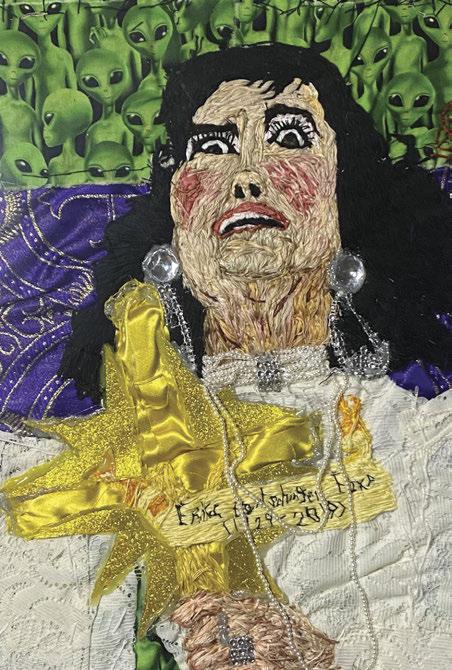


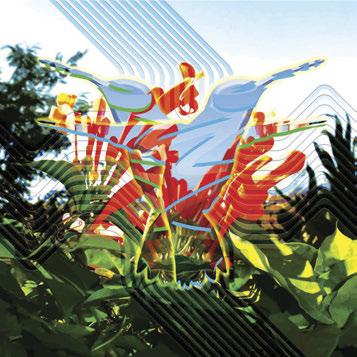
November 4-10
This fall marks Kingston juried art show and sale Fall for Art’s 27th year of showcasing and supporting talented Hudson Valley artists. Sponsored by the Jewish Federation of Ulster County, the virtual celebration of creativity presents a wide selection of top-tier visual art in diverse media: painting, pottery, photography, ceramics, fiber, glass, jewelry, mixed media, and more. Proceeds from the show go to local causes.
November 9-19
Bridge Street Theater in Catskill presents Lanford Wilson’s 1997 Obie Award-winning play. “Sympathetic Magic” follows a group of friends and family in San Francisco as they confront various personal crises—an unwanted pregnancy, marital strife, AIDS—against the backdrop of a discovery of astronomical (literally) proportions. Directed by John Sowle and starring Brian Sheppard, Molly Parker Myers, Timothy Dunn, Abby Burris, and Seth McNeil.

November 17
Stand-up Bee’s new live show, “Your Favorite Woman” celebrates the fact that women are really f*cking cool, despite what six Supreme Court Justices seem to think. The former host of “Full Frontal with Samantha Bee,” which ran for seven seasons on TBS, Bee brings her pointedly pro-woman comedy to the Bardavon in Poughkeepsie.

November 17
The King of Rant returns to Paramount Hudson Valley in Peekskill with his “Off the Rails” tour. Black’s trademark style of comedic yelling and finger pointing exposes the absurdities and hypocrisies of contemporary life. A winner of two Grammy awards, Black has published three bestselling books and he keeps his fans up to speed with his current annoyances via his “Rant Cast” podcast.
December 1-17
This holiday season at Shadowland Stages in Ellenville: One of the most produced plays in the country since its premiere in 2016, this hilarious sequel to Jane Austen’s Pride and Prejudice is set two years after the novel ends. Bookish Mary has grown tired of her role as the dutiful middle sister in the face of her siblings’ romantic endeavors. But things change when an unexpected guest shows up for the family’s Christmas gathering at Pemberley, sparking Mary’s hope for independence, an intellectual equal, and maybe even love.
December 11-17
Considered the leading investigative/documentary theater company in the US, New York troupe the Civilians will be in residency this December at PS21 in Chatham with “Sex Process, 1941,” a new work inspired by Dr. George Henry, who gathered life histories from LGBTQIAP+ Americans in the 1930s. It’s written and directed by the Civilians’ artistic director, Steve Cosson, in collaboration with media artist Jessica Mitrani and music director Ada Westfall, a transwoman actor and musician.
Lost Kingston: Documentary
Photographs by Gene Dauner

Curated by Stephen Blauweiss
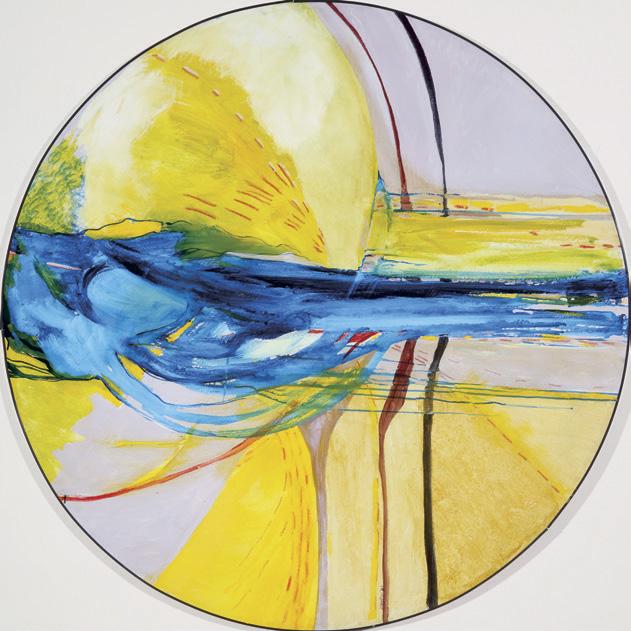
October
Greater Newburgh Symphony Orchestra presents:



Saturday, October 7, 2023 | 7:30 pm
Aquinas Hall, Mount St. Mary College, Newburgh, NY
Adam Short Ride in a Fast Machine
Dvořák Humoresque
Featuring Concertmaster, Adrienne Harmon and Principal Cello, Naomi Lisowski

Poulenc Concerto for Two Pianos Michelle Kuo and Chris Kuo, Piano
Tchaikovsky Symphony No. 4



As the only American museum exclusively devoted to Italian art, Cold Spring’s Magazzino has brought postwar and contemporary Italian culture to the Hudson Valley since its establishment in 2017. On September 14, the museum opened its new Robert Olnick Pavilion to the public, adding 13,000 square feet of exhibition space and capping the process of a substantial—and rapid— expansion.

The new building, which broke ground in 2021, was born out of a growing mission that’s developed over the last six years, explains Vittorio Calabrese, Magazzino’s executive director. Calabrese has been with the project for eight years, since its initial inception as a private warehouse (magazzino in Italian) for the vast contemporary Italian art collection of its founders, Nancy Olnick and Giorgio Spanu. The new pavilion is “a way for us to expand our programming, have additional places for temporary exhibitions, and [include] programming all year round,” Calabrese says.
The building was co-designed by architects Alberto Campo Baeza and Miguel Quismondo, both of whom have longstanding ties to the institution. Baeza designed the modernist Olnick Spanu house in Garrison for Magazzino’s founders, a building on which Quismondo was the project manager. Quismondo was also the designer of Magazzino’s initial, 20,000 square-foot structure, constructed off a renovated warehouse that was once a dairy distribution center.
“This is closing the circle in a way,” Calabrese says, adding that the Robert Olnick Pavilion has “two exhibition spaces for art, one for design, [and] one multipurpose room where we can do concerts, conferences, and movie screenings.”
Three exhibitions open the new space: one on Italian postmodern artist Mario Schifano (“Mario Schifano: The Rise of the ’60s”) curated by Alberto Salvadori; a second, also curated by Salvadori, featuring largescale artworks by Ettore Spalletti (“Ettore Spalletti: Parole di colore”); and a third (“Carlo Scarpa: Timeless Masterpieces”) which features a selection of Murano glass designed by Venetian architect Carlo Scarpa during the interwar and early-World War II period.
While the expansion on the museum’s existing collection is the centerpiece of the new pavilion, Calabrese also points to the new space’s hospitality dimension, which includes both a design store and restaurant.
Cafe Silvia, which the director describes as “a killer combination of Italian food and farm-to-table,” is headed by Milanese chef (and current Garrison resident) Luca Galli. The restaurant combines high-quality Italian
ROBERT OLNICK PAVILION OPENING AT MAGAZZINO Magazzino.art
products and recipes with local Hudson Valley produce, some of which is grown in a small garden right on the museum property. “You don’t need to get a ticket [to the museum] to eat at the cafe,” Calabrese adds, hoping it’ll attract a diversity of visitors “who don’t necessarily know about Italian contemporary art—but of course they’re big lovers of Italian food and culture.”
Over the long run, the new pavilion will also allow Magazzino, which doubles as a nonprofit research center, to expand its educational mission. “Magazzino has never has an actual space dedicated to education, only for research,” conducted through scholarships, fellowships, and collaborations with universities, Calabrese says.
By early next year, the museum plans to launch an educational department for both child and adult learning. Calabrese says that making Italian art and the museum’s programming more accessible is “pretty much the evolution of what we’ve been trying to do.”
The director expresses a debt to Robert Olnick, father of founder Nancy Olnick and namesake of the new building. “He was a visionary real estate developer and philanthropist with a very critical and sensitive eye,” Calabrese says.
A mirror painting by Michelangelo Pistoletto, of Robert Olnick and his wife Sylvia, greets visitors in the lobby of the new building. This tribute, Calabrese says, offers a fitting welcome to the new building. “[Robert Olnick’s] legacy and his values are actually translated into the project that we’re opening.”
Magazzino Italian Art is located at 2700 Route 9 in Cold Spring and is open Thursday through Monday from 11 am to 5 pm.
—Will SolomonPark Theater (October 21)
Award-winning Hudson Valley composer, vibraphonist/multiinstrumentalist, and record producer Larry Chernicoff, whose work combines jazz, classical sensibilities, and pure improvisation, is the recipient of a National Endowment of the Arts Jazz Fellowship. His 2004 album, October, was named Best Surround Sound CD of the Year by the Surround Music Awards. This rare live concert has him leading a seven-piece band of top regional players. Hudson.


Ulster Performing Arts Center (October 18)
South African-born singer-songwriter Gregory Alan Isakov has built a fervent following through steady touring and the eight albums of quiet, heartfelt modern folk that he’s released to date; 2018’s Evening Machines earned him a Grammy nomination, while his latest, Appaloosa Bones, is a collection of sparse songs inspired by the American Southwest. No strangers to Grammy nominations themselves, indie folk duo the Milk Carton Kids (pictured above) open. Kingston.
Bearsville Theater (October 12-15)
A much-awaited summit, the annual Woodstock Invitational Luthiers Showcase brings together the community of acoustic stringed-instrument makers, musicians, and collectors to see, play, and purchase fine handmade acoustic guitars and more. Live music by Sean McGowan, Tony McManus, Adam Miller, Peter Janson, and Preston Reed (October 12), Happy Traum (October 13), Peter Einhorn (October 13), Jay Ungar, Molly Mason, and Mike and Ruthy (October 15), and others. Bearsville.
Paramount Hudson Valley Theater (October 27)
Worth a deuce! The founding Kiss guitarist and Frehley’s Comet leader comes back to the area for a night of big hits by both of those bands and solo classics. The Rock and Roll Hall of Fame member played in Kiss from the group’s 1973 inception through 1982 and returned for a highly successful 1996 tour. His latest album is 2020’s Origins Vol. 2. 7pm. Peeksill.
Spiritualized
Basilica Hudson (November 8)
Headed by Jason Pierce AKA J Spaceman, the English cult psychedelic band Spiritualized was founded in 1990 when Pierce left Spacemen 3 and hit the stratosphere with 1997’s Ladies and Gentlemen We Are Floating in Space. Here, the group lands in our realm to celebrate the recent reissuing of their first four albums and the release of 2021’s mind-expanding opus Everything Was Beautiful. 7pm. Hudson.

Hudson Hall (October 20-29)
Following his successful 2017 production of Virgil Thomson and Gertrude Stein’s “The Mother of Us All” at the venue, globally acclaimed director R. B. Schlather returns to historic Hudson Hall with this staging of Handel’s 1725 opera “Rodelinda.”
“Handel is my favorite composer to direct,” says Schlather, citing the work as “an example of Handel’s genius for beautiful music, character, drama, suspense, and resolution.” See website for schedule. Hudson.
Alan Cumming and Ari Shapiro: “Och & Oy! A Considered Cabaret”
Mahaiwe Performing Arts Center (October 27)
“We’re both storytellers who try to help audiences better understand themselves and the world around them,” says entertainer Ari Shapiro (NPR’s “All Things Considered”) about “Och & Oy! A Considered Cabaret,” his new show with internationally renowned actor Alan Cumming. The evening of songs and stories is directed by Henry Koperski. 8pm. Great Barrington, Massachusetts.
City Winery Hudson Valley (November 7)
Playing an understated but powerful blend of alternative roots rock, Toronto’s Cowboys Junkies broke through with the 1988 album The Trinity Sessions and its breathy cover of Lou Reed’s “Sweet Jane” (the Velvet Underground leader called it his favorite version of the song). The band, which still contains all its original members, just released a new album, Such Ferocious Beauty 8pm. Montgomery.
Patti Smith
The Bardavon (November 11)
After an incredible 2021 show at sister venue UPAC, poet and pioneering punk priestess Patti Smith pays a visit to the Bardavon for another night of “Words & Music.” A Rock and Roll Hall of Famer as well, Smith was named one of the most influential people in the world by Time magazine and won a 2010 National Book Award for her memoir Just Kids. 8pm. Poughkeepsie.
Allison Russell
Caramoor Center for Music and Arts (December 2)
Montreal singer-songwriter and activist Allison Russell is known for her membership in the folkAmericana bands Our Native Daughters, Po’ Girl, and Birds of Chicago. Outside Child, her 2021 solo debut and home to the hit single “Nightflyer,” was nominated for three Grammy Awards. The followup, The Returner, is out this month. This concert is a benefit to support Caramoor. 8pm. Katonah.




























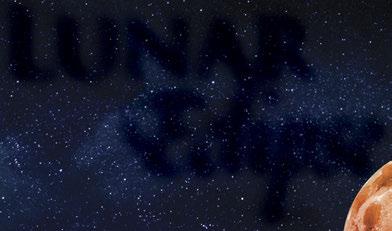





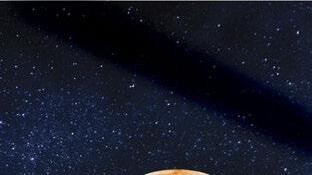













For 23 years, the Rothstein family has welcomed visitors to Race Brook Lodge in Sheffield, Massachusetts, for a mindopening experience that captures the eccentric energy of the Berkshires in a single shot. Located on 100 acres on the slopes of Mount Race, the property integrates a riverside inn, a Revolutionary War-era tavern-turned-farm-to-table restaurant, and an arts venue known for attracting a roster of acclaimed musicians, artists, and performers. This autumn, its three performance spaces will welcome a buzzy schedule of border-blurring programming from across the globe, including the can’t-miss Berkshires debut of Ghanaian hip hop performance artist Jojo Abot.
October kicks off with the world-renowned puppet theater master Julian Crouch, who will perform his groundbreaking chamber work, “Birdheart,” from October 6 to 8. Through a series of animated images built in front of the audience’s eyes, “Birdheart” creates something achingly beautiful from the humblest of beginnings: a sheet of brown paper, found objects, shadows, and a box of sand. The show, co-created with Saskia Lane, has been performed for everyone from infants to great-grandparents, and even the Dalai Lama.
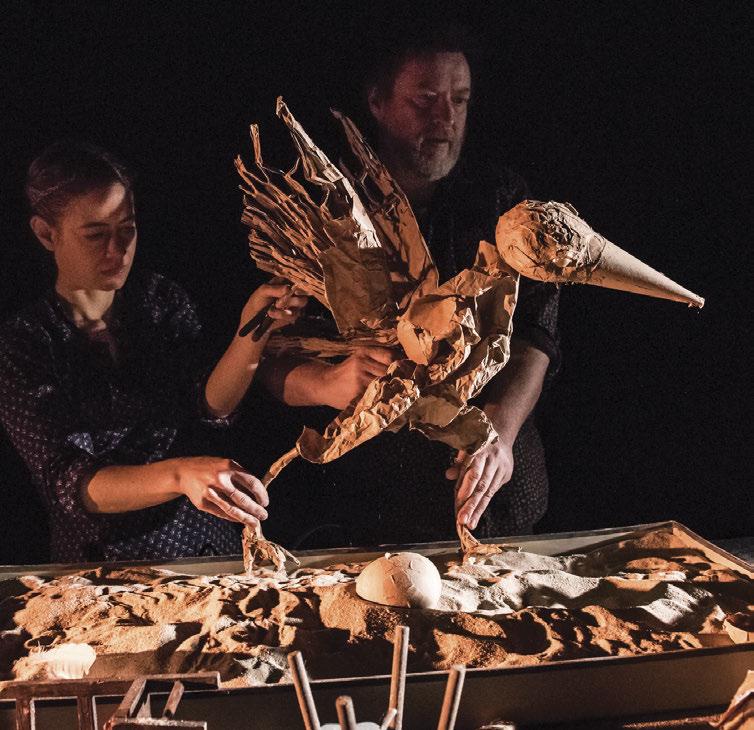
On Saturday, October 21, a Broadway star comes to the Race Brook Lodge stage: composer-singer, experimentalist, and awardwinning actress Grace McLean. Drawing from the tradition of vocalists like Bobby McFerrin, McLean multiplies her voice in electronic loops that can turn a singer into a one-person chorus.
The weekend wraps up on Sunday, October 22 with the mesmerizing duo Hinterlands. Between new music and folk trance, the performances of violinist Ben Russell and accordionist Matt Schreiber conjure a musical world where boundaries blur and new resonance is born. Both celebrated artists in their own right, Russell has toured and recorded with Sufjan Stevens, Arcade Fire, the National, and more, while Schreiber, currently pursuing a PhD in ethnomusicology at CUNY, is an award-winning Balkan-style accordionist with roots in New Orleans and cabaret.
On Saturday, October 28, as Halloween approaches, cozy up in the barn for the Spooky Silent Cinema party, a playful homage to a bygone era. The screening of The Unsilent Picture starring “the clown prince of Broadway” Bill Irwin (Mr. Noodle on “Sesame Street”) features sound effects artist Leslie Bloome performing live accompaniment to the film. An in-person artist talkback on the history of silent cinema with Bloome and director Alex Harvey will follow the screening. A showing of the trippy 1920 expressionist horror film The Cabinet of Dr. Caligari will cap off the evening.
Ghanaian hip hop performance artist Jojo Abot makes her Berkshires debut on Sunday, October 29. Abot, who has performed at MoMA, the Brooklyn Museum, the Venice Biennale, the Armory, Radio City Music Hall, and the Apollo, is an interdisciplinary healer exploring evolving themes of spirituality, identity, and community through music, film, fine art, and fashion photography. Abot will be in residence at Race Brook Lodge developing a new multidisciplinary show that will combine music, monologue, film, and plenty of outrageous, eye-catching handmade garments.

Sunday, November 5 will honor Dia de los Muertos with a day of regional Mexican dance and music from the vibrant, penetrating quartet Pulso de Barro. In the afternoon, members of Pulso de Barro will teach the dance and singing of Son Jarocho, a vernacular folk music of Veracruz, followed by a ceremonial Fandango for the ancestors in the evening that is open to all.
Race Brook Lodge’s weekly offerings continue throughout the fall, with its famed Reggae Party on Wednesday nights, local music performances on Thursday nights at its Down County Social Club, Jazz brunch on Sunday mornings, and community ecstatic dances on the third Sunday afternoon of each month.
To learn more about upcoming events at Race Brook Lodge, visit Rblodge.com/events.
A season of immersive and transformative performances comes to Race Brook LodgeJulian Crouch and Saskia Lane's “Birdheart” Jojo Abot


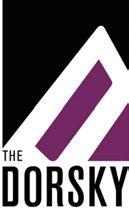
September 9 – December 10, 2023
Artists examine the Americas’ ambiguous relationship with drugs and their representation in the media and the public imagination.

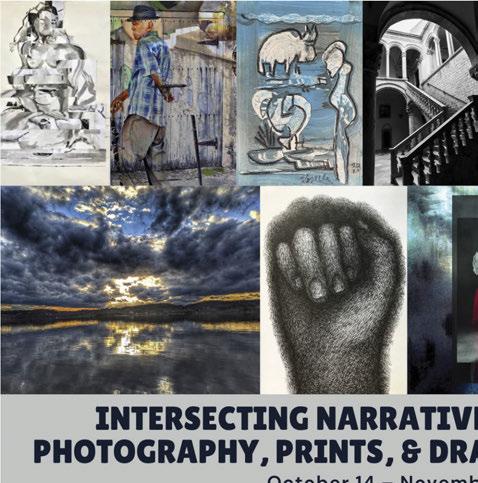



For over 40 years, the Dutch chapel in the heart of the Village of Saugerties served as a child daycare center. But soon, this quaint church building will be brimming with the sounds of music from all over the world. Recently acquired by Isabel Soffer and Danny Melnick, cofounders of the world music events producing company Hudson Valley Live, Saugerties’s 1800s Dutch chapel has now been transformed into The Local: a year-round, multi-arts venue. The upcoming debut fall concert series features 15 distinct shows from September through December.

Founders Soffer and Melnick each have more than 30 years of experience in the music industry, including producing multiple festivals, concerts, and curated arts experiences. Soffer was instrumental in developing the global music scene in America, and she’s renowned for her work as cofounder and codirector of globalFEST. Celebrated in the jazz world, Melnick has produced the Newport Jazz Festival as well as a variety of other festivals and tours through his own company, Absolutely Live Entertainment.
With The Local, Soffer and Melnick hope that they can lean on their experience in curating eclectic international music acts to help introduce new musical talents to the Hudson Valley. Melnick sums up the goal succinctly: “Let’s bring the world to Saugerties.” Arguing that there have been far too many touring and recording artists who miss the Hudson Valley, Melnick believes that The Local offers an opportunity for local residents to see these kinds of artists without having to trek out to New York City or major festivals. “These bands have had success all over the world, so why can’t they be successful here?” asks Melnick. “Why should Saugerties be different from any other place?”
Two highlights from The Local’s diverse lineup include the Wazumbians, an Afropop group from Ghana
(performing October 7, at 8pm), and Troker, a band from Guadalajara that blends psych jazz, rock, and funk with traditional Mexican music (November 12, at 7pm). Although The Local will feature a selection of uncommon acts from abroad, it will also uplift local artists during events like the John Street Jam—the long-held Saugerties tradition featuring Hudson Valley-based musicians performing folk, blues, bluegrass, and country in-the-round (November 10, at 8pm).
The Local is located at 16 John Street, behind the Saugerties Reformed Church on Main Street. Transforming the Civil War-era Dutch chapel into a venue ready for live music required three months of intense renovations. A drop ceiling, which served as temperature and sound control during the chapel’s time as a daycare, had to be removed, and the venue also needed the addition of all new lighting, electric, and plumbing. Additionally, The Local has become an ADA-accessible space, featuring a wheelchair ramp, a widened exit doorway, and an accessible bathroom.
In their quest to optimize the sonic potential of the chapel, Soffer and Melnick have assembled an amalgamation of gear from different sources around the Hudson Valley. This includes a sound system designed by Pete Caigan of Utopia Studios Bearsville in Woodstock, a Yamaha drum set purchased from Chris Bowman of CHBO drums in New Paltz, and a baby grand piano donated by Bridge Arts and Education, the nonprofit arts and music education organization in Kingston.
For now, Soffer and Melnick are concentrating on music, but the duo envision The Local as an eventual community center and space for arts and culture more broadly. “Isabel and I have heard over the years from many different people in town that they wish they had a space for things like poetry readings, or a comedy club, or karate
THE LOCAL IN SAUGERTIES
Thelocalsaugerties.com
classes,” says Melnick. The space is available to rent for anything ranging from classes on meditation, yoga, and painting, to christenings, birthday parties, or even community and private meetings. Already, The Local has opened as an art gallery, featuring work from Julia Warr and Brian Lynch, and there was also a Shaolin Qigong event with Saugerties’s Adam Ortiz back in August.
Melnick and Soffer hope that those attending the venue’s concerts will support the town of Saugerties, whether it’s by eating at local restaurants, visiting local shops, or spending the night. “We both live here and want to make an impact economically and culturally,” says Melnick. “There’s been study after study going on for decades that proves culture is a huge economic driver for communities. That’s just such a major reality.”
The Local’s first concert took place on September 20, featuring the Orchestre Tout Puissant Marcel Duchamp, a big band performing everything from jazz and krautrock to West African funk. Upcoming concerts this fall include tango with the Messiez Trio on October 13, Jazz with Allison Miller’s Rivers in Our Veins on October 28, violinist Johnny Gandelsman performing Bach cello suites on December 2, and a silent disco on December 9.
Melnick recognizes that The Local’s expansive assortment of artists may present an unknown element to audiences unfamiliar with broad-ranging global styles of music. “We know a lot of people are not going to know a lot about these groups,” says Melnick. “We’re really hoping that people will come out and trust us.”
Ultimately, Melnick hopes that he and Soffer can act as trustworthy music authorities, with combined experience in the music industry to back them up. “Isabel and I are like a live Spotify playlist. Let us be your curators, and tell you and show you that we know what we’re doing.”
—Ryan Keegan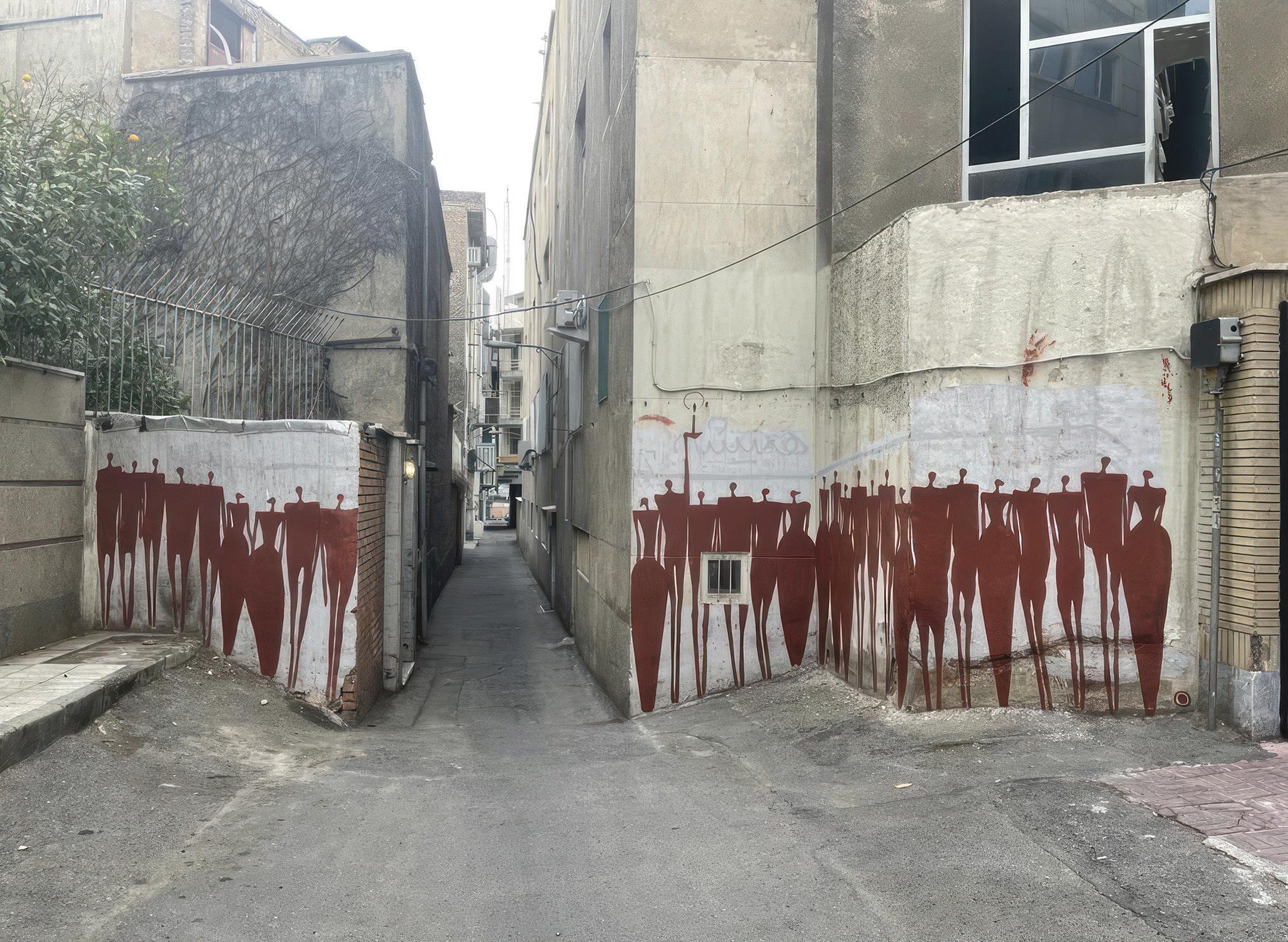

Twelve years ago, paintings began to appear on the walls of the city of Tehran. The Iranian artist, who calls himself Mirza Hamid, employed a reddish-brown paint pigment used by Paleolithic artists—the color of clay, close to the hue of dried blood. That ancestral paint has survived, in some cases, 39,000 years. But those ancient artists didn’t have to worry about the authorities erasing their work.
The New Gallery will present “The Origin of All Things,” a show of Hamid’s art, at Basilica Hudson, October 5-30.

“He does not remember how it suddenly happened that he found himself painting on walls, he does not remember the first time,” explains Haleh Atabeigi, codirector of the New Gallery, in an email interview. “But before he knew it, it took him over.” Hamid has no formal art training.
When I first heard “Iranian street art,” I assumed the work was political, but Hamid insists his message is not partisan. He’s trying to return to the beginnings of art, before art critics polluted it with theories and categories.
Hamid depicts universal figures, with no discernible skin color or even gender. There are hands, but no faces. Some of the characters have rounded torsos that resemble dresses, but it’s not entirely clear that they are female. Some combine human and animal bodies. Five people holding candles grow out of the back of a horse. It looks to me like these nameless figures are trying to speak.
The LSD prophet Timothy Leary wrote a book called Confessions of a Hope Fiend. Hamid is another hope fiend. One of the images he returns to is the candle. “What’s important for him is that a candle is one of the very few tools that humanity still has, and hasn’t changed it at all,” Atabeigi observes. “And it’s gone through millennia, it’s gone through every kind of symbolism. It’s used for funerals, it’s used for
celebrations, for everything.”
The art in a gallery is separated from daily life, suspended on vacant white walls. But a street artist chooses to enter the urban parade. Though he’s been referred to as “the Banksy of Iran,” Hamid’s work reminds me of the sly, utopian cartoons of Keith Haring.
With an ephemeral medium, photography is crucial. Hamid works closely with a photographer who calls herself “Pearl Camera” (her Instagram handle). She documents Hamid’s street interventions—many of which have since been erased— showing enough of the environment to suggest their effect on passersby. Photos will be in the exhibition, plus drawings and paintings, including some on recycled tarps.
Most graffiti is about promoting oneself, chasing “fame.” Mirza is the opposite: anonymous. He never signs his street pieces, and uses a pseudonym on his Instagram page. “Mirza” is a title referring to a scribe; “Hamid” is a common name that literally means “praiseworthy.” This is just the second show of his work anywhere. (The first was at the same gallery, last year.)
One pictures Iran as a brutal theocracy, but Mirza flourishes there. Videos show him decorating walls during daytime, sometimes even in downtown Tehran. (A video is included in the show.)
In 2021, Hamid began painting murals in an abandoned house in the Udlajan district of Tehran, once a neighborhood of prosperous Jewish merchants. The building was half-ruined, a home to vagrants. Eventually, the city painted over the walls, but Hamid returned and placed a QR code where each of the images had been, connected to a digital photo of the work. He calls it “The Gallery Without a Gallery.” Hamid has made the invisible visible.
—SparrowStreet Legal
“MIRZA HAMID: THE ORIGIN OF ALL THINGS”
October 5-30 at
Hudson Thenewgalleryhudson.com
Opposite: Untitled
Photos




Saturday, September 30, 4-7pm SPECIAL







For 20 years, the Hudson Valley Sudbury School in Woodstock has been known for its radical approach to conventional education. Following the philosophy that originated at the Sudbury Valley School in Framingham, Massachusetts, in 1968, students have total control over what they learn and how they learn it. With no prescribed homework, grades, tests, or overarching curriculum, students aged 5 to 19 are freed from the typical hierarchical relationship of teacher and student and encouraged to discover their interests through individual exploration. Instead of sitting passively in the classroom, students engage in the activities, field trips, internships, apprenticeships, and yes, even classes if they so choose, that spark their natural developmental curiosity.
It was only fitting, then, for a school so committed to the principles of self-determination and democracy that its community took a bold step forward in its approach this spring. Students and staff voted to change the school’s name to Zena Democratic School and to formally step away from strict adherence to the Sudbury model.
“It was clear that we were naturally moving away from some of Sudbury’s practices, which are so focused on the individual experience and protect students so much from adult intervention,” says staff member Vanessa Van Burek, one of the
school’s founders. “After 20 years, we have a really solid foundation of students feeling comfortable saying no to adults and societal suggestions and pressures. Initiating some new ideas feels right for where we are as a community.”
The school’s new name packs a lot of meaning into a few simple words. Zena is both a reference to the institution’s location on Zena Road as well as the Greek word that means “welcome.” The inclusion of “democratic” elevates its commitment to its founding principles of governance, as well as the school’s intentional shift toward a more communal ethos.
“For 19 years, the school has focused on what could be called negative freedom, or freedom from constraints, which is a wonderful thing, but our community decided we wanted to offer more positive freedom to experience things collectively,” says staff member Mathhew Gioia.

The establishment of a Resource Committee four years ago, which helps students locate resources to pursue their interests, helped seed the ground for this shift in direction. The start of this school year is also welcoming several major changes aimed at strengthening shared systems and developing a more collaborative, caring environment.
A new advisor program will provide all high school students with dedicated staff mentors to help students navigate their high school experience and think about what comes after. A cohort program will group together mixed-age students united by a shared purpose or goal to accomplish during the year. The cohorts will also be responsible for creating events that the entire school can participate in and enjoy together.
Taking a cue from the techniques of restorative justice, in which people come together to discuss and work through moments of harm, the school also formed a Resolution Committee last year to facilitate challenging conversations and help students resolve interpersonal issues in a way that fosters a more empathetic and inclusive culture.
“Over the last 19 years, we have slowly been evolving as any vibrant democracy does,” says Van Burek. “Our name change was evidence of a transition that was already happening organically in our community.”
On October 21, from 1 to 4pm, Zena Democratic School will be hosting an open house for prospective families. For more information, visit Zenademocraticschool.org, email office@ zenademocraticschool.org, or call (845) 679-1002.
“someone”
Through November 6
Three generations of black-and-white photography are presented in the current exhibit at Sohn Fine Art in Lenox. Dutch photographer Bastiaan Woudt’s photographs, replete with charcoal tones and elegant composition, feel like stepping into a modern painting. A self-described “Afromythologist,” Shawn Theodore’s work opens broad conversations regarding the role of the photographer in the shaping of agency and identity. Greg Gorman’s timeless images document our peculiar obsession with the 21st-century celebrity.

510 WARREN ST GALLERY
510 WARREN STREET, HUDSON
“Ego Tripping: An Exploration of Self-Portraits by Stephan Marc Klein.” October 6-29.

1053 GALLERY
1053 MAIN STREET, FLEISCHMANNS
“Atlas/Watershed.” Work by Christie Scheele. Through November 12.
ADS GALLERY
105 ANN STREET, NEWBURGH
“Broken glass is good for you.” New work by Karni Dorell. Through October 22.
“Scorched Earth.” Installation by Amy Bandolik and Tom Bregman. Through November 14. “Land’s End.” Installation of work by John Delk. October 28-November 25.
AL HELD FOUNDATION
26 BEECHFORD DRIVE, BOICEVILLE
“Kite: (In a Dream).” Oglala Lakota artist Kite approaches embroidery as a means of bringing knowledge from the nonhuman realms of machines, animals, and spirits into the human realms of creation. Through October 14.
“On the Grounds 2023.” Sculptures by Anina Major and Sagarika Sundaram. Through October 14.
ARKELL MUSEUM
2 ERIE BOULEVARD, CANAJOHARIE
"Britt LoSacco, Mary Nolan, and Mary Ellen Riell." Paintings. Through October 8.
ART GALLERY 71
71 EAST MARKET STREET, RHINEBECK
“Jenny Strohm.” Mosaics. October 4-31.
ART SALES & RESEARCH CLINTON CORNERS
“John Tweddle and Anne Brown.” Through October 15.
BANNERMAN ISLAND GALLERY
150 MAIN STREET, BEACON
“The Magic of Castles.” Photographs by Linda T. Hubbard. Through November 5.
BAU GALLERY
506 MAIN STREET, BEACON
“Resurgence.” Ceramics by Eileen Sackman. Through October 8.
“What Matters.” Painting and sculpture by Daniel Berlin. Through October 8.
“Looking Toward Avalokitesvara.” Work by Robyn Ellenbogen. October 14-November 5. “Apple of your Eye.” Paintings by Clara Cubera. October 14-November 5.
BEEKMAN LIBRARY
11 TOWN CENTER BLVD, HOPEWELL JUNCTION
"Hudson Valley Landscapes." Oil paintings by Kate Masters. Through October 30.
BETHEL WOODS CENTER FOR THE ARTS
200 HURD ROAD, BETHEL
“Rockin’ the Woods. Sculptures by Wayne Holbert." Through October 31.
BILL ARNING EXHIBITIONS / HUDSON VALLEY
17 BROAD STREET, KINDERHOOK
“Contact, Adhesion, and Rupture.” Work by Alexandria Deters, Christopher Cascio, and James Concannon. October 7-November 18.
THE BLUE STAR GALLERY
3 MAIN STREET, MILLERTON
"Harper Blanchet’s Abstract Paintings." October 1-31.
CAROL COREY FINE ART
6 NORTH MAIN STREET, KENT, CT
“Dozier Bell.” Drawings and paintings. October 7-November 12.
CARRIE HADDAD GALLERY
622 WARREN STREET, HUDSON
“Equipoise: Stasis and Sensuality in Still Life”. Group show. Through October 11.
“Fall Exhibit.” Featuring work by Dai Ban, Ginny Fox, Ricardo Mulero, Kingsley Parker, James R. Perry, and David Soman. October 6-November 26.
CATSKILL ART SPACE
48 MAIN STREET, LIVINGSTON MANOR
“Vera Iliatova, Jude Tallichet, and Charles Wilkin.” Through October 14.
CPW
474 BROADWAY, KINGSTON
“Lost Kingston: Documentary Photographs by Gene Dauner.” October 28-December 31.
CHANGO LIFE ARTS
211 FISHKILL AVENUE, BEACON
“Seres Imperfectos.” Work by Cuban artists: Sheyla, Mijail Ponce, and Eddy. Through December 27.
CLARK ART INSTITUTE
225 SOUTH STREET, WILLIAMSTOWN, MA
“Edvard Munch: Trembling Earth.” Thirty-five works from the Munchmuseet’s world-renowned collection. Through October 15.
“Humane Ecology: Eight Positions.” Work by Eddie Rodolfo Aparicio, Korakrit Arunanondchai, Carolina Caycedo, Allison Janae Hamilton, Juan Antonio Olivares, Christine Howard Sandoval, Pallavi Sen, and Kandis Williams. Through October 29.
“Printed Renaissance.” More than 30 prints drawn from the Clark’s extensive holdings of works on paper. Through October 22.
CO.
6571 SPRING BROOK AVE, RHINEBECK. “Big Polaroids.” Franc Palaia photography retrospective. Through October 31.
CONVEY/ER/OR GALLERY
299 MAIN ST, POUGHKEEPSIE
“Gray Thorn: Political Landscapes.” Paintings by Gary Horn. October 16-December 7.
CREATE GALLERY
398 MAIN STREET, CATSKILL
“Our Non-Understanding of Everything.” Multi-channel video installation by eteam (Franziska Lamprecht and Hajoe Moderegger), co-organized by Wave Farm. October 13-November 12.
DANIEL ARTS CENTER
84 ALFORD ROAD, GREAT BARRINGTON, MA
“Oh! Sweet Nuthin’.” Drawings and paintings by Zohar Lozar. Curated by Jacob Fossum. Through October 30.
DAVID ROCKEFELLER CREATIVE ARTS CENTER AT POCANTICO
200 LAKE ROAD, TARRYTOWN
“Portraits of Process: The American Artists’ Hand Archive.” Bronze life casts of the hands of thirty-four acclaimed artists—including Eric Fischl, Huma Bhabha, Kiki Smith, Maya Lin, and Martin Puryear. Through December 23.
DIA BEACON
3 BEEKMAN STREET, BEACON
“Mary Heilman: Starry Night.” Long-term view.
DISTORTION SOCIETY
172 MAIN STREET, BEACON
"Laura Bochet: Somesthesia."
October 14-December 2.
EMERGE GALLERY
228 MAIN STREET, SAUGERTIES
“Art = Healing: In Praise of Linda Mary Montano’s Life in Art.” Retrospective of performance artist Linda Mary Montano.
October 14-November 19.
October 6–November 10
The Art Effect at the Trolley Barn Gallery in Poughkeepsie hosts an exhibition of contemporary Black art including work by Destiny Arianna, Imani Jones, London Ladd, Samantha Modder, Emmanuel Ofori, Jean-Marc Superville Sovak, and Lisa Diane Wedgeworth. The exhibition is curated by the gallery’s youth curatorial team in collaboration with Janice Bond of Art is Bond gallery in Houston and Hudson Valley artist Ransome. There will also be a series of free public events focused on arts education, placekeeping, and curatorial activism.
Through October 21
Bhakti Baxter’s paintings simulate a virtual and untethered wilderness, animating the intimate tensions that have always been present between us but have long gone unacknowledged. The images in Baxter’s paintings being exhibited at Mother Gallery in Beacon whirl and blur like a Doppler effect gone optical—a visual glitch that causes the viewer to question perception itself.
Through October 23
The inaugural exhibition of Gallery 495 in Catskill features the abstract paintings of Hudson-based artist Myron Polenberg. With a career spanning over 50 years, Polenberg’s most recent body of work invites both a visual and experiential contemplation on themes central to his artistic practice: process, revelation, and destruction.
Through November 14
Part of the immersive “Terrain Biennial Newburgh” exhibition, which places art in nongallery settings across the city, Scorched Earth at ADS Warehouse is an experiential installation by Amy Bandolik and Tom Bregman that reproduces the aftermath of a destructive wildfire. Walk through a grid of blackened trees, charred earth, ash, and debris within the confines of a seemingly lifeless forest.
“Shifting Center”
October 27-29; November 3-18
Curated by Nida Ghouse and Vic Brooks, “Shifting Center” at the Experimental Media and Performing Arts Center at RPI in Troy engages in the speculative construction of premodern and Indigenous instruments and repertoires through sound and structures. Of special note is Beatriz Cortez’s sculpture Ilopango, the Volcano that Left, a steel sculpture that spent the summer at Storm King Art Center. It will travel upriver October 27-29 on a three-day performative journey along the Hudson River to Troy. The volcano can be witnessed as it sails upriver from various viewing points on both shores and online through a livestream.
Ilopango, the Volcano that Left, Beatriz Cortez, steel, 2023

FOREST HALL STUDIOS
210 BROAD STREET, MILFORD, PA
“Wildlife.” Hunt Slonem retrospective. Through November 30.
FRONT ROOM GALLERY
727 WARREN STREET, HUDSON.
“Nesting.” Watercolor and oil paintings by Thomas Broadbent. Through October 15.
GALLERY 40
40 CANNON STREET, POUGHKEEPSIE
“A Sense of Africa.” Work by Shirley ParkerBenjamin and Emmanuel Ofori. October 14-November 5.
GALLERY 495
495 MAIN STREET, CATSKILL
“Out of Many, One.” New paintings by Myron Polenberg. Through October 23.
GARAGE GALLERY
17 CHURCH STREET, BEACON
“Making Marks.” Work by Stephen Grossman and Lily Prince. October 14-29.
GARNER ARTS CENTER
55 WEST RAILROAD AVENUE, GARNERVILLE
“Naked Pavement.” Rockland County-based photographic artist Spencer Tunick will exhibit banners, photographs, and video of his installations from around the world in a solo exhibition. Tunick has documented the live nude figure in public with photography and video for over 30 years. Through November 5.
GARRISON ART CENTER
23 GARRISON’S LANDING, GARRISON
“Barely Not Impossible.” Work by David Provan. Through November 5.
GEARY CONTEMPORARY
34 MAIN STREET, MILLERTON
“Reeve Schley Retrospective.” Atmospheric and evocative landscapes. October 21-December 17.
GREAT BARRINGTON TRAIN STATION
46 CASTLE STREET, GREAT BARRINGTON, MA
“Train Show.” Group show hosted by Olympia Gallery featuring work by Yura Adams, Jazmine Catasus, J. A. Feng, Colleen Herman, Fiza Khatri, Cassandra Mayela, Lucy Mullican, Naomi Nakazato, and Aliza Sternstein. Through October 15.
GREEN KILL
229 GREENKILL AVENUE, KINGSTON
“Leslie Bender and Karen Shasha.” Paintings and altered photographs. Through October 31.
GRIT WORKS | GRIT GALLERY
115 BROADWAY, NEWBURGH
“Hope Is a Mother.” Large-scale works by Caroline Harman. October 21-December 17.
HAWK + HIVE
61 MAIN STREET, ANDES
“Everything the Light Touches.” Paintings by Gianni Notarianni. Through October 29.
HESSEL MUSEUM OF ART/CCS BARD
ANNANDALE-ON-HUDSON
“Erika Verzutti: Oil Moon.” Survey of sculpture and wall works from the past 15 years by the Brazilian artist. Curated by Lauren Cornell.
Through October 15.
“Indian Theater.” Bard College’s Center for Indigenous Studies explores Native North American art through the framework of performance, abstraction, and material experimentation that emerged from the Institute of American Indian Arts’ theater department in the late 1960s. Curated by Candice Hopkins. Through November 26.
HOLLAND TUNNEL GALLERY
46 CHAMBERS STREET, NEWBURGH
“Paulien Lethen: Finale.” Pauline Lethien retrospective. Through November 19.
HOLOCENTER
518 BROADWAY, KINGSTON “Iridescence.” Group show of holographic art. Through December 10.
HOWLAND CULTURAL CENTER
477 MAIN STREET, BEACON
“No Name | No Slogan.” Avant garde exhibition curated by Brasiles Art Collective. October 7-November 11.
HUDSON BEACH GLASS GALLERY
162 MAIN STREET, BEACON
“The Tom and George Show.” Work by Tom Schmitz and George Mansfield. Through October 8.
HUDSON MILLINER ART SALON
415 WARREN STREET, HUDSON
“Sitting.” Work by Robin Rice, Shannon Greer, and Charlotta Janssen. Through October 31.
HUDSON HALL
327 WARREN STREET, HUDSON “Walking.” Nature photographs by David McIntyre. Through October 8. “Houses and the Night Sky: The Art of Donna Dennis.” Drawings, sculpture, studies of past projects, studio ephemera, and selected writings. October 14-November 26.
HV MOCA
1701 MAIN STREET, PEEKSKILL
“Address: Earth.” Group show curated by Bibiana Hunag-Matheis. October 14-December 9.
JACK SHAINMAN: THE SCHOOL
25 BROAD STREET, KINDERHOOK
“Michael Snow: A Life Survey (1955-2020).”
Retrospective for the musician, painter, photographer, and pioneering experimental filmmaker. Through December 30.
JANE ST. ART CENTER
11 JANE STREET, SAUGERTIES
“Aydea.” Work by Michael Pope. Through October 22.
“Dialogues with a Machine.” Digital paintings by Carl Van Brunt. October 28-December 3.
JOYCE GOLDSTEIN GALLERY
19 CENTRAL SQUARE, CHATHAM “Text.” Group show curated by Eric Wolf. Through October 14.
KLEINERT/JAMES CENTER FOR THE ARTS
36 TINKER STREET, WOODSTOCK
"Upstate Lost & Found." Three-dimensional paintings by Tasha Depp. Curated by Eva Melas and Paulalala.
October 7-November 19.
LABSPACE
2642 NY ROUTE 23, HILLSDALE
“little tales.” Exhibition of work by Susan Carr. Through November 5.
LEHMAN LOEB ART CENTER
124 RAYMOND AVENUE, POUGHKEEPSIE
“Silver Linings: Celebrating the Spelman Art Collection.” Highlights from the Spelman College collection. Through January 28, 2024.
LIGHTFORMS ART CENTER
743 COLUMBIA STREET, HUDSON
“All I See Is Water.” Work by Rosemary Reyes. October 7-28.
LONGYEAR GALLERY
785 MAIN STREET, MARGARETVILLE
“Early Fall Members’ Group Exhibition.” Through October 15.

Through October 15
Joycegoldsteingallery.com

While the art-fair madness overpowered the scene in Manhattan last week, the ripened energies of the late summer season in the Hudson Valley added a perfect touch to a cheerful opening for “Text” at Joyce Goldstein Gallery in mid-September. Goldstein—an astute gallerist, artist, and doyenne of her generation—gracefully greeted the mingling crowd while seated at her desk in the back of her charming, one-room space. Founded in New York City in 1992 and in Chatham in 2005, this quaint spot at the edge of town is a local gem. Curated by Eric Wolf—a painter and designer who studied at RISD and has exhibited widely, including Salon 94 and Barbara Gladstone Gallery—“Text” is his second presentation at Joyce Goldstein Gallery. The show is a mix of paintings, drawings, collage, books, and small sculptures by 38 artists, most of whom live in the Hudson Valley.
With language as the baseline for this lively exhibit, the range of artworks offer an encounter with the provocative and persuasive nature of words, turning them into a protean muse of every variety. A rainbowcolored vinyl LP titled Hidden Wheel of Fortune (2022) by Ori Alon-Ray, for example, is dense with words such as OBESE, BANKRUPT, ELDER, and HOMELESS and is positioned in direct dialogue with a glowing neon sculpture Intent (2023) by Francine Hunter McGivern hung high up on the wall just above it. Three small colored pencil-on-paper sculptures by Matt LaFleur that re-present kitchen familiars such as McCormick Food Coloring (2017) and Bell’s Seasoning (2017) instantly won me over. Bold, bright paintings by Chris Pennock, Sue Muskat, and Geoff Young are literal visions of text as full disclosure—Muskat’s Timeless and Untrammeled (2022) solicits a smile with her repetition of “you again” as the refrain—while more esoteric works by Richard Saja and Joan Grubin use text as a murky vehicle for alteration and inquiry.
Motley group shows often sing an unanticipated song, even with a conceptual motif to steer the melody, and with “Text,” a pleasant poetics fills the room. Two ink-on-paper drawings by Evan McGraw, Thick (2023) and Ligature (2023), demonstrate the lost art of exquisite penmanship, while two acrylic and pen on wood panel paintings by Fern Apfel, Dearest Honey (2023) and Nine January (2019), disclose the meticulous nature of letters as the intimate keepers of biographies and confessions. Two fabric pieces, ouch (2012) and TOUCH (2012), by Cynthia Atwood prove that thread never goes out of style, and among the more ambitious text-based explorations are paper-cast pieces by Pamela Lawton, who engages with street graffiti to achieve her sunk-relief effect in works such as Ghost (2023).
Wolf states that text as medium or subject in art has interested him since the 1970s, when he became aware of Pop Art, concrete poetry, Egyptian hieroglyphs, illuminated manuscripts, Cubism, collage, and a diverse world of signs and semiotics. His curatorial effort reveals his adoration of text as an indispensable darling of art and life, indeed adored by all. A dynamic group exhibition such as this one presents the impossible task of summarizing a bevy of flirtatious artworks within a word-count limit, alas the confines of text! Nevertheless, the moments recounted herein are a mere slice of the fun. This exhibition expresses a kind of “we are all feeling the same thing” by way of words as text, and text as the ineffable passage from one thought to the next, as we revisit meanings and their means ad infinitum.
—Taliesin Thomas
The iconic Stockbridge, Massachusetts Red Lion Inn is host to a captivating exhibition of the work of illustrator Ralph Steadman, best known for his collaborations with gonzo journalist Hunter S. Thompson. Copresented with the Norman Rockwell Museum and Theory Wellness, “Ride the Thunder” showcases 50 original pieces from “The Kentucky Derby,” the seminal article that resulted from Steadman and Thompson’s experience at the 1970 Kentucky Derby, alongside “Fear and Loathing,” a psychedelic journey to the heart of the American dream.
“Portraits
The American Artists’ Hand Archive”
Through December 23
The American Artists’ Hand Archive is an ongoing project of Vanessa Hoheb and Thomas Donahue to document contemporary American visual artists through their primary agent of creative process and expression: their hands. This exhibition, on display at the David Rockefeller Creative Arts Center in Tarrytown, showcases 34 expertly crafted bronze life castings, including some of the most well-known contemporary artists: Huma Bhabha, Eric Fischl, Mary Frank, Maya Lin, Judy Pfaff, Kiki Smith, and Ursula Von Rydingsvard.
October 14-November 19
Saugerties is planning a big commemorative splash this fall for performance art pioneer and hometown hero Linda Mary Montano. Now 81, Montano is still making art and will perform a variety of work at locations across the village—Emerge Gallery, Lamb Center, Newberry Artisan Market, Upstate Films Orpheum Theatre, and Washburn Studios—including wearing a blindfold for a week. On November 19, Montano will embodying one of her most iconic characters, Bob Dylan, performing with musician Paul McMahon.
MAGAZZINO ITALIAN ART
2700 ROUTE 9, COLD SPRING
“Mario Schifano: The Rise of the ‘60s.” Eighty works from 1960 to 1970 by one of the most significant Italian artists of the second half of the 20th century. Through January 8, 2024.
“Welcome to New York!” Work by Michelangelo Pistoletto, coinciding with the artist’s 90th birthday. Through June 24, 2024.
MARATHON
6 MARKET STREET, ELLENVILLE
“Ravenous Child.” Group show featuring the work of Noemie Jennifer Bonnet, Fiona Buchanan, Paul Gagner, Lee Maxey, and Colin Ocon. Through November 5.
MARK GRUBER GALLERY
13 NEW PALTZ PLAZA, NEW PALTZ
“Pastel Rhythms.” Landscapes by Marlene Wiedenbaum. Through October 28.
MERGE
178 SCHOONMAKER LANE, STONE RIDGE
“Alter Altar: 20 Years.” Sculpture and installation by Millicent Young. Through October 15
MILLBROOK LIBRARY
3 FRIENDLY LANE, MILLBROOK
“Deeply Rooted.” Photographs by Millbrook Garden Club members. Through October 14.
MOTHER GALLERY
1154 NORTH AVENUE, BEACON
“Resident Frequencies.” New paintings by Bhakti Baxter. Through October 21.
MUROFF-KOTLER VISUAL ARTS GALLERY
491 COTTEKILL ROAD, STONE RIDGE
“Best of the Mid-Hudson Valley.” Mixed media group show of Ulster County artists. October 20-November 17.
OLANA STATE HISTORIC SITE
5720 ROUTE 9G, HUDSON
“Terraforming: Olana’s Historic Photography Collection Unearthed.” Nineteenth-century photographs from Frederic Church’s collection curated by David Hartt. Through October 29.
OLIVE FREE LIBRARY
4033 ROUTE 28A, WEST SHOKAN
“A Town Shaped by Water: 200 Years of Olive History.” Photos, ephemera, and colorful stories collected through oral histories of several Town of Olive notables. Through December 31.
“From Soup to Nuts.” Group show curated by Elaine Ralston. September 23-November 5.
PALMER GALLERY, VASSAR COLLEGE
124 RAYMOND AVENUE, POUGHKEEPSIE
"The Supper Club: The Photography of Elia Alba." Elia Alba’s multifaceted project The Supper Club features portraits of contemporary artists of color. Through October 14.
PAMELA SALISBURY GALLERY
362 1/2 WARREN STREET, HUDSON
“Chords of Memory: A Survey of Five Decades.” Paintings by Gregory Amenoff. October 7-November 5.
PINKWATER GALLERY
56 NORTH FRONT STREET, KINGSTON
“Mapping the Abstract.” Group show. Through October 28.
SAMUEL DORSKY MUSEUM OF ART
1 HAWK DRIVE, SUNY NEW PALTZ
“Notes for Tomorrow.” Exhibition conceived by Independent Curators International featuring artworks selected by 31 curators based in 25 countries around the world to reflect on a new global reality ushered in by the COVID-19 pandemic. Through November 12.
“Purple Haze: Art and Drugs Across the Americas.” Exhibition exploring the representation of drugs in the media and public imagination. Through December 10.
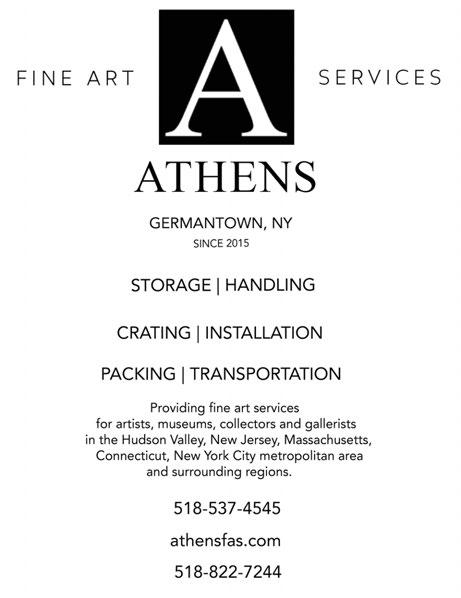






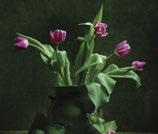




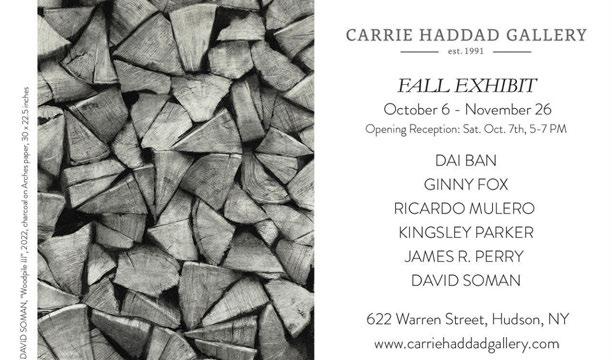





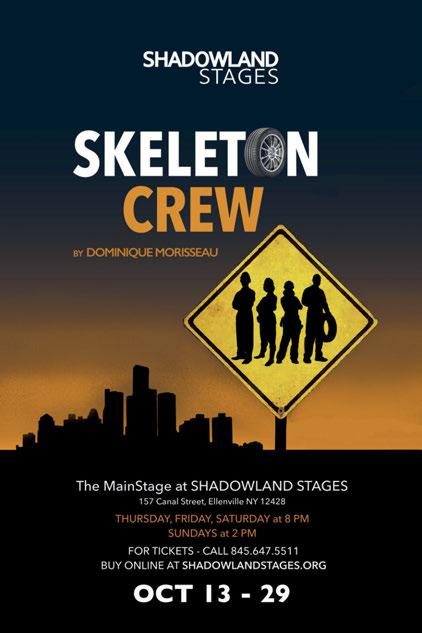























SEPTEMBER 4 HUDSON STREET, KINDERHOOK
“Myth Maker.” Work by Laleh Khorramian. Through October 15.
“Anne Lindberg and Jane Bustin.” October 28-December 17.
SPENCERTOWN ACADEMY ARTS CENTER
790 ROUTE 203, SPENCERTOWN
“Homes, Hamlets & Villages: Style and Lifestyle in Small Towns and Rural Communities.” Group show juried by Carrie Chen, Linden Scheff, and Nelena Soro. Through October 29.
ST. GREGORY’S EPISCOPAL CHURCH
2578 ROUTE 212, WOODSTOCK
“Traditional Iconography.” Saugerties artist Joan Monastero explores the face of the sacred through the art of Eastern Christian iconography. October 1-December 31.
STONE RIDGE LIBRARY
3700 MAIN STREET, STONE RIDGE
“Watercolors: An Eclectic Collection.”
Watercolor illustrations on display and for sale throughout the library. Through October 28, 10am-3pm.
STORM KING ART CENTER
1 MUSEUM ROAD, NEW WINDSOR
Site-specific presentations of new and recent artworks by Beatriz Cortez, Ugo Rondinone, and RA Walden in addition to permanent collection. Through November 13.
SUNY WESTECHESTER CENTER FOR THE DIGITAL ARTS GALLERY
27 N DIVISION STREET, PEEKSKILL
“SUNY Westchester Faculty and Staff Exhibition.” Group show. Through November 27.
SUSAN ELEY FINE ART
433 WARREN STREET, HUDSON
“Fission / Fusion.” Work by Carole Eisner and David L. Bullis. Through October 15.
‘T’ SPACE
137 ROUND LAKE ROAD, RHINEBECK
“Giuliano Fiorenzoli.” Through October 15.
THOMAS COLE NATIONAL HISTORIC SITE
218 SPRING STREET, CATSKILL
“Women Reframe American Landscape: Susie Barstow & Her Circle/Contemporary Practices.”
Female artists of the 19th century exhibited alongside contemporary female artists. Through October 29.
TILLY FOSTER FARM
100 ROUTE 312, BREWSTER
“Tilly Foster Farm Outdoor Sculpture Exhibition.” Group show. Through October 30.
TREMAINE ART GALLERY AT THE HOTCHKISS SCHOOL
11 INTERLAKEN ROAD, LAKEVILLE, CT
“Cicatrix | in Bloom.” Work by Maggie Nowinski. Through October 15.
“Tierra Prometida | Promised Land.” Photography by Lisa Elmaleh. October 28-January 15.
TROLLEY BARN ART CENTER
489 MAIN STREET, POUGHKEEPSIE
“quiet as it’s kept.” Contemporary Black art curated by Trolley Barn Youth Curatorial Team in collaboration with Janice Bond featuring work by Destiny Arianna, Mary Boatey, Harrison Brisbon-McKinnon, Vernon Byron, Steven Cozart, Dellis Frank, Tyrone Geter, Dondre Green, Stella Hendricks, Clarence Heyward, Tylear Jefferson, Imani Jones, London Ladd, Samantha Modder, Ari Montford, Emmanuel Ofori,. Ashley Page, Ransome, Mark A. Reed, Tammie Rubin, Theda Sandiford, Melissa Small Cooper, Raven Smith, Jean-Marc Superville Sovak, Stephen Tyson, and Lisa Diane Wedgeworth. October 6-November 10.
TURN PARK ART SPACE
2 MOSCOW ROAD, STOCKBRIDGE, MA
“It’s Time.” Solar clock installation by Erika Zekos. Through October 31.
“Random Turns.” Drawings and structures by Vladimir Zimakov. Through October 31.
“Still-full-ness.” Sculptures and paintings by Gerald Wolfe. Through October 31.
ULSTER COUNTY
HISTORICAL SOCIETY
2682 ROUTE 209, KINGSTON
“Leaving Bishop Falls: An Ashokan Story.” Paintings, prints, poetry, and historical ephemera of Kate McGloughlin. Through October 29.
UNISON ARTS & LEARNING CENTER
68 MOUNTAIN REST ROAD, NEW PALTZ
“Community Imprint.” Prints by artists fro the Poughkeepsie Underwear Factory and DRAW in Kingston. Through October 7.
VASSAR COLLEGE MAIN LIBRARY
124 RAYMOND AVENUE, POUGHKEEPSIE
“Elizabeth Bishop’s Postcards.” Exhibition of the beloved poet’s extensive postcard correspondence. Through December 15.
VISITOR CENTER
233 LIBERTY STREET, NEWBURGH
“Field Dressings for Lazarus.” Mixed media by Lodger Studio. Through October 6.
“The Dog That Ate the Birthday Cake.” Work by Daniel Giordano and Karlos Carcamo. October 14-December 30.
WEST STRAND ART GALLERY
29 W STRAND ST, KINGSTON
“A Point in Time and Space." Work by Amy Cheng, Isabel Cotarelo, Lydia Rubio, and Julia Santos Solomon. Through October 8. “Intersecting Narratives: Photography, Prints, and Drawings." Work by Fredda Brennan, Sikena Khadija, Joshua Kramb, Pam Krimsky, Eliezer Parrilla, Amy Fenton Shine, Michael A. Torres, and Daniel Venture.
October 14-November 26.
WINDHAM FINE ARTS
5380 MAIN STREET, WINDHAM
"Everything Autumn." Group show. Through October 31.
WIRED GALLERY
11 MOHONK ROAD, HIGH FALLS. “Diversity.” A selection of works by the Women Photographers Collective of the Hudson Valley. Through October 15.
WOMEN’S STUDIO WORKSHOP
722 BINNEWATER LANE, KINGSTON
“in the palm of your hand.” Group exhibition of itty-bitty works of art. Through October 31.
WOODSTOCK ARTISTS ASSOCIATION AND MUSEUM
28 TINKER STREET, WOODSTOCK.
“Behind the Veil.” Group show featuring work by Onaje Benjamin, Gerardo Castro, Dan Goldman, Norm Magnussen, LaLa Montoya, Sandra Morales, Emmanuel Ofori, Shirley Parker-Benjamin, Poet Gold, Christina Siu, Suprina, and Millicent Young. Juried by Klaudia Ofwona Draber. October 13-November 12.
“I am Who You See That I Am.” Paintings by Ransome. October 13-November 12.
WOODSTOCK SCHOOL OF ART
2470 ROUTE 212, WOODSTOCK
“Woodstock Monoprint Invitational Exhibition.”
A survey of monoprints by contemporary artists created in the Thompson Family Foundation/ Alan and Sandy Siegel Graphics and Works-onPaper Studio at the Woodstock School of Art.
Through October 7.
“Grant Arnold and the Golden Era of Woodstock Lithography 1930-1940”. Curated by Bruce Weber. October 14-December 9.
October 16-December 7
God, corporate greed, systemic racism, environmental collapse, false patriotism—the toxic brew that is contemporary American culture—are depicted in these satirical paintings by Gary Horn at Convey/er/or in Poughkeepsie. While offering a pointed commentary on the American experiment, Horn’s investigations also present a call to action to repair a failed utopia.

Through January 28
This exhibition highlights the collection of Spelman College Museum of Fine Arts, which has a mission to uplift art by and about women of the African diaspora. “Silver Linings” shares the works of masters, pioneers, and trailblazers who anchor the Spelman collection. Among the 40 works in the exhibition there are sculptures by Beverly Buchanan, Selma Burke, and Elizabeth Catlett; paintings by Betty Blayton, Sam Gilliam, and Henry Ossawa Tanner; drawings by Herman “Kofi” Bailey, Nellie Mae Rowe, and Charles White; photographs by Amalia Amaki, Carrie Mae Weems, and Lorna Simpson; and mixed-media work by Emma Amos, Benny Andrews, and Romare Bearden.
“Zohar Lazar:
Oh! Sweet Nuthin’”
Through October 30
The work of Great Barrington-based painter and illustrator Zohar Lazar is part Tex Avery mayhem, part spiritual revelation, part carnal obsession. For this show at the Hillman Jackson Gallery at the Daniel Arts Center on the campus of Simon’s Rock, curator Jacob Fossum presents a selection of Lazar’s drawings and paintings that feature his idiosyncratic characters.
October 7-November 11
The Brasiles Arts Collective presents an ambitious six-week avant-garde art exhibition at the Howland Cultural Center in Beacon curated by Brasiles founder, Madeleine DeNitto with her husband, Clayton Scales. The show will include pieces from working artists as far away as Los Angeles and Germany employing a variety of mediums ranging from painting and collage to sculpture and graffiti. In conjunction with the exhibition, there will be a series of performances, from poerty readings to dance performances.

 By Cory Nakasue
By Cory Nakasue


The eclipses in the signs of Libra and Taurus are the main event of October. These two lunations set the stage for eclipse season: a time of unexpected shifts and adjustments that bring us into alignment with the parts of ourselves and our lives we have strayed from. Eclipses are like portals or wormholes that can fast-track us to pivotal opportunities and realizations. They can unstick the most stubborn situations and course-correct a trajectory not suited for us.
The first eclipse of the season is a solar (new Moon) eclipse in the sign of Libra on October 14. We can expect major changes in our attitudes towards relationships of all kinds. Most importantly, we’ll examine our own people-pleasing patterns and assumptions about safety-in-numbers. The symbol for Libra is the scales, and chances are that they will tip dramatically this month. Wherever we have been unconsciously keeping things peaceful at the expense of doing what is right for us will be magnified. We may find the courage to do the unpopular or extreme thing in order to bring about balance in a larger context.
The second eclipse of the season is a lunar (full Moon) eclipse in the sign of Taurus on October 28. The fall season is a time of shedding, purging, and the beauty of decay, but this lunation reminds us to embody these transformations as regenerative practice. How can we willingly enter the realms of death so that we may fully appreciate life? How can we honor loss, so that we may fully revel in our abundance? We’ll be shown how well we’ve been managing the art of circulation. Both of these lunations are ruled by Venus, which is currently in Virgo, making October a critical month of refining the health of our relationships, our bodies, and our environment.
ARIES (March 20–April 19)
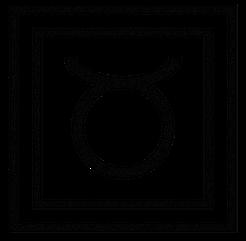

The true test of your independence will be your ability to maintain your connections with others. It’s easy to be who you are and do what you want when you’re alone, but can you do that while in relationship? This month’s eclipse in Libra will test your allegiance to yourself and strengthen your ability to express yourself fully in the face of possible rejection. Why are you so sure other people won’t receive you? The biggest lesson you’ll learn is that when you do the work of staying in relationships as your authentic self, you’re benefiting as an individual.
TAURUS (April 19–May 20)
While it’s true that your body and the earth are solid, tangible, material things, they can also be penetrated, transformed, and infused. Does that make you uncomfortable? What if the purpose of your strong, solid being was to hold the ephemeral forces of feeling, energy, and imagination? What if your job was to be the best vessel you can be for such things? The most powerful emotions cannot break you if you allow them to change you. You will always be sturdy, but at this month’s lunar eclipse, allow your shape to be changed by forces beyond your control.
GEMINI (May 20–June 21)


There’s a dark, unacknowledged corner in the psyche of every lighthearted, go-with-the-flow set of Gemini twins that is obstinate and controlling. This part of them might also be a mystery to themselves. With Uranus, Jupiter, and a lunar eclipse occupying this “hidden house” of the natal chart, needs for stability and possessiveness might bubble up without warning. Acknowledge and address these new feelings. They are real and emanating from your body. It is time to make better friends with the material world and build a new relationship with your flesh. Deepening your sense of consistency only amplifies your more dexterous talents.


CANCER (June 21–July 22)


A new code of conduct is needed for the whole family. Sometimes an aggressive break with the past can restore balance at home and with your kin. This will take lots of conversation and, possibly, a re-writing of the rules in the form of contracts, vows, or mission statements. There are indications that you may need to reevaluate your requirements for peace, order, and collaboration. How can you organize your most personal spaces and relationships to nourish new values and a growing need for independence? Harmony at home fuels your more extroverted ambitions. Some alone time wouldn’t hurt either.
LEO (July 22–August 23)

You’re making a name for yourself as someone whose authority and dependability can be trusted. You may even be on the receiving end of “cash and prizes” for your consistency. What will you do with your hard-won spoils? Lavish yourself with the best that money can buy? Go on a decadent bender? Spend the weekend in bed? I have a better idea: invest. Put any rewards or surplus back into your home, education, or business. You’re being encouraged to recycle your resources and make some secret, savvy moves to ensure your security. Keep a small portion back to buy yourself something pretty.
VIRGO (August 23–September 23)

With Venus finally entering your sign after five months of hanging out on your front porch, you’re breathing a sigh of relief. You may have spent the summer wondering where your sweetness, joie de vivre, and money went. As Venus crosses your ascendant (or Sun) on October 8, treat yourself with something wholesome and nourishing. Get a new haircut or outfit. Spend the whole day foraging herbs and picking flowers. Have a manual therapist address the knots in your shoulders. This past summer was a deep dive for your soul. Autumn is a restoration of your body.
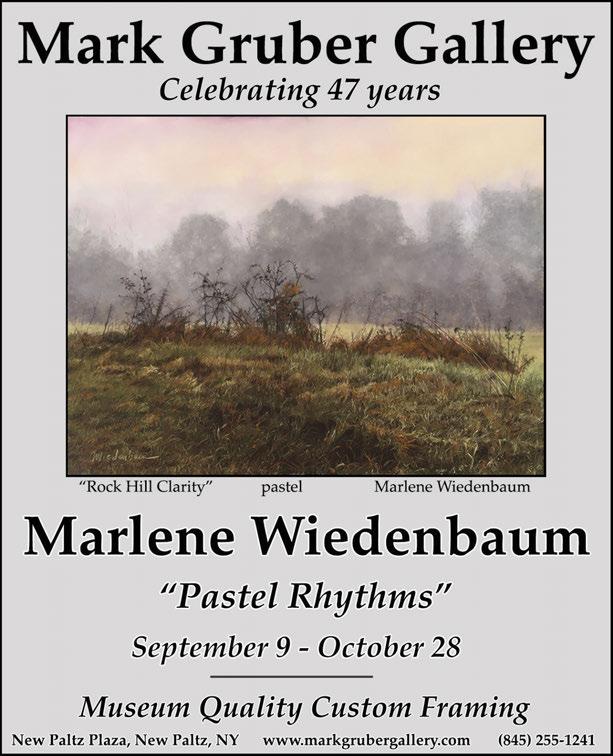
LIBRA (September 23–October 23)

This first Libra eclipse in the 18-month Aries-Libra series will bring attention to your relationship patterns and begin a process of transforming them. What are the rules you set up for yourself when connecting with others, and are they still necessary? You may find that you’re more restless and impatient with others and desire more independence than usual. This would be a good time to take on a leadership role, or develop trust in your gut instincts. Stories from past relationships may crop up in your consciousness to be analyzed. What needs to be changed, challenged, or deepened?


SCORPIO (October 23–November 22)






It is crucial that you say what you mean and mean what you say. If you’re tempted to enhance, bend, or otherwise skirt the truth of what’s in your heart of hearts, it will reek of insincerity. Your friends and colleagues are watching you with a very discerning eye. The good news is that if you dare to express yourself without hedging, you’re likely to get the support you need to move through the world exactly as you desire. This takes courage, and most of all, trust in yourself. Transparency can be difficult for Scorpio, but right now it’s so worth it!
SAGITTARIUS (November 22–December 22)



You’re doing the delicate work of figuring out how to fit your fiery beliefs and grand visions into a practical system. At the moment, it may feel like the world, as it is, is too small to contain all the possibilities you’d like to make realities. You’re about to learn some hard and valuable lessons in the art of editing and distillation. You may have to “kill your darlings,” as it were, to manifest the dream that burns brightest, but this is a necessary step in becoming an artisan. Finding a purpose for your passion is ultimately healing as well.
CAPRICORN (December 22–January 20)
The autumnal equinox and the full Moon that follows is a pivotal time for you. It looks like there are many deals to be made and that you’re feeling confident. Your equinox chart reminds me of the 1987 film Wall Street, directed by Oliver Stone. It’s ambitious, full of social prowess and the ability to source hidden information. And it looks like you’re having fun to boot! Whatever it is you’re after, it looks like you’ll get it. It’s possible that feeling your desires so thoroughly is enough. Watch that they don’t consume you. Stay close to the fire without getting burned.
AQUARIUS (January 20–February 19)


October 5, 5:00–7:30pm West Kill Supply, Kingston Chronogram.com/LaunchParty
Join the Chronogram Media staff at West Kill Supply in Kingston to celebrate the October 2023 issue of Chronogram. Enjoy a special deal on draft beers. RSVP

Of all the signs, Aquarius is going through the most disintegration and transformation. While it might be difficult to feel your edges right now, it’s prime time for merging with your environment and other people. Your current, incredibly porous state of being is a blessing. While finding a material form might be hard, you have amazing access to the kernel of truth about something. While uncomfortable, you’d be remiss to not take advantage of the wisdom contained in your heart. Who needs outward definition with such a strong core? Who needs the ground beneath their feet when they’re a sky god?
PISCES (February 20–March 19)
SPONSORED BY
A lot of us grew up with the idea that perfect clarity around a situation is something we should strive for. Sometimes, it’s so tempting to just pick a rocksolid interpretation of something, and then be on our merry way. Neat and concise explanations of complex circumstances and feelings seldom reflect the truth of life. You’re being asked to think critically this month, but also understand that “either-or” types of determinations are a good sign that you’re not thinking critically. Investigate the spaces in between the obvious fragments of what you’re being presented with. If others offer you two possibilities, find a third.



Our advertisements are a catalog of distinctive local experiences. Please support the fantastic businesses that make Chronogram possible.





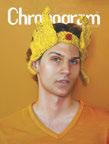

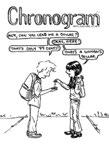











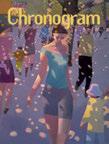








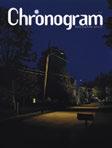











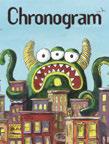

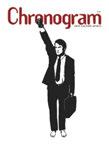

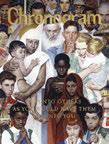






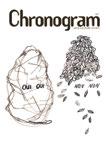



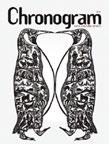




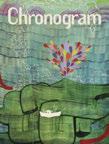












To celebrate Chronogram’s 30th anniversary, we are exhibiting all 358 covers of the magazine at Time and Space Limited in Hudson, from October 15 to November 12. Since we launched, in the fall of 1993, Chronogram has featured the work of hundreds of Hudson Valley artists on its cover, from relative unknowns to celebrated masters like Martin Puryear. Chronogram does not put anything but its logo on the cover, allowing artists an unadorned canvas for their work. Some of the artists featured include Peter Max, Kathy Ruttenberg, John Cuneo,
Dion Ogust, Alex Grey, Emil Alzamora, Richard Butler, Carolita Johnson, Randall Roberts, Laura Levine, Joe Concra, Devorah Sperber, Jeffrey Milstein, and Spencer Tunick, among many others. Each cover represents the artistic vitality of the Hudson Valley— and it is our pleasure to serve the creative community that thrives here.
“Cover Story: 30 Years of Chronogram” will be exhibited at Time and Space Limited in Hudson October 15-November 12. An opening reception will be held on Sunday, October 15 from 3-5pm.





Reserve
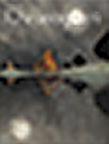

Sponsored by:

